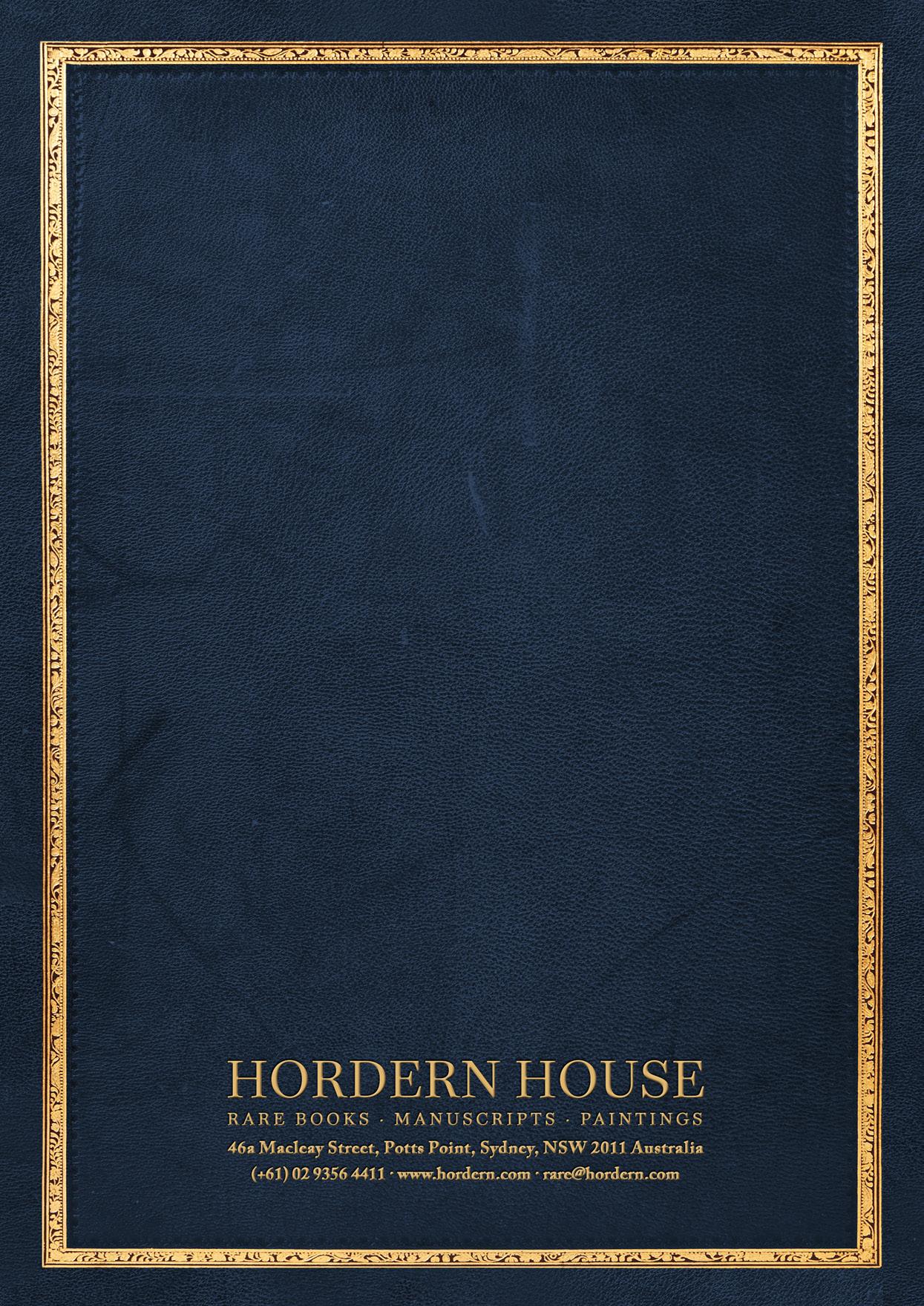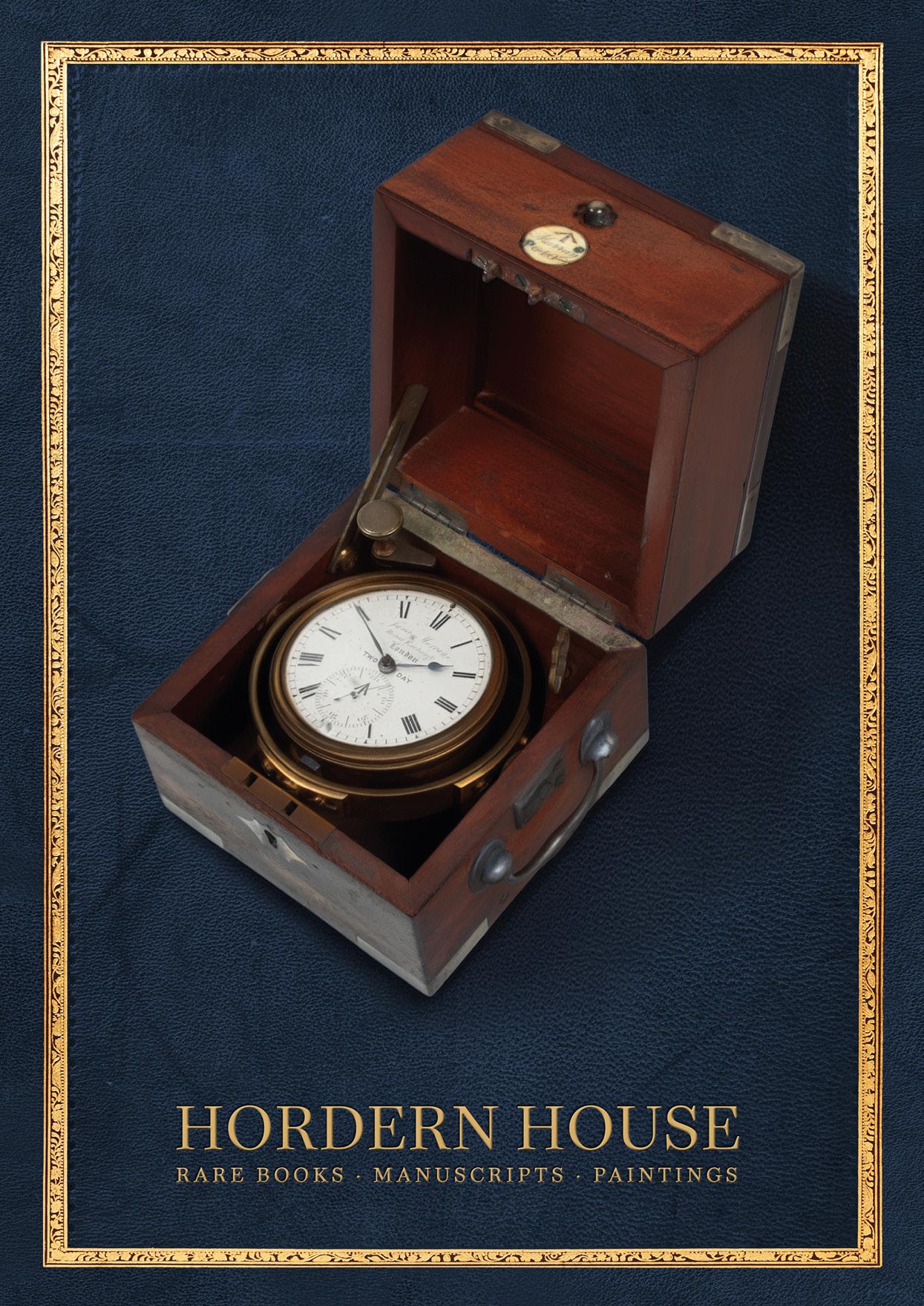
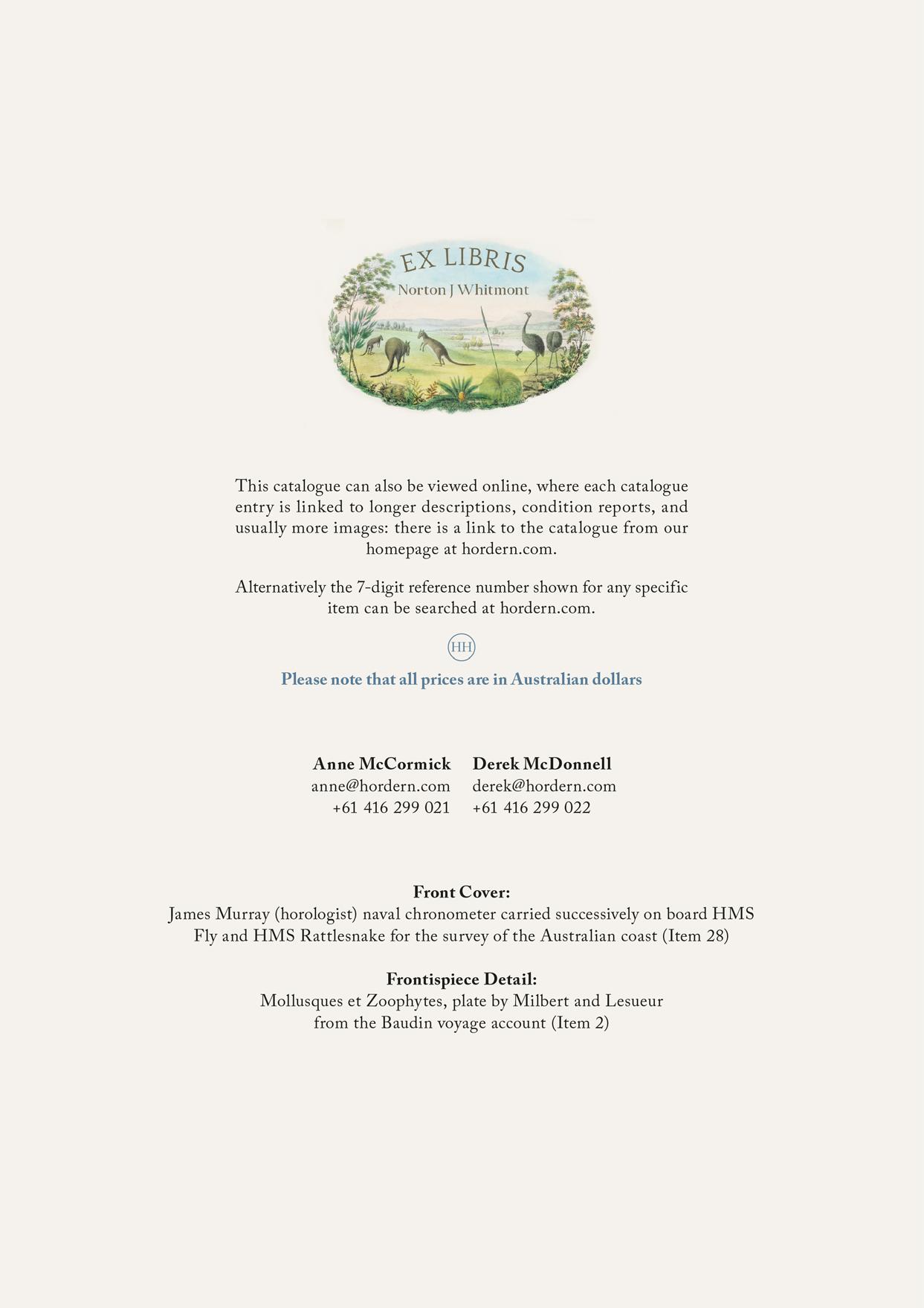
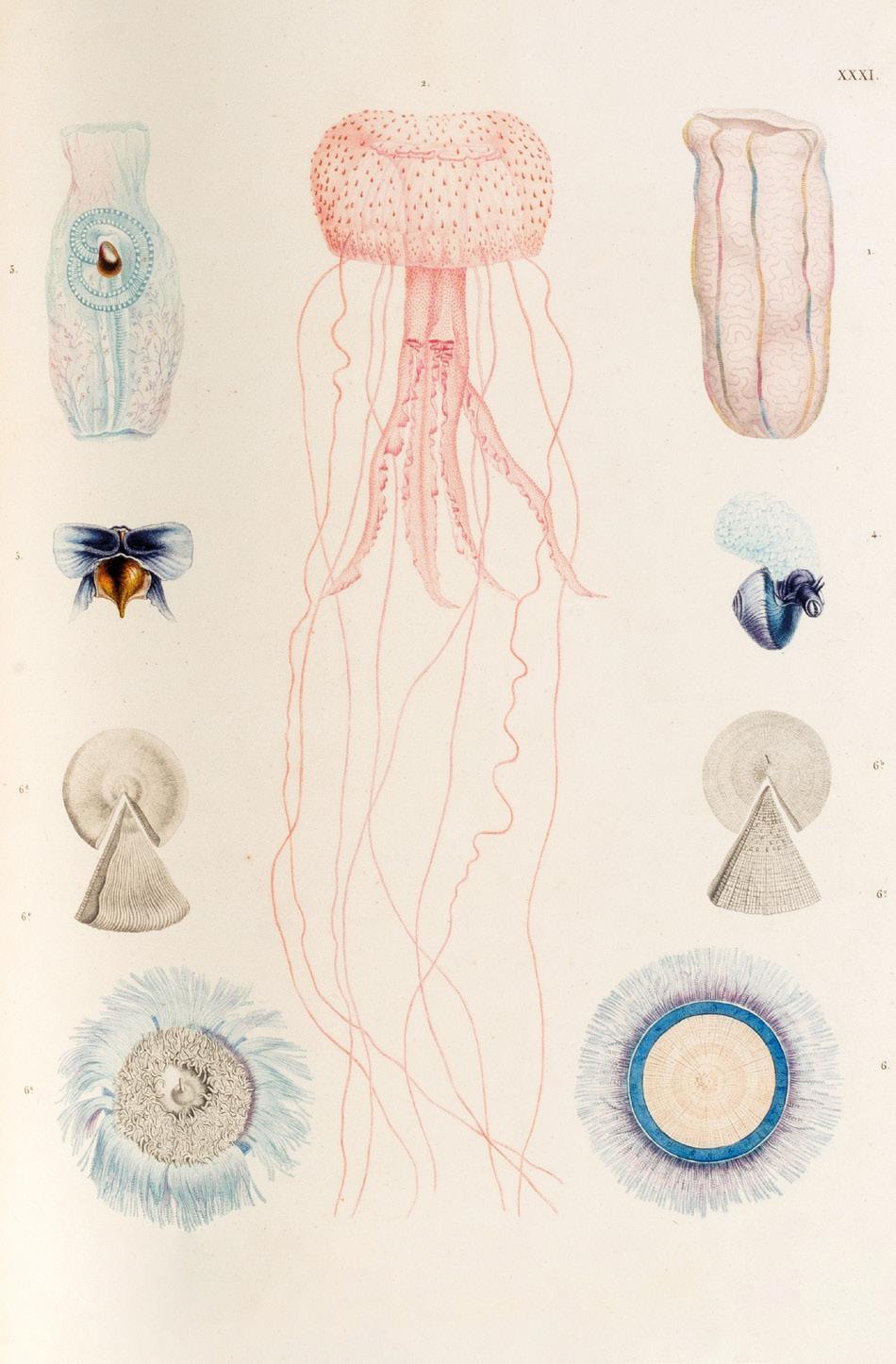

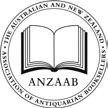










Hordern House is honoured to issue another catalogue, the second to date, of rare and important items from a significant private library. The collection, assembled by a prominent Sydney family over three generations, represents eighty years of gradual accumulation, bringing together a rich and noteworthy library, tracing the early European history of our country and the entire region.
As will have been seen from the first catalogue issued earlier in the year, the collection is a treasure trove of original Australian and Pacific material. Much of its contents have not been seen in decades, and several important pieces are being offered publicly for the first time.
Some of the highlights now described include fine sets of a number of important voyage accounts:
• the splendid official publication of the tragic La Pérouse voyage (no. 25);
• a fine and complete example of the full publication of the Baudin voyage (no. 2), the contemporary rival to
• Matthew Flinders’s circumnavigation of Australia (no. 16); and
• Vancouver’s voyages in the Pacific, to Hawaii and along the west Australian coast (no. 40); these all preceded by
• the official account of Cook’s Endeavour voyage (no. 13).
Descriptions of the Australian First Fleet include:
• a superb copy of the first authentic account to be published, Watkin Tench’s Narrative of the Expedition to Botany Bay (1789, no. 38);
• Tench’s second book ( A Complete Account, 1793, no. 39); as well as
• the classic original works by Hunter (no. 21) and Collins (no. 12).
Isaac Smith, the first man to step ashore at Botany Bay from the First Fleet, is represented by the poignant mourning ring arranged in his will (no. 36), as well as a letter written by him from James Cook’s widow’s house at Clapham (no. 35).
Notable manuscripts in the catalogue include:
• the original manuscript warrant for George Johnston’s court-martial (no. 22);
• a highly important original autograph letter by Governor William Bligh to Captain John Piper, approving the evacuation of Norfolk Island (no. 3);
• Louis de Freycinet’s eye-witness account of the Uranie ’s visit to Port Louis in Mauritius (no. 19); and
• a 1792 original land grant by Governor Phillip, only the second ever made in the new colony (no. 32).
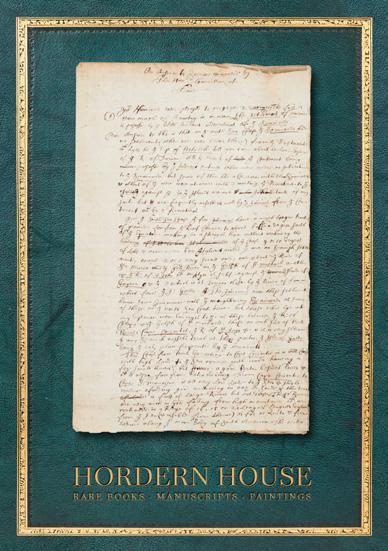
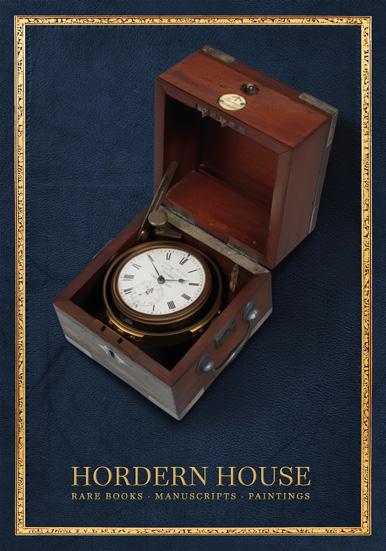
Of especial note is the extraordinary unpublished “A Proposal for an Attempt to discover more fully the great Southern Continent” (1764, no. 37). This important and early original manuscript plan to explore the Pacific and settle the Australian mainland with a Naval Squadron in the 1760s is the centrepiece of a strictly contemporary compendium, where it is backed up with notes of navigational details for the East Indies and China, and the dangers – and rewards – of the Indian Ocean.
In date, the Proposal coincides with, but is markedly distinct from, two other significant works published in the same period: Campbell’s revision in two huge volumes of Harris’s classic collection of voyages (the 1764 edition, no. 20), and the famous three-volume collection of voyages put together by Callander (1766-1768, no. 10), which approaches a similar idea from a different standpoint to that taken by the author of the Proposal.
The Proposal adds a completely different aspect to the more familiar stand taken by the two printed works, and adds greatly to our understanding of the theory and actual knowledge that would quickly lead to the Endeavour voyage, some six years later, and ultimately to the First Fleet.
The contents of the collection present a unique opportunity for collectors, historians, and institutions to acquire materials of immense importance.
This is the second of the three catalogues currently planned. Our third catalogue will be issued in the first half of 2026.
Hordern House, Sydney
ANSON, George. WALTER, Richard and Benjamin ROBINS, editors.
By
George Anson, Esq; Commander in Chief of a Squadron of His Majesty’s Ships, sent upon an Expedition to the South-Seas… Compiled from papers and other materials of the Right Honourable George Lord Anson, and published under his direction, by Richard Walter, M.A.
Thick quarto, with 42 folding engraved plates and maps; contemporary mottled calf, the label on spine replaced at some time, a very good copy.
London, Printed for the Author by John and Paul Knapton, 1748.
First edition of Anson’s Voyage, one of the great publishing successes of the eighteenth century; few copies have survived in such good condition. The narrative, based on Anson’s own journal, had an enormous popular success: for the mid-eighteenth-century reader, it was the epitome of adventure, and it was translated into several European languages and stayed in print through numerous editions for many years. Published almost midway between the voyages of Dampier and Cook it is a benchmark of British ambitions in the Pacific at mid-century.
“Anson’s voyage of 1740-44 holds a unique and terrible place in British maritime history. The misadventures of this attempt by Royal Navy ships to sail round the world make a dramatic story of hardship, disaster, mutiny and endurance… [When] Anson reached the coast of China in November 1742 he was left with one ship and a handful of men, some of whom had ‘turned mad and idiots’.
“The most extraordinary part of the voyage was still to come, for despite his losses Anson was determined to seize the treasure galleon that made the annual voyage from Acapulco to Manila. Laden with Peruvian silver, she was the ‘Prize of all the Oceans’. In June 1743 Anson intercepted the Nuestra Señora de Covadonga, and in a 90-minute action forced her surrender. After refitting at Canton he returned home the next year to find himself compared with Drake, and his exploits with the longremembered feats of arms against the Spain of Philip II.
“The casualties were forgotten as the public celebrated a rare triumph in a drab and interminable war…, and in 1748 the long-awaited authorised account appeared under the name of Richard Walter, chaplain on the Centurion, and became a best-seller. Walter’s volume has formed the basis of all accounts of Anson’s voyage from the mideighteenth century to the present. The book, more fully illustrated than any similar work up to that time, was both a stirring story of adventure at sea and an exhortation to further Pacific enterprise” (Glyn Williams, The prize of all the oceans. The triumph and tragedy of Anson’s voyage round the world , 1999).
Provenance: With the early signature of James Whitehall; later bookplate of Athol H. Lewis. $7250
5001000 at hordern.com
Borba de Moraes, I, 32; Hill, 1817; Kroepelien, 1086; Sabin, 1625; Wantrup, ARB (2025), 11.11.
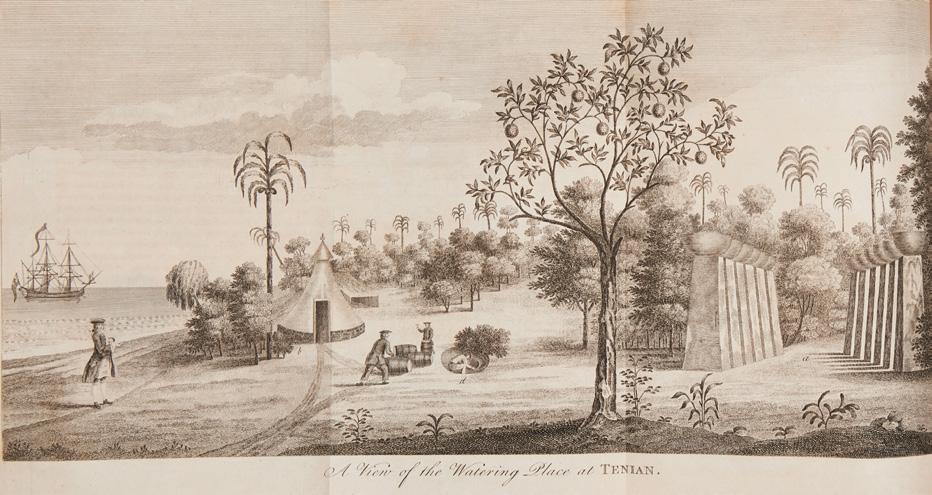
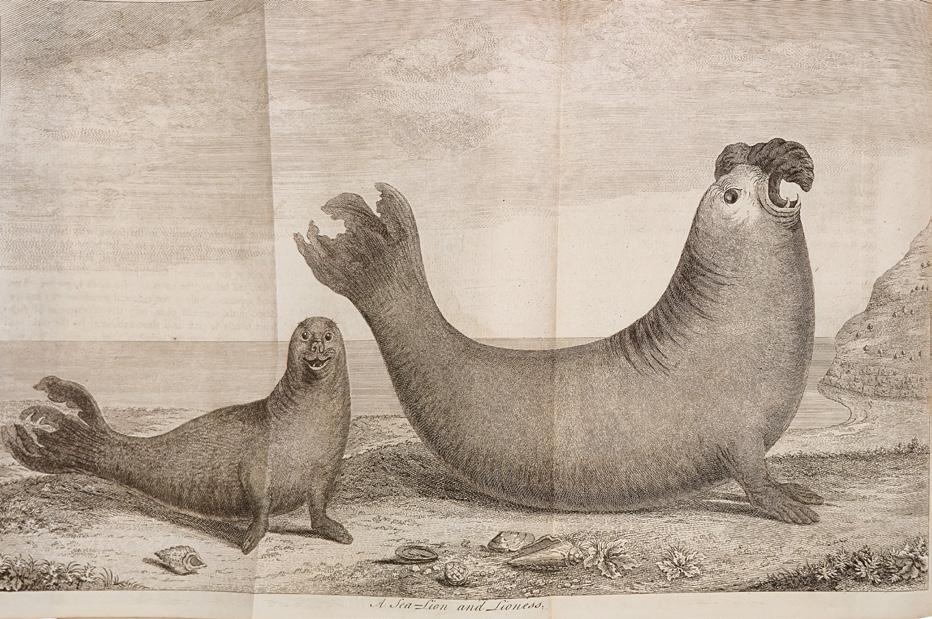
Voyage de Découvertes aux Terres Australes… sur les corvettes
Le Géographe, Le Naturaliste, et la goélette Le Casuarina, pendant les années 1800, 1801, 1802, 1803 et 1804. [with]
Voyage de Découvertes aux Terres Australes…. Navigation et Géographie.
Altogether three volumes quarto, text, and two atlases, large quarto and folio; text with portrait frontispiece and two folding tables; the two-part large quarto atlas bound in one volume, containing altogether 40 plates (23 coloured and two folding) and 14 maps (two double-page and folding); “Navigation” folio atlas dated 1812, containing engraved title, leaf of contents, and 32 finely engraved charts; uniform quarter calf over earlier bindings of original sprinkled or speckled boards. Paris, Imprimerie Impériale [Royale], 1807-1816.
A good complete set of the great French voyage of the Napoleonic period, the ambitious voyage to the “terres Australes ” under Baudin, chronicled by its participants Louis de Freycinet (later to command his own voyage) and the scientist François Péron. Rare in any sense, sets of the voyage are more commonly seen with only the narrative account, but this is the much rarer full work, complete with an extra volume of text and the magnificent folio atlas of Australian maps.
Sent out in 1800, in the first year of Napoleon’s consulate, Baudin’s own ship only returned to France in March of 1804, just two months before the Senate’s proclamation of Napoleon as Emperor. Live specimens from the “terres Australes ” went directly to Joséphine and Napoleon’s château at Malmaison on the outskirts of Paris, where kangaroos, emus and black swans would make their unlikely home in the imperial parkland under young gum and wattle trees brought back by the explorers. The vignette on the title-page of this voyage account [illustrated catalogue p. 9] memorialises this extraordinary scene and has since become one of the most famous images of the entire era.
Indeed, the whole suite of images, mostly after drawings made on the spot by the expedition’s two most important artists Charles-Alexandre Lesueur and NicolasMartin Petit, are among the most beautiful ever published, especially in their depiction of indigenous Australians, including striking portraits of men and women from the east coast of Tasmania and from around the settlement in Sydney. Petit’s portraits are recognised as some of the most important such works ever committed to paper.
Baudin’s instructions had included specific orders to complete the cartographic survey of the Australian coast, the atlas including the justly famous charting of Tasmania and Bass Strait from observations made in 1802-3, great and detailed stretches of the western Australian coast, as well as the long stretch of the south-east that they christened the “Terre Napoléon,” this last famously encompassing much of modern Victoria right through to Encounter Bay, the anchorage where they parleyed with Matthew Flinders on his own Investigator voyage. With Flinders’s subsequent imprisonment by the French in Mauritius, Baudin’s great Hydrographical Atlas – as present in this set – therefore appeared in 1812, two years before the publication of Flinders’ narrative and chart. It is thus the first full Australian atlas.
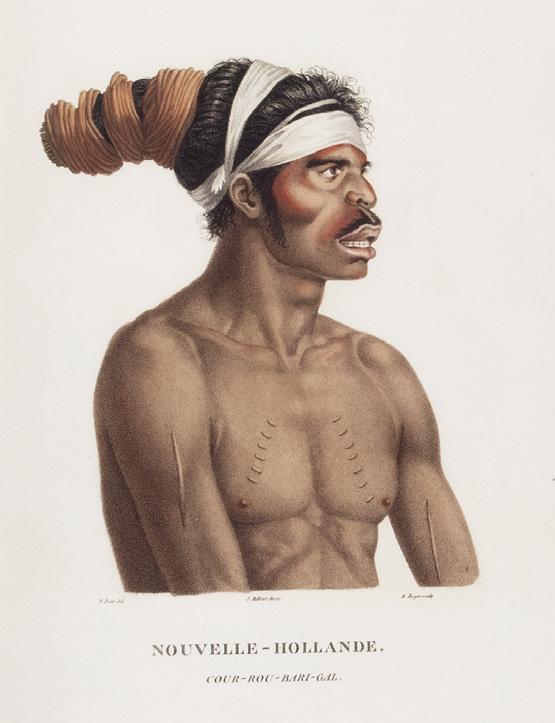
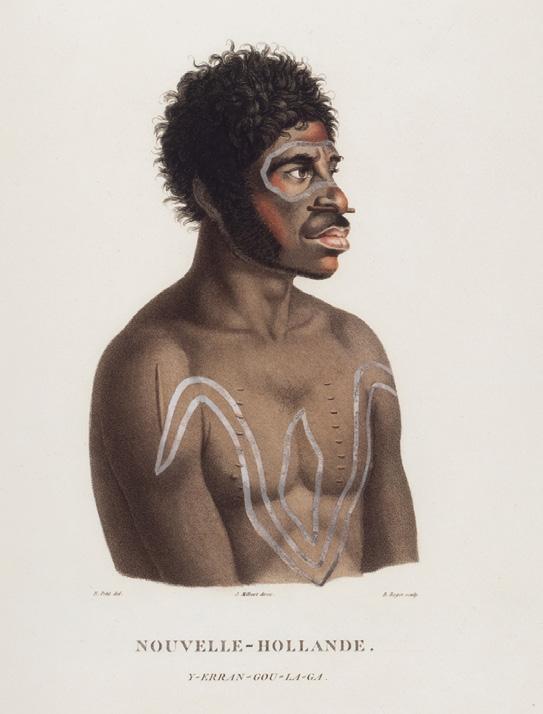
The official account of the Baudin voyage appeared over ten years, in two quite distinct sections. This is the full set with both sections together in matching bindings: the official narrative of the voyage (usually seen on its own and sometimes referred to as the “general reader’s edition”), published between 1807 and 1816 as two volumes of text and a small folio atlas in two parts (including some charting, chiefly of specific ports, and the famous views and portraits of native peoples). The second part, which was quite separately published and actually distributed by a different bookseller, published between 1812 and 1815, is the much rarer Hydrography of the voyage with its large-scale coastal mapping of Australia appearing as an imperial folio atlas accompanied by the volume of text.
Baudin’s two ships, the Géographe and the Naturaliste, left Le Havre on 19 October 1800 and reached Mauritius six months later, but shipboard quarrels and illness caused a mass defection of scientists and sailors. Having rejigged his crew, Baudin set sail for New Holland, sighting Cape Leeuwin on 27 May and anchoring in Geographe Bay three days later. He sailed north and examined Rottnest Island and Swan River, but the two ships became separated on 11 June. The Géographe finally anchored at Shark Bay on 27 June, but had left by the time the Naturaliste arrived. The latter vessel stayed on in Shark Bay to make an extensive survey – including the discovery of the Vlamingh plate – while Baudin and the Géographe worked along the difficult coast past the North West Cape. The two ships ultimately arrived in Timor in August and September; tropical diseases were already causing deaths among the crew.
In November they sailed south for Cape Leeuwin where Baudin headed for Tasmania, making the D’Entrecasteaux Channel in early January. Hamelin on the Naturaliste crossed Bass Strait and made a survey of Western Port before running for Port Jackson. Meanwhile Baudin began his survey of “Terre Napoleon”, meeting Matthew Flinders at Encounter Bay in April. Worn out, Baudin turned for Sydney, but chose to again round the southern tip of Tasmania, meaning that he did not arrive off Port Jackson until 17 June, his crew severely weakened by scurvy.
Hamelin had actually already headed out to search for Baudin in Bass Strait, but the combination of a storm and poor provisions saw him back in Sydney a few days later, and the two ships stayed in Sydney until November. Warmly and hospitably entertained by Governor King, the French spent their time recuperating and making sense of their collections.
In Sydney Baudin purchased the small Casuarina , placing the relatively young officer Louis de Freycinet in charge. The Géographe and the Casuarina made close surveys of King Island, Kangaroo Island and the Gulf of St Vincent (“Golfe Joséphine ”), before continuing to King George’s Sound in western Australia, whence they returned to Shark Bay and the northwest before finally reaching Timor on 7 May 1803. They made a quick return visit to the northwest coast of Australia – their third – and reached Mauritius in July, where Baudin died on 19 September.
$110,000 5001011 at hordern.com
Chadenat, 148; Davidson, Book Collector’s Notes, pp.108-10; Dunmore, French Explorers in the Pacific II, pp.9-40; Ferguson, 449, 536, 603; Hill, 1329 (Historique only); Mabberley, Peter Crossing Collection, 73; Plomley, The Baudin Expedition and the Tasmanian Aborigines 1802; Sharp, Discovery of Australia, pp.232-39; Wantrup, 78a, 79a, 80a, 81.
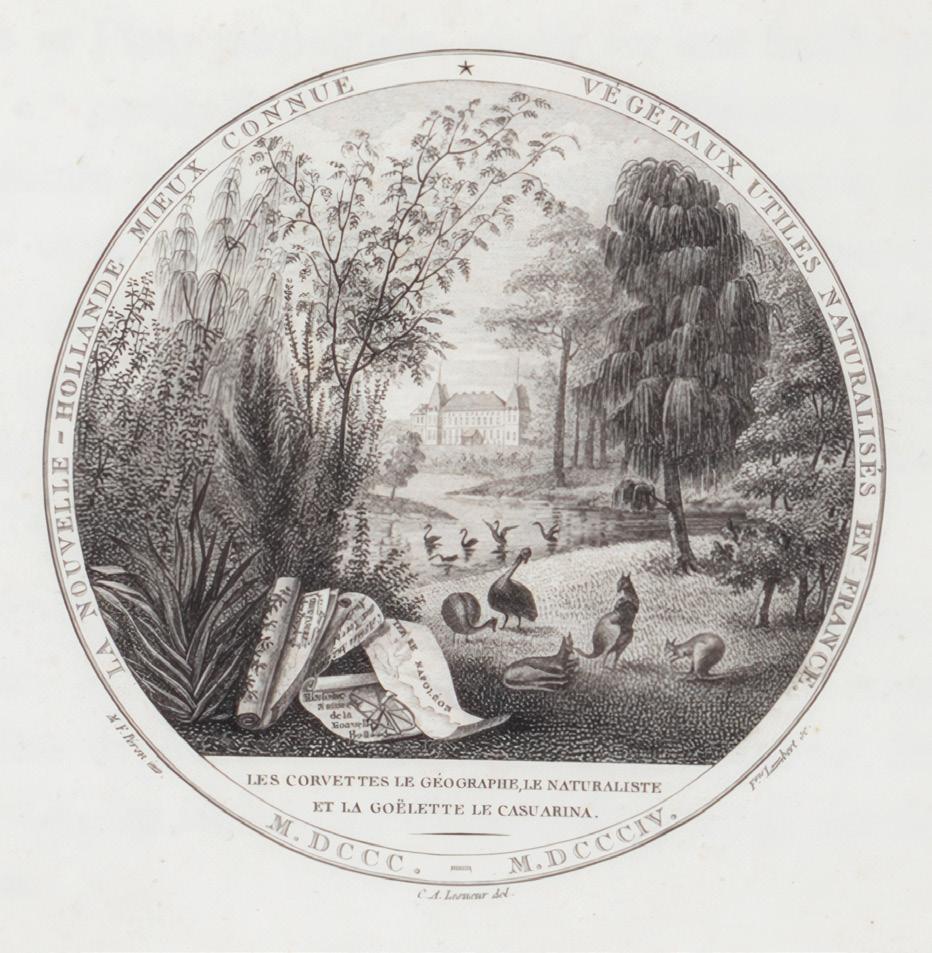
Autograph letter signed, to Captain John Piper, Commandant at Norfolk Island.
Folio, ink on paper, with integral address leaf (“On His Majesty s Service/Captain Piper/ Commandant at Norfolk Island/By Aurora, Capt. Myrric”); in excellent original condition.
Government House Sydney, 12 October 1807.
An historically important and very rare letter, one of the fullest and most significant of Bligh’s manuscripts remaining in private hands. This substantial letter, boldly signed from Government House “Wm. Bligh” in October 1807, when Bligh was already teetering on the precipice (the Rum Rebellion would crash over him just three months later), gives a rare insight into this significant moment of colonial history. In our experience even Bligh signatures are now notably rare, but full letters, especially relating to his career in Australia, are seen only very occasionally. This is the finest full Bligh letter we have handled in more than forty years.
The letter is addressed to one of the Bligh loyalists, John Piper, serving since 1804 as the acting commandant of Norfolk Island. It had fallen to Piper to organize the British government’s closing of the penal settlement, which was being shuttered due to the high cost of maintaining the outpost, a process which had formally begun in 1805. The situation was still delicately balanced two years later, with many refusing to leave, meaning that Piper had written to Sydney for official approval of his most recent actions.
Here, Bligh notes that he has just had Piper’s most recent letter delivered by the Lady Nelson and that while he planned to write a fuller reply via the same ship shortly, the matter is of such urgency that he is writing this initial draft of his ideas to be sent ahead on board the whaler Aurora , Captain Myrric (sometimes ‘Meyrick’ or even ‘Merritt’ in other papers of the era).
Piper must have been relieved to have this speedy and positive response from Bligh: “I approve generally of the arrangement & sincerely think it is the best thing that could happen for the settlers. You must do your best to prevent any improper correspondence.” In November most of the inhabitants were transferred to Sydney on the Porpoise, Lady Nelson and Estramina.
The letter also includes other important information relating to the impending voyages of the Porpoise and Estramina for the Derwent and Port Dalrymple, not least as Bligh hoped that one or other of them would sail directly to Norfolk Island on their return. Also noted by Bligh is the fact that “many demands for salt pork are going to your Island by shipping therefore take care to secure government in that article & what belongs to our security in the evacuation.” Bligh’s mention of the Porpoise has a certain poignancy as it was the vessel on which he would be effectively imprisoned after he left Sydney in February 1809, loitering on the Derwent and generally pestering David Collins.
$95,000
5001019 at hordern.com
ADB; HRA; Trove.

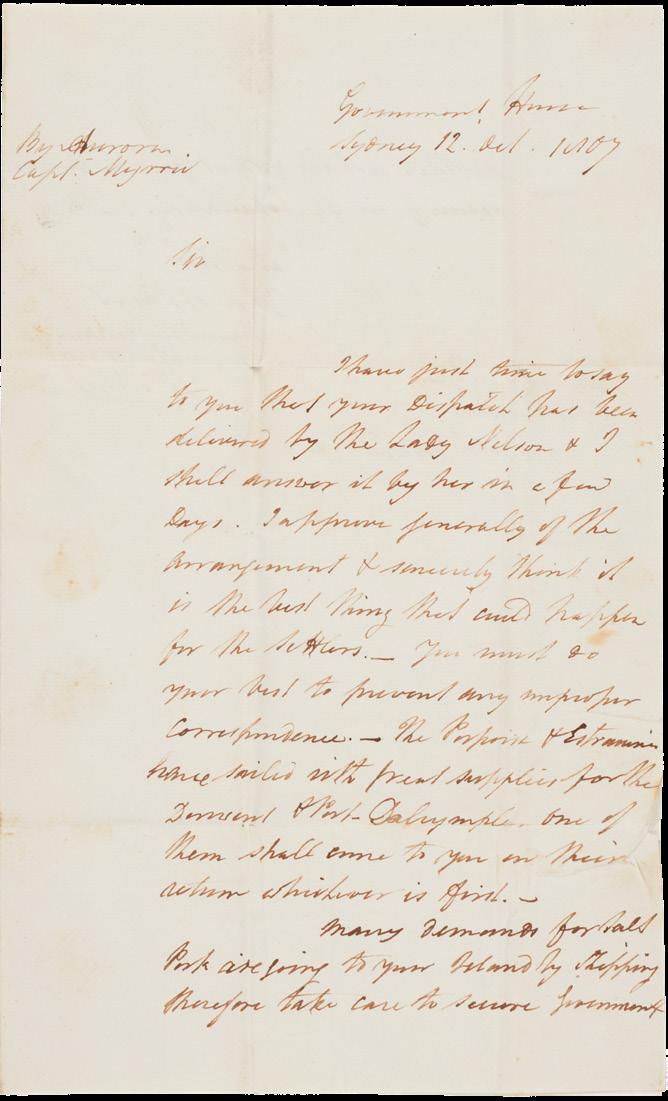
A substantial collection of original manuscripts accompanied by supporting documentation.
Large archive comprising a substantial quantity of manuscripts, including papers, a will, a silhouette, photographs and locks of hair; organised and stored in two specially made half morocco boxes. Various places, from circa 1790.
An important and unpublished archive of papers relating to the career of Francis Godolphin Bond RN (1765-1839), nephew to William Bligh, distinguished sailor and First Lieutenant to Bligh on the Second Breadfruit Voyage on HMS Providence
A major family archive, it includes the full consecutive series of his commissions as Lieutenant from 1782 through 1797, including his 1791 commission to HMS Providence ; numerous family letters including one from his sister-in-law Mary welcoming him home on his return in 1793; probate for his 1839 will; legal documents relating to his inheritance (with Bligh) of the Thorne estate; various memorabilia including a photograph of Sophia, surely one of very few photographs that could exist of someone connected with Bligh; and a silhouette believed to be that of Bond himself (although it shows some differences with the silhouette reproduced by Mackaness).
Although Bond served with active distinction, finishing his career as a Rear-Admiral, it is because of his affiliation with Bligh (in particular a suite of extant letters relating to the voyage of HMS Providence) that he is mainly remembered. Bligh actively requested that Bond be assigned to him on the Second Breadfruit Voyage, and lobbied unsuccessfully for Bond’s advancement on his return. His famously terse but admiring comment about Bond was the succinct “a very active and Zealous officer and is much liked by every person who knows him”. Bond was not quite as complimentary about his captain, writing in 1792 that “our relation had the credit of being a tyrant in his last expedition… the chief part of his conduct must have arisen from the fury of an ungovernable temper”. Bligh named a section of the Barrier Reef “Bond’s Reef”, and regularly mentions Bond in his logbooks.
This archive gives a wonderful picture of Bond from youth to old age, affording a surprisingly thorough portrait of this important figure’s life and career. The contents were studied by George Mackaness, and the archive includes some correspondence between him and Sir Lionel Bond (1884-1961), a senior officer in the British army who was studying his family’s genealogy. Mackaness wrote the standard work on Bond, making use of original letters: “Some Correspondence of Captain William Bligh, R.N., with John and Francis Godolphin Bond 1776-1811”, (1949), and used Bond manuscripts for his “Fresh light on Bligh being some unpublished correspondence of Captain William Bligh, R.N. and Lieutenant Francis Godolphin Bond, R.N. with Lieutenant Bond’s manuscript notes made on the voyage of H.M.S. ‘Providence’ 1791-1795”, (1953).
A schedule of the very substantial contents of the archive is available on request.
$45,000
5001024 at hordern.com

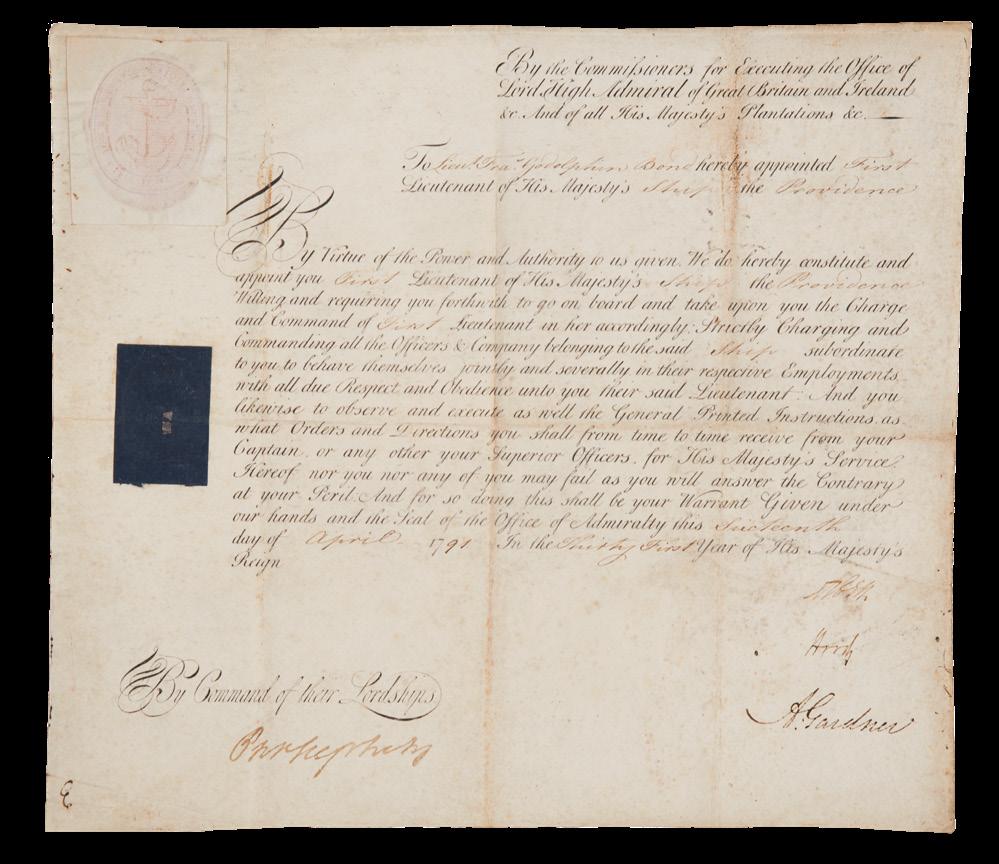
of the Borrowdale.
“Success to the Borrowdale” fob-seal with monogrammed initials “H.R.” for Master Hobson Reed.
Silver fob-seal, 44 x 30 mm., ornate scroll-work suspension loop above an oval swivel seal with, on the obverse, an engraved depiction of a three-masted vessel and the caption “Success to the Borrowdale”, on the reverse, the monogram “H.R.”, the whole decorated with leaves and sprig borders to the edges and rim; very fine.
Sunderland?, no maker’s mark, circa 1786.
A moving, handsomely-wrought relic of the commander of the First Fleet transport Borrowdale : this is the fob seal he would have carried on board with, on one side, a neatly engraved depiction of the ship and, on the reverse, his monogrammed initials “H.R.” (for Hobson Reed). One of only a handful of extant personal items known to have belonged to a First Fleeter, the depiction of the Borrowdale itself, one of the most elusive of the First Fleet vessels, is particularly significant.
Under Reed’s command the Borrowdale made the voyage to Botany Bay without any undue alarm, and although there were several fatalities among the crew on the difficult return voyage, necessitating a brief stay in Rio while many on board recuperated, the ship was in fact one of the first two vessels to return to England in March 1789. Two very rare printed items relate specifically to the voyage, the first a broadside in the Mitchell Library by one of the crew Richard Williams, the second a poetic elegy for Reed himself.
A little is known about Reed personally, an urbane and professional sea-captain, strongly suggesting that this would have been a gift from his immediate circle as a charm for the voyage, perhaps from the owners of the ship, or his family and friends. Well-crafted, it gives a good representation of the basic lines of the three-master, a small collier of some 272 tons. Reed took over command of the vessel before April 1785, and plied the collier-route to London until late 1786, when the ship was hired by the Navy Board as a store ship for the First Fleet. Tragically, the ship was his last command: the Borrowdale returned to England in March 1789, and a short seven months later was lost in a storm on the Norfolk coast during which Reed himself drowned.
The most striking part of the fob is the engraved swivel with the caption “Success to the Borrowdale”, done in a mid-Georgian style and firmly naming the ship, the only vessel under that name registered by Lloyds in the First Fleet period. The homily “Success to the…” became popular in the 1780s and 1790s, often issued on trade tokens and similar mementoes hoping to bring luck to everything from “the City of Norwich” to the “Coal Trade”, and much else besides.
Provenance: Discovered in Wareham, Dorset in 1999.
$65,000
5001026 at hordern.com
Comfort, Forget Me Not (2004); Ferguson, 57 & 85; Fishburn, ‘The Wreck of the Borrowdale’, 2013.


Land Grant to Edgar Luttrell of two hundred acres in the District of Melville, Van Diemen’s Land.
Folio, manuscript in ink on parchment, 310 x 380 mm; docket-title on reverse; with paper seal; in a fitted solander case.
Sydney, 30 June 1823.
Fine land grant to a controversial free settler, by Sir Thomas Makdougall Brisbane (1773-1860), who succeeded Macquarie as the sixth governor of New South Wales, holding office from 1821 to 1825. He was a skilled astronomer, and brought two assistant astronomers with him to Australia, establishing a private observatory behind Government House at Parramatta. He set up new secondary penal establishments at Moreton Bay and at Norfolk Island; the former was named after him when it became a city.
Much of Brisbane’s work as governor was to reform the system of land grants which had mushroomed under Macquarie, leaving the system mired in confusion and boundary disputes.
This grant for 200 acres in the Melville District, on the northwestern banks of the Derwent River, was made to a colourful character, Edgar Luttrell (1800-1865). He was the son of the onetime colleague of William Bligh, colonial surgeon Edward Luttrell, now perhaps best known for running from his service on HMS Porpoise The Luttrell family emigrated to Tasmania in 1816 and Edgar settled in the colony for the rest of his life.
Luttrell worked all manner of jobs, but in the 1820s, as one of his friends later testified, was often “employed in the capture of natives and bushrangers”: nor was this idle gossip, as Luttrell was approached by Governor Arthur to capture, in party with a local indigenous man called “Teague” or “Tegg”, the Port Jackson-born leader Mosquito and Black Jack, leading to the two men’s notorious trial and hanging in 1825. In a later enquiry relating to the granting of land it is chilling to read the way in which land grants were commonly offered in return for these actions, but it also seems to be the case that Luttrell himself had personal reservations about the practice, and was later said to have privately annoyed the Governor by refusing to take place in the Black War.
Prominently signed by Brisbane, the grant was witnessed by Goulburn, the first Colonial Secretary of the Colony of New South Wales, and Robert Crawford, the principal clerk to the Colonial Secretary. Crawford was the builder of Clyde Bank in 1824. Situated in the Rocks, Sydney, it was designed by Francis Greenway and is the oldest remaining house in the city of Sydney.
$5500
5001029 at hordern.com
ADB; Legislative Council of Tasmania, ‘Mrs Luttrell’s Case,’ (1867); Trove.

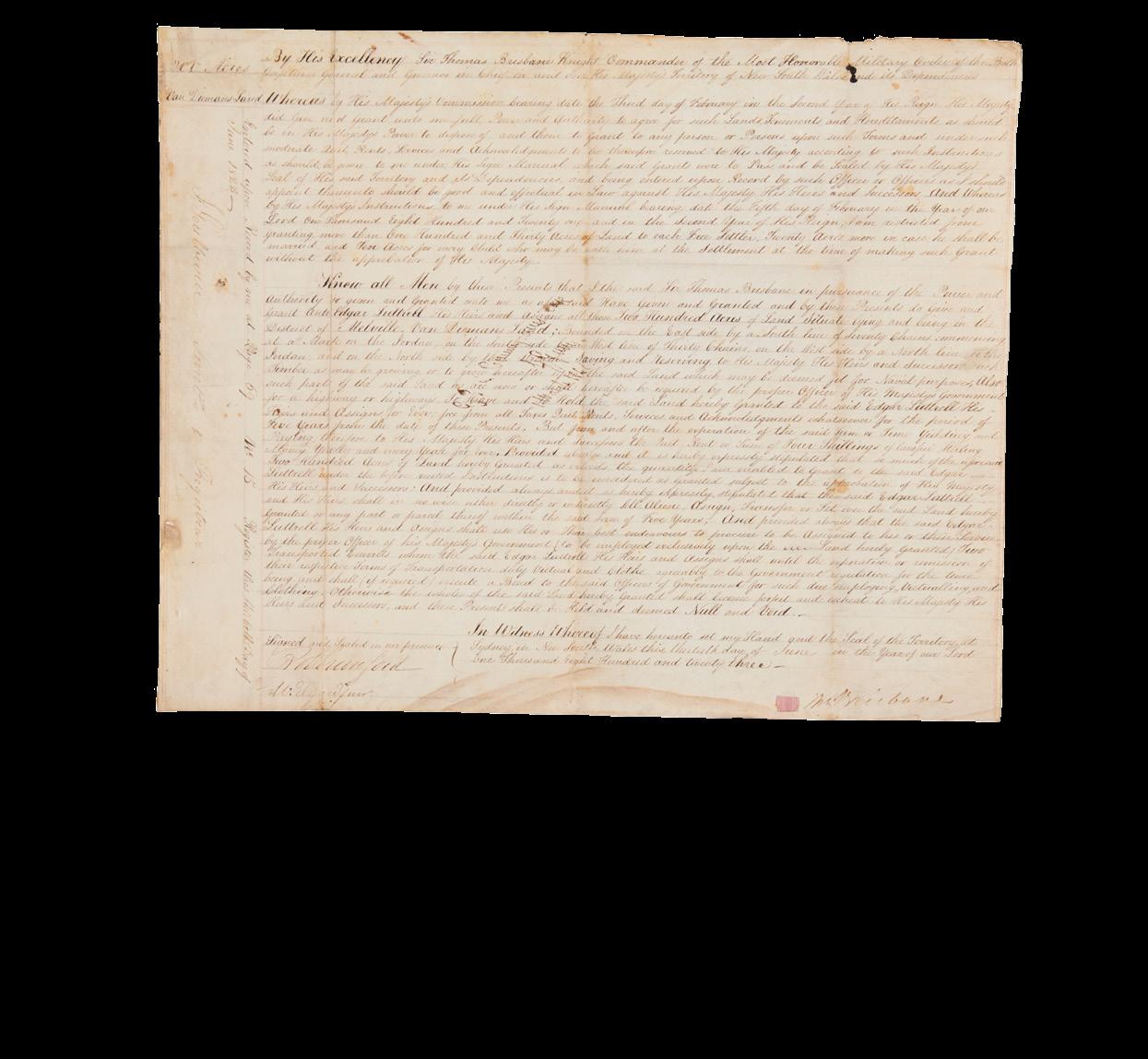
The Birds of Australia… with a descriptive account of the life and characteristics of over seven hundred species.
Six volumes, folio; 303 chromolithograph plates, with original tissue guards; publisher’s full red calf, ornately decorated and lettered in gilt, all edges gilt; a fine, crisp set; very scarce in this condition. Melbourne, Charles Stuart, 1887-1891.

A remarkably fine set, bound in six volumes in the publisher’s glamorous red calf-leather binding with elaborate gilt decoration.
Broinowski was born in Poland in 1837 and arrived in Australia in 1857. He was treated roughly on the voyage and jumped ship at Portland, Victoria. He became a naturalised citizen and died in Sydney in 1913, having had a long career as a painter and art teacher. Birds of Australia is by far his best-known work; with it he aimed to bring Australian ornithology to a much wider audience than could be served by Gould’s magnificent, yet conspicuously expensive, series of handcoloured lithographs published a generation earlier.
Broinowski’s production of over three hundred chromolithographs in Australia in 1890 was a courageous undertaking and this book stands as a monument to Australian printing technology and to the inexhaustible enthusiasm of this remarkable ornithologist. The book provides a descriptive account of the life and characteristic habits of over seven hundred species of Australian birds, making it a milestone resource in ornithological history. Invariably found very foxed and stained, this exceptional copy is unusually clean and in its splendid original six-volume binding, much more satisfactory than the unwieldy three-volume binding more usually seen.
$12,500
5001032 at hordern.com
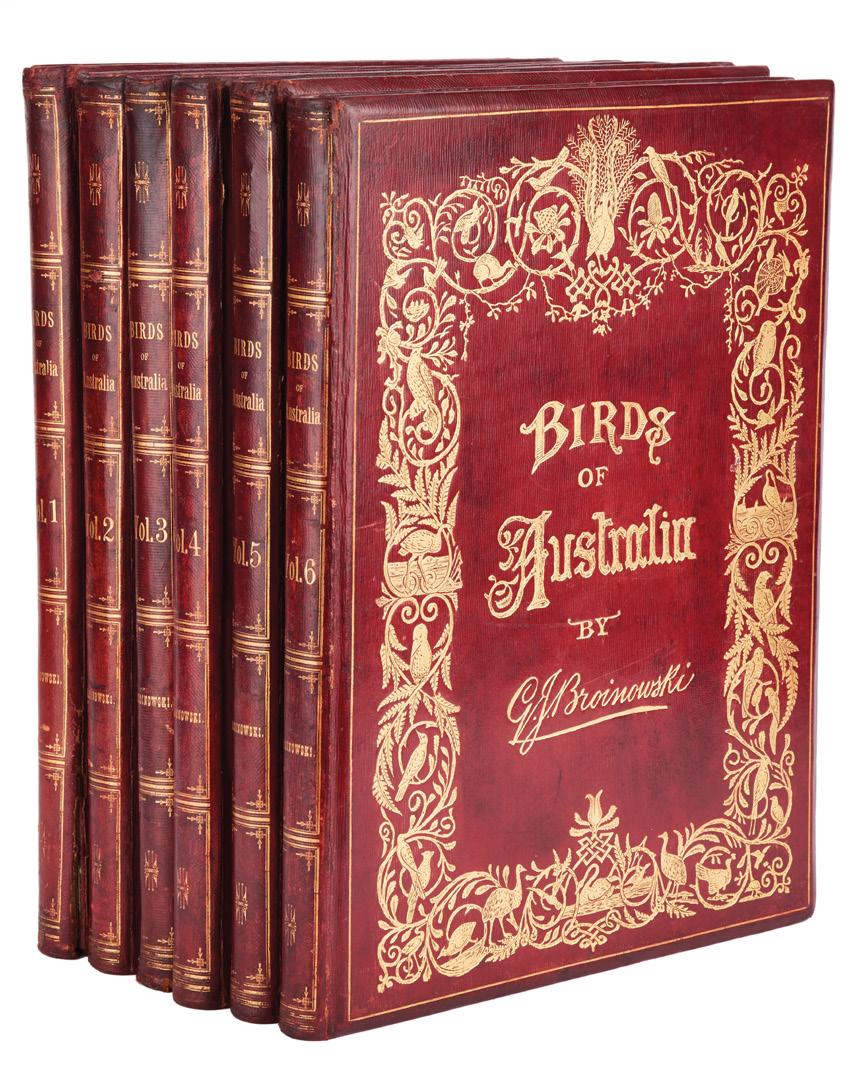
“ONE
Prodromus Florae Novae Hollandiae et Insulae Van-Diemen, exhibens characteres plantarum… [A prologue to the Flora of New Holland and Van Diemen’s Island, showing the characteristics of the plants which Robert Brown collected and described along the coasts of both islands in the years 1802-1805; with other species inserted here and there, hitherto known to the author, whether published or unpublished, especially the Banksias, discovered on the first voyage of the explorer Cook.]
Octavo; a fine copy in quarter blue morocco, by Aquarius, edges rough-trimmed only.
London, J. Johnson, 1810.
An exceptionally rare book: the records show just three copies sold publicly since 1950. This ground-breaking study of the botany of New Holland and Van Diemens Land was the work of one of the most important figures of Australian science and botany. As Mabberley has noted, this unillustrated book, never completed, and with various quirks, “… seems an unlikely contender for the most important work on Australian plants ever written, leave alone that it is also one of the most significant botanical books of all time. And it was the first attempt at a full Flora of Australia.”
Brown sailed with Flinders on the Investigator, staying on with his great friend and colleague Ferdinand Bauer to make his own explorations in Australia and Tasmania, only returning to England in 1805 with his collection of over 4000 plant specimens. For the ensuing 15 years he was librarian and curator to Sir Joseph Banks and, after the death of his great patron in 1820, was given control of the Banks herbarium, in later life working for many years at the British Museum.
The history of Brown’s books in print is famously complex, not least as almost all were effectively privately published and he was reticent, obsessive even, about who was allowed to have copies of his books. Although he produced this first part of his famous Prodromus in 1810, he never completed the book, and since little more than a handful of copies are known today it must have been a very limited printing.
Brown’s book is the first comprehensive account of Australian plants, using his collection, as well as those of Banks and Solander from Cook’s first voyage, though the book seems to have escaped the notice of Cook bibliographers, including the encyclopaedic Beddie. The Prodromus is also one of the first works on systematic botany to use de Jussieu’s natural system of classification.
$18,850
5001060 at hordern.com Ferguson, 491; Mabberley, Peter Crossing Collection, 82; Stafleu and Cowan, TL-2, 825; Wantrup, 70.
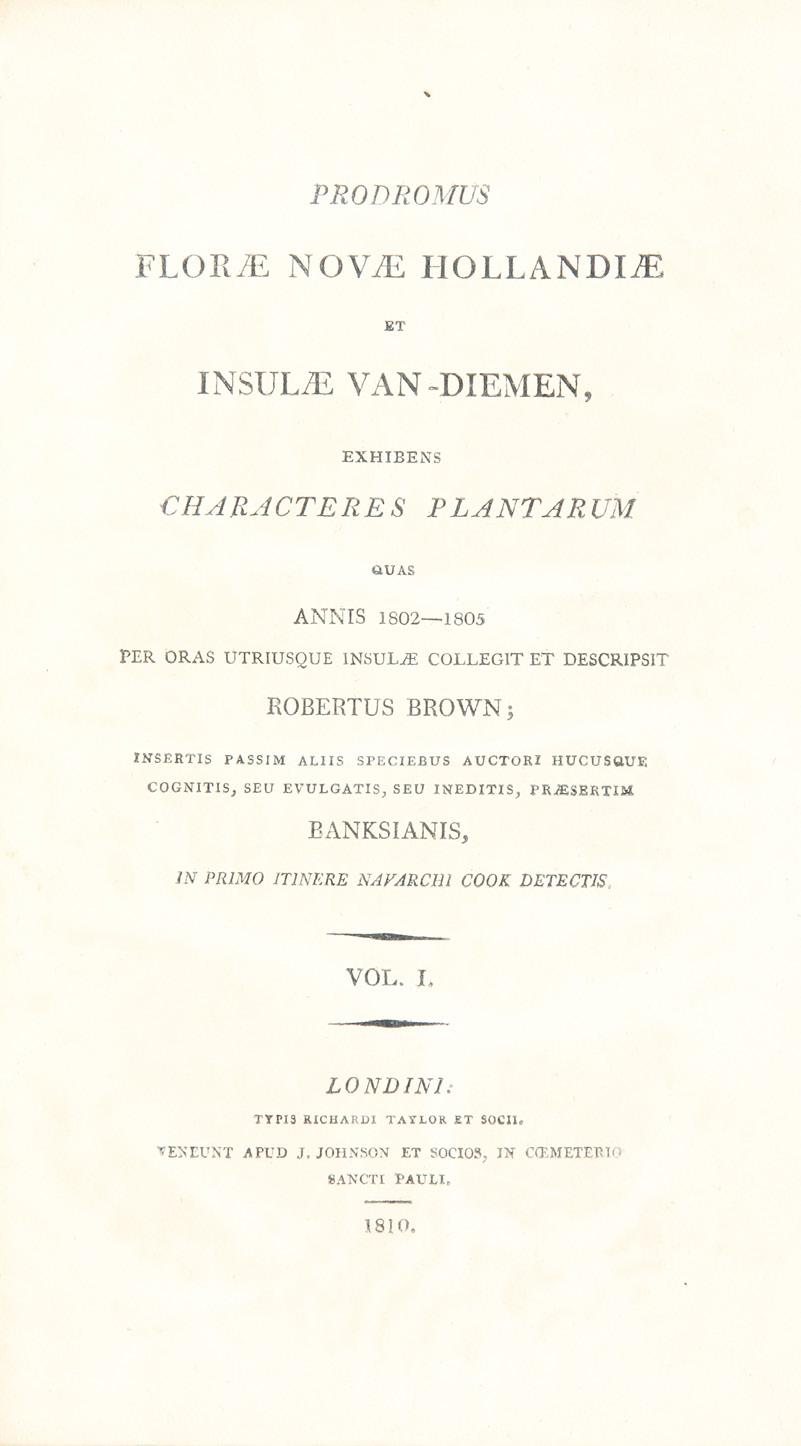
Supplementum Primum Prodromi Florae Novae Hollandiae… [First supplement to the prologue to the Flora of New Holland: exhibiting the new Proteaceae which were collected in Australasia by Messrs. Baxter, Caley, Cunningham, Fraser, and Sieber; and whose characters Robert Brown worked out from dried specimens].
Octavo, 40 pp.; a very good copy in the original plain brown wrappers, a little chipped at extremities; in a quarter morocco bookform case.
London, R. Taylor, 1830.
The significant supplement to Brown’s magnum opus, the Prodromus. It clarifies some omissions dating back to the voyage of Flinders, but also catalogues the more recent discoveries of luminaries such as Baxter, Caley, Cunningham, Fraser and Sieber. “This was the only addition to Brown’s unfinished Prodromus of 1810. Brown took the opportunity presented by all the new Australian material from Allan Cunningham, William Baxter and others to update his account of Proteaceae in his flora and issued this pamphlet. The Supplementum added more than 150 new species of Australian Proteaceae, and Brown discussed the importance of stomatal types of the leaves in this family” (Mabberley).
$6750
6000019 at hordern.com
Burbidge, Plant Taxonomic Literature in Australian Libraries, 73; Ferguson, 1329; Mabberley, Peter Crossing Collection, 142; Stafleu and Cowan, TL-2, 835; Wantrup, p.190, and 71.
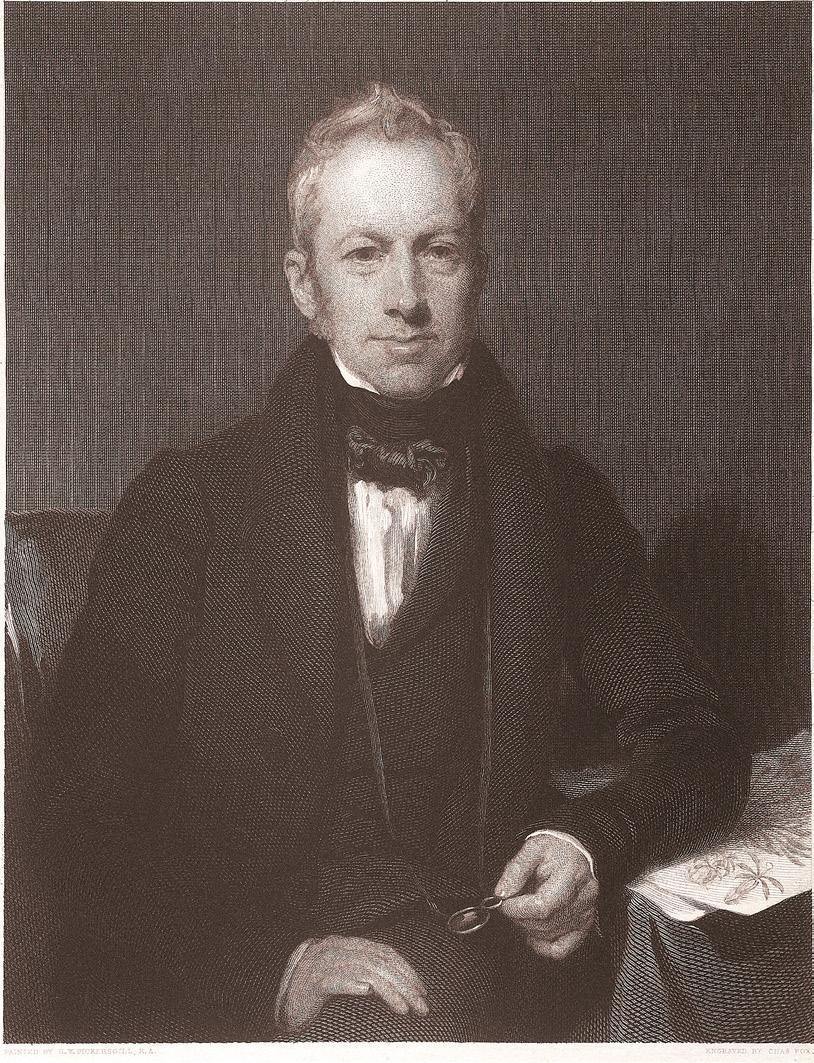
Terra Australis Cognita: or, Voyages to the Terra Australis, or Southern Hemisphere … Containing an Account of the Manners of the People, and the Productions of the Countries, hitherto found in the Southern Latitudes; the Advantages that may result from further Discoveries on this Great Continent, and the Methods of establishing Colonies there, to the advantage of Great Britain.
Three volumes, octavo, with folding maps, an excellent set in contemporary calf, gilt cipher of the Earl of Lonsdale on covers. Edinburgh, A. Donaldson, 1766-1768-1768.
First edition of this important collection of voyage material, including an early, serious proposal for the exploration and European settlement of the “Southern Continent” published almost as Cook was outfitting the Endeavour voyage.
John Callander, Scottish antiquary and man-of-letters, argues for the establishment of a penal settlement in the Pacific, to support the further exploration and settlement of New Holland, and claims the inevitability of English occupation of New Holland by virtue of superior sea power. The important final section, “Advantages from the forming of Colonies in the Terra Australis”, has been described as “the fundamental proposal for the first European settlement of the Southern Continent”, though it is markedly different to the exceptional manuscript “Proposal” by an unidentified author described elsewhere in this catalogue (no. 37).
Callander specifies his original inspiration as being the work of the French philosopherscientist Pierre Louis Maupertuis, Lettre sur le progrès des sciences (1753). Callander’s collection – making much use of a subsequent French compilation by De Brosses, also inspired by Maupertuis – contains forty-one voyage narratives, including Magellan, Drake, Sarmiento, Cavendish, Quiros, Schouten, Narborough, Dampier, Funnell, Woodes Rogers, Shelvocke and Roggeveen among others.
The excellent map of the Australian continent is “of great interest, particularly when compared with the Tasman map of 1644 [reproduced at no. 37]. Although Van Diemen’s Land is still shown as part of the mainland, New Zealand and New Guinea are already known to be separate lands and in fact the outline of Australia is complete except for the eastern coast, yet to be charted by Cook…” (Davidson).
This is an example of the scarce issue with the dedication to Sir Laurence Dundas in volume 1 (replacing the dedication to Charles Townshend). Despite this the volume retains its title-page dated 1766; the other two volumes are dated 1768.
Provenance: James Lowther, 1st Earl of Lonsdale (1736-1802, with his armorial bookplate); David L. Bremer (20th c. Melbourne collector, with his bookplate; his sale, Joel, Melbourne, 1988).
$17,500
5001033 at hordern.com
Davidson, ‘A Book Collector’s Notes’, p.35; Hill, 240; Hocken, pp. 5-7; O’Reilly-Reitman, 94; Wantrup (2025), pp. 46-48 & c.2.16a.
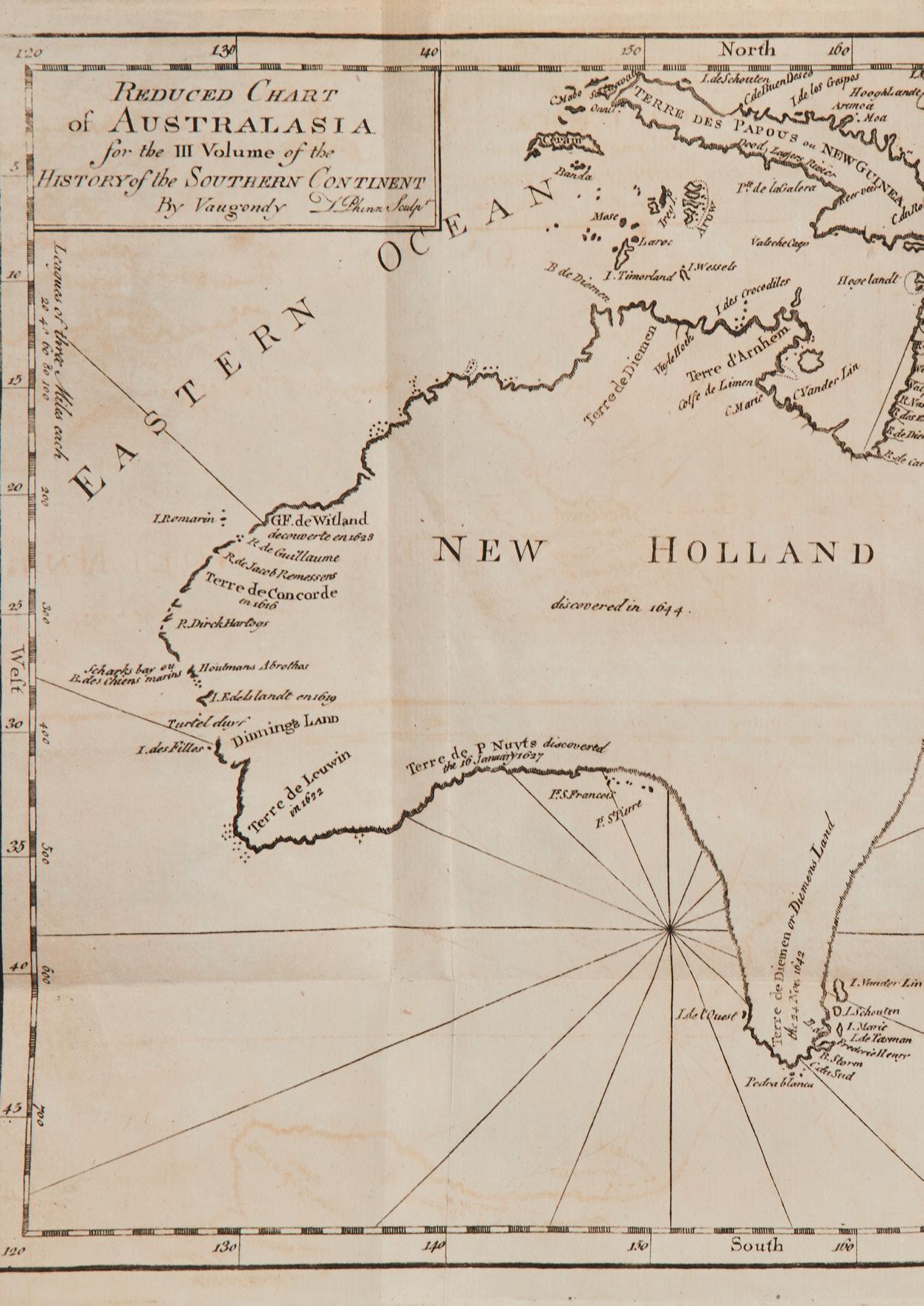
11. COLLINS, David.
Original autograph letter, to Charles Cox…
Autograph letter signed, 2 pp., and integral leaf blank except for docket-title; tipped into a good half morocco binding by Collins & Newbold. Sydney, 22 December 1795.
An excellent early example of Judge-Advocate Collins’s handwriting and signature, written from Sydney at a time when he was one of the few senior First Fleeters still in New South Wales.
Collins stayed in the colony for such an extended period, spending the better part of a decade in Sydney, that he was always tremendously exposed to the unending complexity of managing his financial affairs from the other side of the world. He relied throughout on Cox, famously known as the banker to the Royal Marines. A small number of letters from Collins to Cox have surfaced over the last few decades, of which this is one of the earliest and fullest.
Always in financial strife, he here writes at length to Charles Cox, complaining that Cox does “not appear solicitous in writing”, but Collins is so relieved by the prospect of soon leaving for England that he advises them – in rather exasperated, if understandable, tones – that “it is unnecessary for you to take any pains in the future about it. While I remain here, which I hope & expect will be but a few months longer, I shall take care, if occasions offer to send you whatever certificates may be necessary…”. Collins did eventually sail for England on the Brittania in August 1796, and whatever his annoyance with Cox, the firm continued to take care of his affairs when he returned to the colony in 1802, right through until his death in Hobart in 1810.
“His debt problems plagued him to the end of his days. His banker, Charles Cox at times, would not honour Collins’s bill of exchange, placing him in great embarrassment with creditors. When asked by Cox to reduce his overdraft, Collins replied, ‘For heaven’s sake, where do you think it is to come from?’ Consequently, as soon as Cox collected Collins’s marine pay for him, it as quickly flowed out again…” (Watson).
Eighteenth-century First Fleeter manuscripts are rare outside the major institutional collections: this is a fine specimen of the autograph of one of the most important figures in the early settlement. George Johnston’s letter dated just sixteen months earlier, which appeared in our first catalogue of the Whitmont Collection as the earliest surviving unofficial manuscript letter written in Australia by a free settler, was also written to his bankers and military agents, Messrs Cox.
Collins is of course remembered for his magisterial two-volume Account of the English Colony in New South Wales, the fundamental First Fleet work based on his own extensive records and journals: see following catalogue entry.
$18,500
5001035 at hordern.com
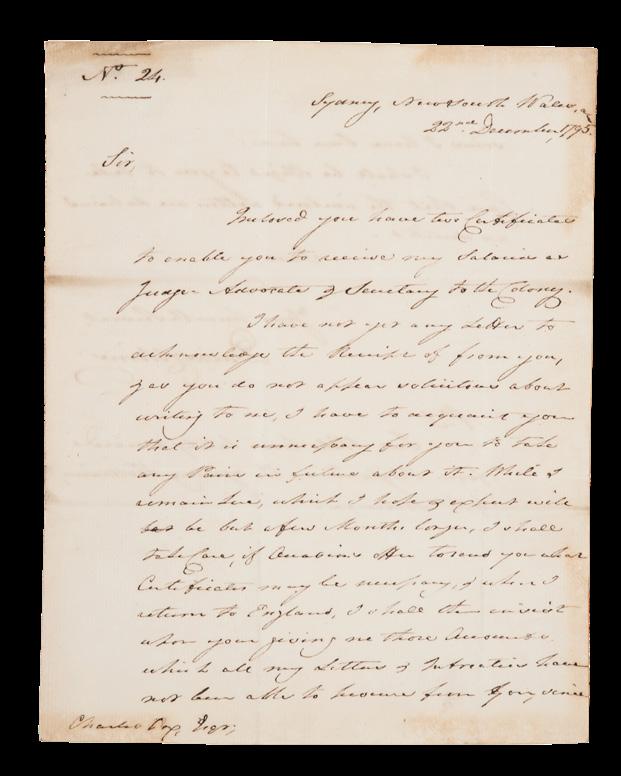
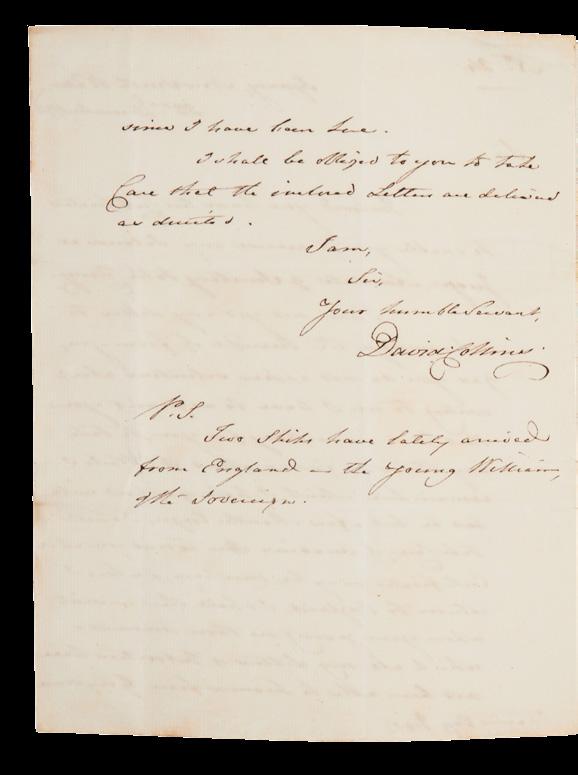
An Account of the English Colony in New South Wales.
Two volumes, quarto, with engraved plates, complete; the first volume with 18 full-page plates and four engravings in the text, the second as issued with five full-page plates (three with original hand-colouring) and four engravings in the text (two with original hand-colouring); a good set in an old half calf binding.
London, T. Cadell, Jun. and W. Davies, 1798 & 1802.
The complete first edition, published in two volumes four years apart, of David Collins’s Account, the earliest history of Australia as an English colony and the most detailed of all descriptions of the voyage and first settlement, illustrated by fine engravings almost certainly after Thomas Watling. In its complete two-volume state, Collins’s Account may be the rarest of the First Fleet journals.
Collins had arrived with the First Fleet as Judge-Advocate and was Secretary to Governor Phillip. His book is a valuable account of the early settlement by an educated and observant resident of almost ten years, and was the last of the Australian foundation books to be published. Often described as the earliest history of Australia as an English colony, it contains the most detailed and painstaking of all descriptions of the voyage and first settlement found in any of the early narratives. The book is illustrated with full-page engravings prepared in London by the well-known artist Edward Dayes from sketches done in the colony by the convict artist Watling. They are the first published views to show the British settlements at Sydney and Parramatta.
The first volume, published in 1798, is scarce today. For some reason the second volume, which came out four years later, is yet more difficult to find; uniform sets of the two, in fine contemporary condition, are of considerable rarity. “The second volume is of great importance, not only for its detailed chronicle of events but because of its narrative of voyages and expeditions of discovery… The journals of Bass and Flinders are of particular importance since Bass’s journal has never been recovered and … the accounts of inland expeditions recorded in the journals of John Price and Henry Hacking are singularly interesting. Quite apart from the exploration interest of these journals, they provide the first report of the existence of the koala, the earliest recorded sighting of a wombat on mainland Australia and the first report of the discovery of the lyrebird, which is for the first time described and illustrated in colour…” (Wantrup).
$17,500
5001034 at hordern.com

An Account of the Voyages undertaken by the Order of His present Majesty for making Discoveries in the Southern Hemisphere, and successively performed by Commodore Byron, Captain Wallis, Captain Carteret, and Captain Cook…
Three volumes, quarto, with 51 engraved charts and plates (most folding); a good set in contemporary calf, spines banded and numbered in gilt, red leather labels. London, W. Strahan & T. Cadell, [June] 1773.
A good set of the first edition of this fundamental book, in its earliest issue form.
This is the full official narrative of Cook’s great first voyage in Endeavour, during the course of which he discovered and charted the entire east coast of Australia, naming it New South Wales. Sanctioned by the Admiralty, as the first full-dress narrative and illustration of this extraordinary voyage it has great significance for any collection of Australiana or of voyages.
The primary purpose of Cook’s voyage was the observation of the transit of Venus from Tahiti, which would enable the distance between the earth and the sun to be calculated, but Cook was also commissioned to search for “Terra Australis”, the great hypothetical southern continent supposed to exist as a balance to the northern land mass. The Endeavour voyage would result in the discovery of the Society Islands, the circumnavigation of New Zealand, and the charting of the eastern coast of Australia.
The collection sets the scene for the Cook narrative by including in the first volume the official narratives of the voyages of Byron, Wallis and Carteret; the compendium thus contains the cream of eighteenth-century English exploration in the Pacific. The Cook narrative, which occupies the whole of the second and third volumes, was edited from Cook’s journals by the professional writer John Hawkesworth.
The fascinating story of the voyage, the moments of early contact, and the great characters such as Banks or the Tahitian priest Tupaia, is accompanied by magnificent plates, charts and views, famously including the first astonishing engraving of a kangaroo, charts of New Zealand and the east coast of Australia, and the moving depiction of the Endeavour, hauled on shore just north of Cape Tribulation on the north Queensland coast to fix the hole that nearly sent them to the bottom.
John Hawkesworth had been given the original journals of Captains Byron, Wallis, Carteret and Cook, as well as the private journal of Joseph Banks, in order to prepare the book for publication, a task which took almost two years. Cook himself was in the middle of his second voyage – in Cook Strait, New Zealand at the time, having just left Queen Charlotte Sound – when it was finally published in London to widespread enthusiasm on 9 June 1773.
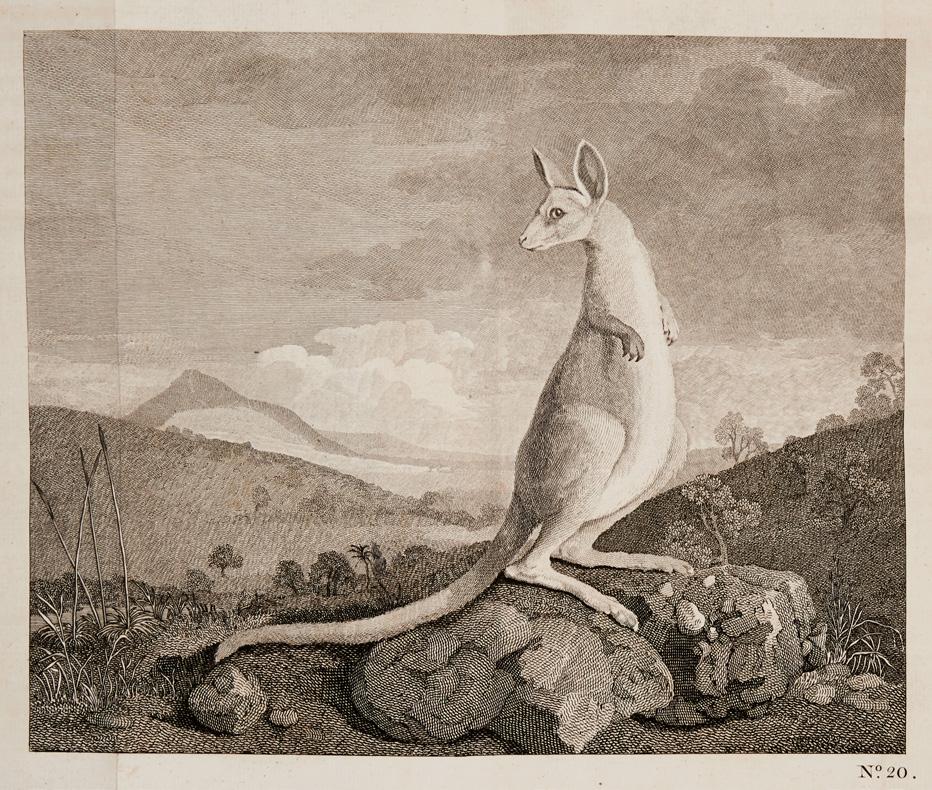
“Hawkesworth, an eminent London author, was chosen by Lord Sandwich and commissioned by the Admiralty to prepare these narratives for publication. [He] was expected to add polish to the rough narratives of sea men, and to present the accounts in a style befitting the status of the voyages as official government expeditions, intended to embellish England’s prestige as a maritime power” (Hill).
As the official narrative of the Endeavour voyage this publication has always enjoyed considerable status, and although the book was a huge success, fast becoming a bestseller, it certainly had its critics, chiefly because of Hawkesworth’s rather clumsy editing: Cook himself hated the use of the first person singular in the narrative. Horace Walpole noted waspishly in a letter (to Dr Mason: Yale edition of the Letters, vol. 28, p. 96) that “I have almost waded through Dr Hawkesworth’s three volumes of the voyages in the South Seas. The entertaining matters would not fill half a volume; and at best it is but an account of the fishermen on the coasts of 40 islands…”.
“He was publicly attacked on three different counts: by the captains for tampering with the texts of their journals, by prudish readers for reprinting descriptions of the sexual freedoms of the South Sea islanders, and by devout churchmen for impiety in the general introduction to the work, in which Hawkesworth had rashly challenged the doctrine of providential intervention. He was devastated by this critical barrage, and it was thought to be the main cause of his death. The rumour recorded by Malone that he killed himself with an overdose of opium is uncorroborated, but Fanny Burney’s conviction that his health was destroyed by the vilification he suffered seems well founded” (ODNB).
This set is a good example of the earliest issue of the first edition, published before the chart of the Strait of Magellan and the List of Plates were ready for inclusion.
Provenance: Sir Henry Edward Bunbury, 7th Baronet KCB (1778-1860), British soldier and historian, whose son carried out early explorations in Western Australia (with armorial bookplates).
$16,850
5001039 at hordern.com
Beddie, 650; Borba de Moraes, p.395; Hill, 783; Holmes, 5(n); Kroepelien, 535(n); Wantrup, ARB (2025), 5.05.
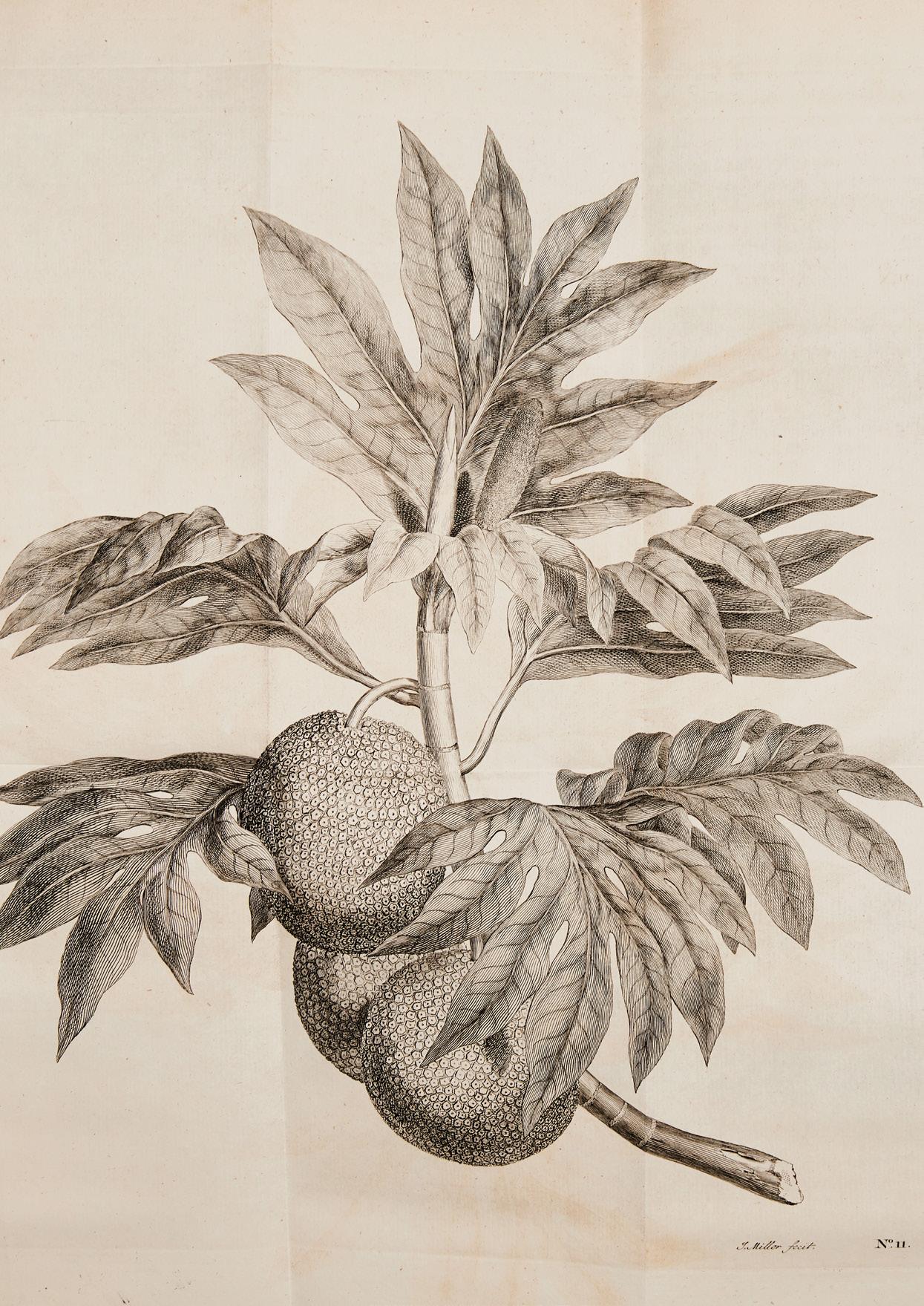
Autograph letter signed to Joan Gideon Loten F.R.S., governor of Batavia.
Bifolium on wove paper, watermarked, a long clearly written letter of about 700 words on three pages. [London], 14 October 1783.
A fine and interesting letter from the hydrographer Alexander Dalrymple (1737-1808) to the famous natural historian, Joan Gideon Loten (1710-1789), close colleagues since the Dutchman had lived in London in the 1760s.
Dalrymple manuscripts of any kind are known to be very rare on the market, let alone such a fine and revealing letter, absolutely full of the latest news, not least his highly unflattering assessment of the explorer James “Abyssinian” Bruce, as well as a comment on his East Indies maps (“I have now in the press a General Introduction to all my Nautical Publications which now exceed 300 Plates of Charts Plans & View”).
Intriguingly, Dalrymple “cannot give you any satisfactory information concerning which of the two accounts of Omai comes nearest truth having read neither.” He adds that the “Work published at the Public Expence will be accompanied with many Plates most excellently engraved under the inspection of the Painter who drew them. It is expected to appear by next May.”
Taken together, the two remarks show that he had Cook in his thoughts, as this is sure to be his insider comment on the progress of Cook’s third voyage under the art direction of John Webber. Given his full-throated criticisms of everything to do with Cook, this is a genuinely surprising revelation. Nor was Dalrymple far off – the book appeared in June 1784.
Equally interesting is the evidence of Loten’s query about accounts of Omai – given the date, none of the bizarre pantomimes or fictions such as those by O’Keeffe (1785) or Baston (1790) could be meant: rather he must have been reading some of the unofficial accounts of the third voyage, probably Rickman, with its famous plate showing Omai’s return, which was widely available in France. But what was the second book? Whatever the case, Loten’s query is important because although even the most well-connected folks scrambled to read the piracies and unofficial accounts of Cook, evidence of their actual reading is poorly-attested.
These references alone would underscore the importance of the letter, but it is rich in detail throughout. His comments on the explorer Bruce are remarkable (not least his assessment that Bruce “cannot draw at all” but had nonetheless somehow contrived to sell his portfolio to the King), but there is also much on the famous London publisher Peter Elmsley (something of a direct competitor of Dalrymple’s), and his delight in adding “outlandish Places” to his map collection.
$10,500
5001044 at hordern.com
Cook, Alexander Dalrymple (1737-1808), hydrographer to the East India Company and the Admiralty (1993).
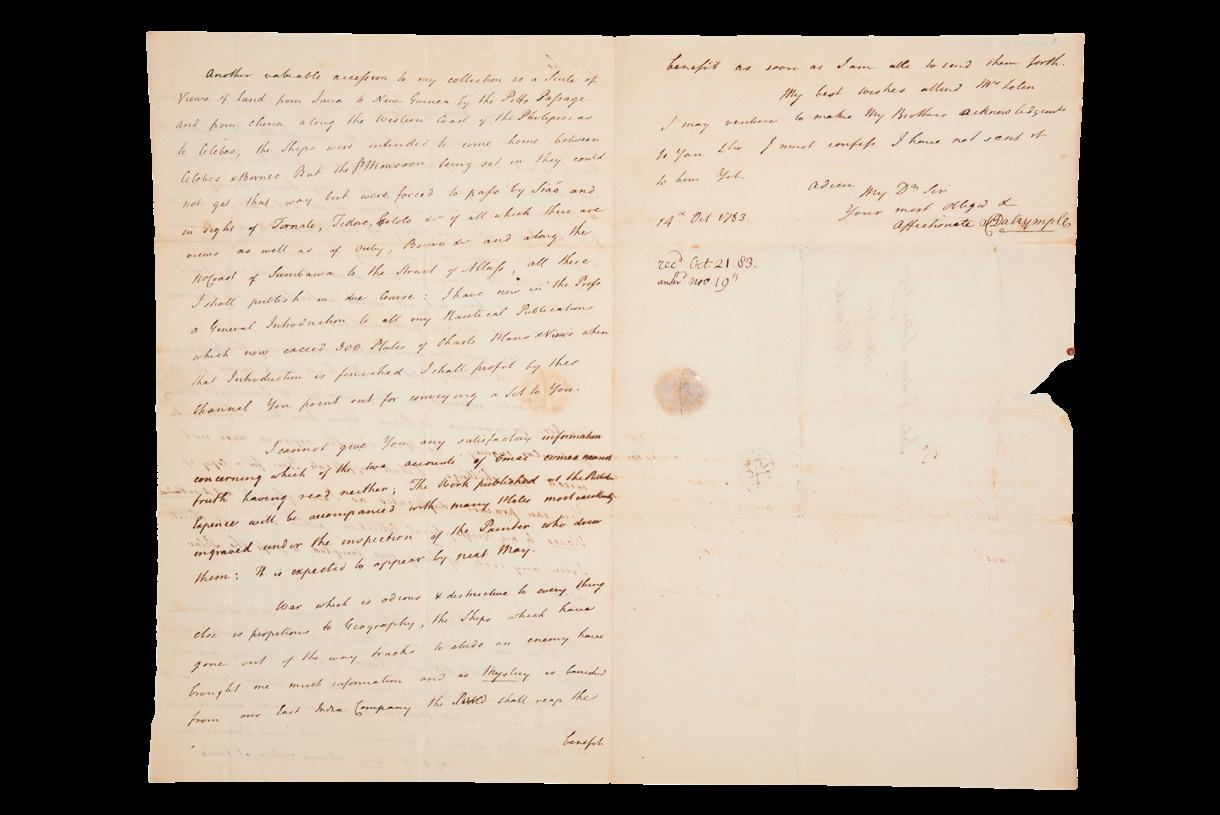
A Voyage Round the World. Containing an Account of Captain Dampier’s Expedition into the South-Seas in the ship St. George, in the years 1703 and 1704… Together with the author’s voyage from Amapalla on the west-coast of Mexico, to East India.
Octavo, with five folding maps and ten engraved plates; contemporary panelled calf, spine repaired.
London, Printed by W. Botham for James Knapton, 1707.
First edition of Funnell’s voyage narrative, an essential if controversial component of the Dampier voyage canon. Not unlike the surreptitious and unofficial accounts that dogged Cook several decades later, the book infuriated Dampier, not least that a book so critical of him would be issued by his own publisher. He immediately published his rare single-sheet refutation, A Vindication but the die was cast, doubly so when Funnell’s book was included in Dampier’s posthumously-published collected voyages of 1729.
Funnell joined Dampier’s third privateering expedition as mate of the St. George which sailed for the Canary Islands, Brazil and the South Seas in April 1703. It was during this voyage that Alexander Selkirk, the prototype of Defoe’s Robinson Crusoe, was marooned on Juan Fernandez. The St. George was joined by the Cinque Ports and both ships started looting on the South American coast in January 1704. Funnell’s account is highly critical of Dampier, and charges him with being routinely drunk, using foul and abusive language, oppressing his crew, and cowardice. The antagonism between the two men was exacerbated when they took the Spanish galleon Asuncion as a prize. With limited time available, Dampier ordered the food stores moved to the St. George and forbade Funnell to search the Asuncion for hidden gold. Ultimately both the St. George and Cinque Ports were declared unseaworthy and abandoned in late 1704. The expedition split, with Funnell and other disgruntled sailors taking a small Spanish prize to Amboina in the Dutch East Indies, where the ship was impounded by the Dutch. Funnell, together with the remaining crew, was embarked on the next Dutch fleet for Europe. Dampier returned to Peru and thence the Indies where he was also temporarily imprisoned by the Dutch.
As a result, Funnell completed the circumnavigation (albeit by relay), and returned to England well before his captain. Dampier’s own publisher Knapton rushed Funnell’s narrative quickly into print. Burney criticises the mercenary motives of Knapton in publishing what was essentially “A fourth volume… which contains not a word of Dampier’s writing; but much that he disapproved”. Whilst Dampier’s temper has long been questioned, surely Burney’s summation of this publication is apt: it “could not have fallen into worse hands than those of Funnell. Besides being extremely ignorant, he was void of regard or respect for veracity”.
$7200
5001065 at hordern.com
Borba de Moraes, I:333-4; Davidson, ‘A Book Collector’s Notes’, p. 33; Hill, 664; Sabin, 26213.
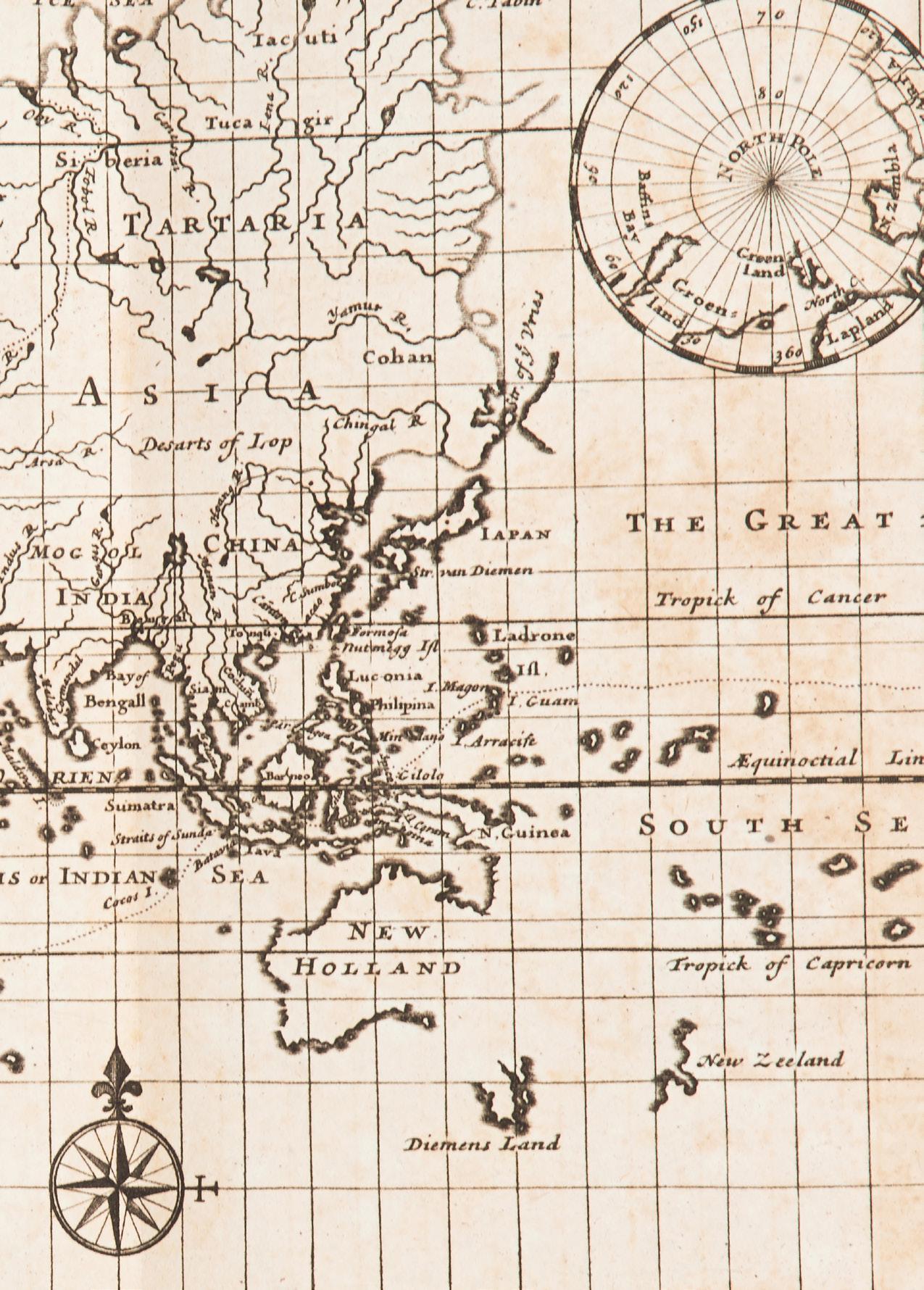

A Voyage to Terra Australis; undertaken for the purpose of completing the Discovery of that vast Country, and prosecuted in the years 1801, 1802, and 1803 in his Majesty’s Ship the Investigator…
Complete set of the Flinders account, comprising: two volumes, quarto, with nine engraved plates, and accompanying atlas in the elephant folio format; text volumes in a superb contemporary Irish binding of russia leather (by the Irish binder George Mullen, with his ticket), ornately blind and gilt; the atlas with nine large charts, seven single-page charts, two double-page plates of coastal views and ten botanical plates, all first-issue plates with large margins; in a good binding of half calf; a fine set. London, W. Bulmer and Co., 1814.
One of the greatest classics of Australian exploration and discovery and scarce on the market: a handsome set, in fine condition, with the atlas in its preferred largest “elephant folio” format and all of the maps in their first issue state. The text volumes are in superb and distinctive Irish bindings of the period.
This splendid book gives the official narrative of the classic voyage of discovery made by Flinders in the Investigator, “an enlightening and fascinating story of brilliant navigation and discovery” (DNB). As a boy Flinders longed to go to sea, an ambition realised when he sailed as a midshipman on Bligh’s second breadfruit voyage. Flinders distinguished himself during the voyage which was, incidentally, the first time that the great navigator visited Tasmania.
The voyage of the Investigator was a full-scale expedition to discover and explore the entire coastline of Australia (which was the name that Flinders himself preferred and championed). Flinders was the first to circumnavigate the continent, finally establishing that Australia was one large island and not, as had previously been speculated, divided by a navigable central strait.
His classic account of the voyage could only be published in 1814, the delay caused of course by his imprisonment by the French on Mauritius, meaning that, ironically, the French, even though they took their time to get it into print, managed to produce their account of the contemporaneous Baudin voyage some years before Flinders’s account could appear. The traditional myth, however, that Flinders was shown the first copy of his book as he lay on his deathbed is now known to be nonsense: apart from anything else, we have handled what was clearly a lifetime presentation copy of the voyage classic.
The two text volumes in their splendid Irish bindings [illustrated opposite] and accompanying atlas form the complete record of the expedition with an authoritative introductory history of maritime exploration in Australian waters from the earliest times. The text contains a day-by-day account of the Investigator voyage and Flinders’s later voyages on the Porpoise and the Cumberland. Robert Brown’s “General Remarks, geographical and systematical, on the Botany of Terra Australis,” which is illustrated by Ferdinand Bauer’s botanical plates in the atlas, is printed in an appendix in the second volume.

The text is illustrated by William Westall’s nine engraved plates in the text and two double-page plates of coastal views in the atlas. These are in many cases the very earliest views of the places visited and discovered on the voyage. Flinders’s charts in the atlas – including the celebrated map of the continent [illustrated on following pages] –were of such accuracy that they continued to be issued by the Admiralty for decades and form the basis of all modern charts of Australia. All the charts in the atlas here bear the imprint “W. & G. Nicol Pall Mall… 1814”, an important point that identifies them as being in the first issue form. Copies of the atlas exist in elephant folio format (as here), or the more conventional regular sized folio, whose size required that the charts be more folded and the botanical plates folded in half, whereas here they are in the much-preferred unfolded format.
“Flinders’s Voyage to Terra Australis is the most outstanding book on the coastal exploration of Australia. It is the centrepiece in any collection of books dealing with Australian coastal discovery. Such is the historical importance of this monumental work that no general collection of Australian books could be considered complete without it” (Wantrup).
Provenance: Text volumes: George John Sackville-West, 5th Earl de la Warr (1791-1869, with his armorial bookplate).
$75,000
5001055 at hordern.com
Hill, 614; Ingleton, 6487; Kroepelien, 438; Mabberley, Peter Crossing Collection, 92; Nissen BBI, 637; Stafleu & Cowan, I, 1806; Wantrup, 67a.
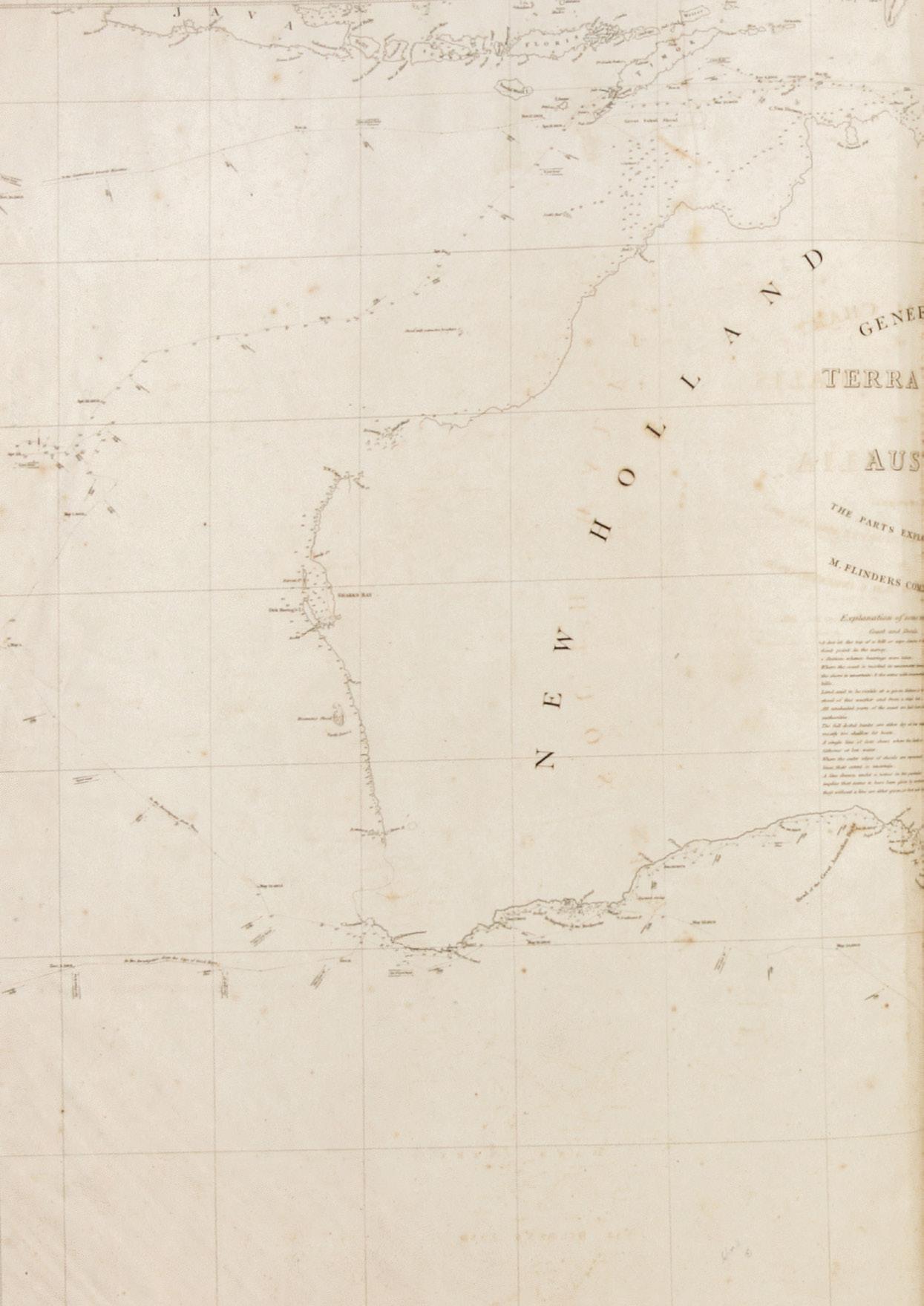
Flinders’s celebrated map of Australia, 1814 (Item 16)
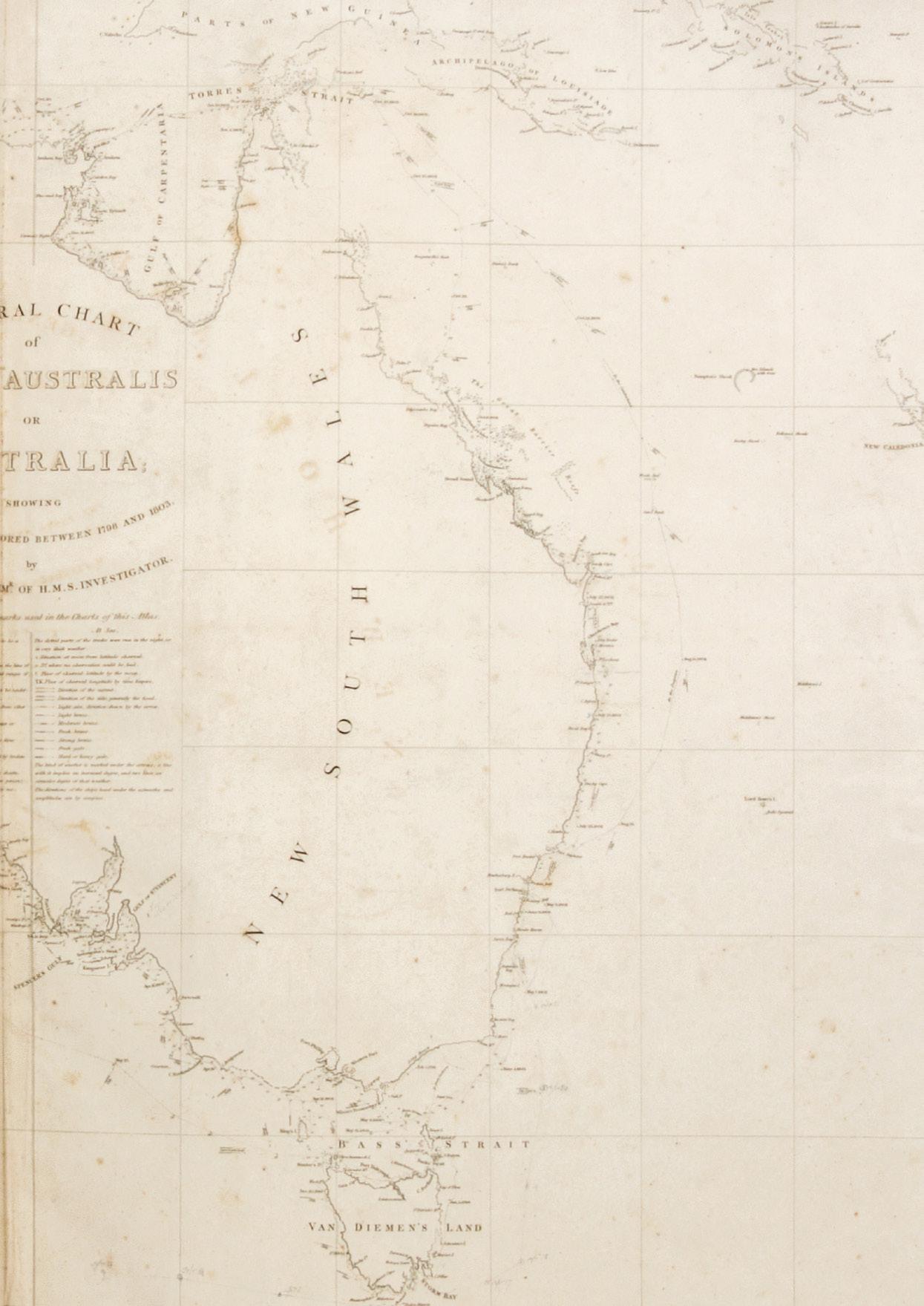
Views of Australian Scenery, painted by W. Westall…
Oblong quarto; nine fine steel-engraved plates; a good copy in a modern binding of half calf. London, G. & W. Nicoll, 1814.
The de-luxe thick paper issue of the separate publication of this series of engraved views made on the Flinders voyage.
William Westall (1781-1850) was recommended by Benjamin West, president of the Royal Academy, for appointment as landscape artist to Matthew Flinders’s voyage in the Investigator. Their circumnavigation of Australia from 1801 to 1803 was a momentous undertaking and the views prepared on the voyage constitute in many instances the earliest European depictions of parts of the Australian coastline.
Westall’s sketches from the voyage were used in the preparation of these engravings of Kangaroo Island, Malay Road, Wreck-Reef Bank, Murray’s Islands, King George’s Sound, Port Jackson, Port Bowen, Gulf of Carpentaria and Port Lincoln. Westall completed about 140 sketches and water colours during the voyage. In 1811 Flinders, in conference with Sir Joseph Banks and the artist, choose just nine of them to be made into oil paintings for the Admiralty, and to be engraved as illustrations. The magnificent paintings can today be seen at the National Maritime Museum in Greenwich, England.
The fine engravings were used in Flinders’s official account (see above) and to illustrate this rare separately issued work.
$9500
5001061 at hordern.com
Abbey, ‘Travel’, 567; Ferguson, 597; Wantrup 74a.
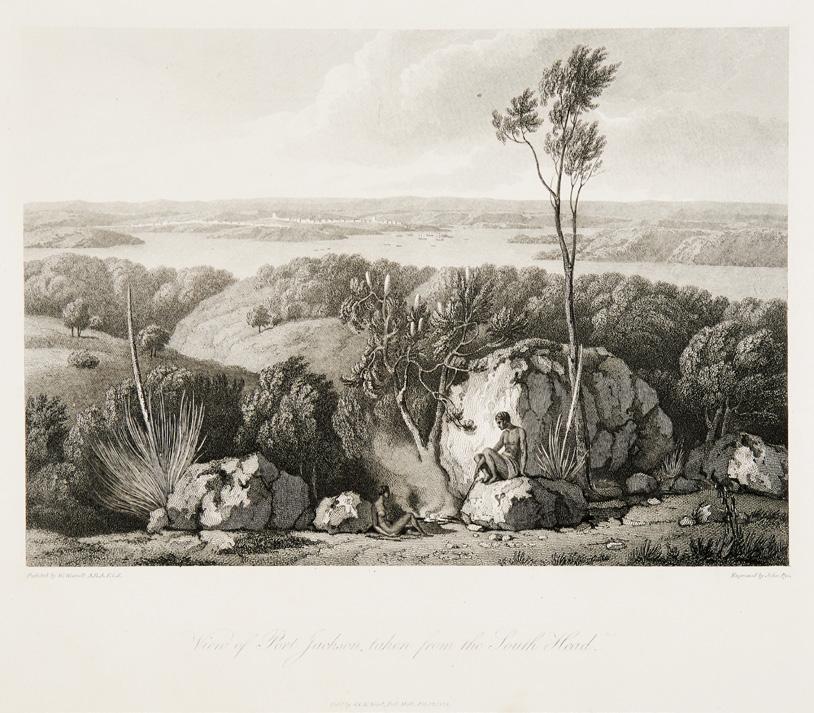
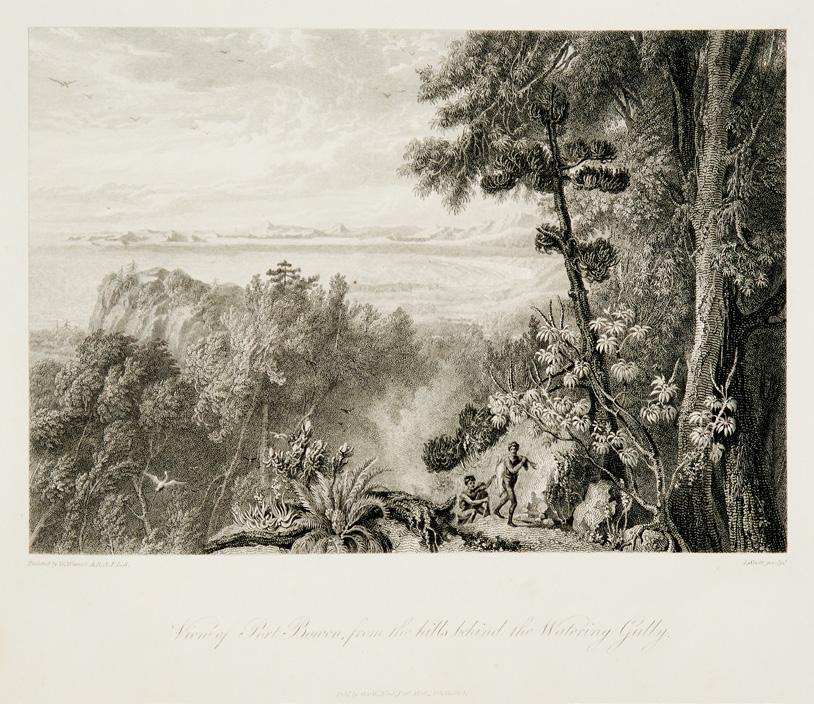
Printed Land Grant, completed in ms., to William Walkinshaw.
Land grant, 290 x 515mm, on vellum, partly printed and completed in manuscript, original paper seal attached; small coloured outline diagram; originally folded and now tipped in to a modern quarter morocco binding.
Hobart, 29 June 1839.
With an excellent strong example of the great polar explorer Sir John Franklin’s signature, during his difficult and fraught stint as the Governor in Tasmania.
This is a good example of the grant of a town site in Launceston by Franklin, who had succeeded George Arthur as Lieutenant Governor of Van Diemen’s Land in 1837, and quickly began dismantling the existing system of convict management characterised by cruelty, cronyism and ineptitude. He continued in office until 1843, when a combination of the difficult financial headwinds of the 1840s and the active politicking of many prominent free settlers led to his recall. It is said that the bitterness of his final years in Tasmania strongly influenced his petitioning to be allowed command of the ill-fated Erebus and Terror voyage in search of the Northwest Passage, which he undertook at least in part to restore his good name.
Franklin was intimately connected with Australia from a young age, having served as a midshipman under Matthew Flinders in the Investigator during the circumnavigation of Australia in 1801-1803, and later built a significant reputation as the pre-eminent Arctic explorer of his generation. He never returned from his final expedition: his two ships themselves have relatively recently been discovered, astonishingly well-preserved in the cold northern waters.
Little is recorded of William Walkinshaw (c.1797-1845), other than his ownership of a store in Launceston, perhaps the site of this grant; he was clearly an old Tasmanianhand, his name cropping up in the newspapers as an agent, merchant, wharfinger and shipper for several decades. He was certainly in Tasmania by 1821 if not before but, sadly, he was declared insolvent in 1844 and died the following year. He must have had some land as well since the Hobart Town Gazette for 11 June 1824 reported on the prosecution of several men for stealing sheep from him, or receiving the sheep knowing they had been stolen. Thomas Butler, Edward Evans, Silvester Lush and Daniel Brown all pleaded Not Guilty; all but Brown were found guilty.
The grant includes a coloured outline chart of the site at the corner of Esplanade, Charles Street and William Street, beside the North Esk river.
$8850
5001063 at hordern.com

Autograph letter signed to Henri de Freycinet, with a full transcription of a letter written by Louis during the Uranie voyage.
Three-page letter on laid and watermarked paper, 215 x 165 mm., address panel and Loriol postmark to fourth page.
Freycinet (the family estate), 13 September 1818.
An important rediscovery: a carefree Louis de Freycinet regales his family with news of his and Rose’s reception at the Ile de France in 1818 during a critical moment of the Uranie voyage. Freycinet’s original letter, now lost, was here transcribed by his mother Elisabeth to be forwarded to her eldest son (and Baudin voyage veteran) Henri in Rochefort. This is a now well-attested practice of the family’s, albeit more commonly seen with letters from Rose.
This transcription of some 800 words is an important addition to our picture of the private life and ambitions of Freycinet: it is effectively only the third known private voyage letter by Freycinet of any real substance. Louis’s original letter had been dated Ile de France, 12 May 1818. The Uranie voyage spent some two months at the island, where Rose was fêted by the locals and Louis had a rare chance to catch up with his brother Charles, then about to sail for Calcutta: “ le chemin de la fortune,” commented Louis, might give Charles a chance to clear his debts. It would be the last time he saw his brother, who died in India five years later.
The second half of the letter is Louis’s superb account of their kind reception in Port Louis, and particularly the services of George Smith, chief judge of Mauritius, to whom Charles had been private secretary. Smith had personally entreated them to enjoy all of the luxuries of his palatial house – dining, horses, carriages, palanquins, even a gala ball in Rose’s honour, while Freycinet writes that their observatory was set up in the grounds.
Louis concludes with the news that they have already sent three large cases full of natural history specimens from the “three kingdoms” to France. He signs off with jaunty best wishes and the note that his wife is completely occupied at the moment in writing the family a long letter which she will send before they leave, which will tell them thousands of things about the voyage.
It is a surprise to realise how few private letters by Louis survive from the entire Uranie voyage. Apart from the present example, the only known equivalents are a letter Freycinet wrote to the Sydney judge Barron Field (a small masterpiece), and another he wrote to his brother Henri in July 1818. Additionally, there are a few very brief postscripts he added to letters by Rose: these, in turn, are known from transcriptions by Elisabeth de Freycinet, just as here. All of these known letters are now in the SLNSW, most via roundabout routes (the Field letter, for example, was for many years in the collection of the eccentric Parisian collector Henri Ledoux).
$42,000
5001137 at hordern.com
Duplomb, ‘La Perte de l’Uranie,’ Le Géographie (March 1924); SLNSW.
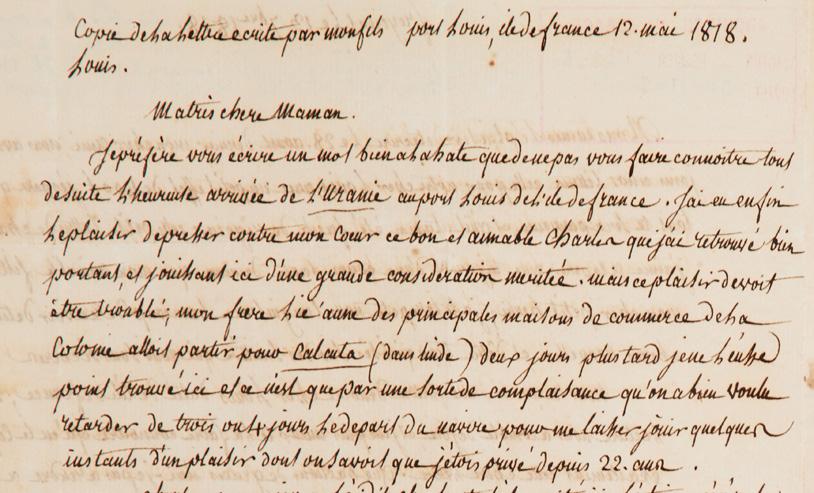
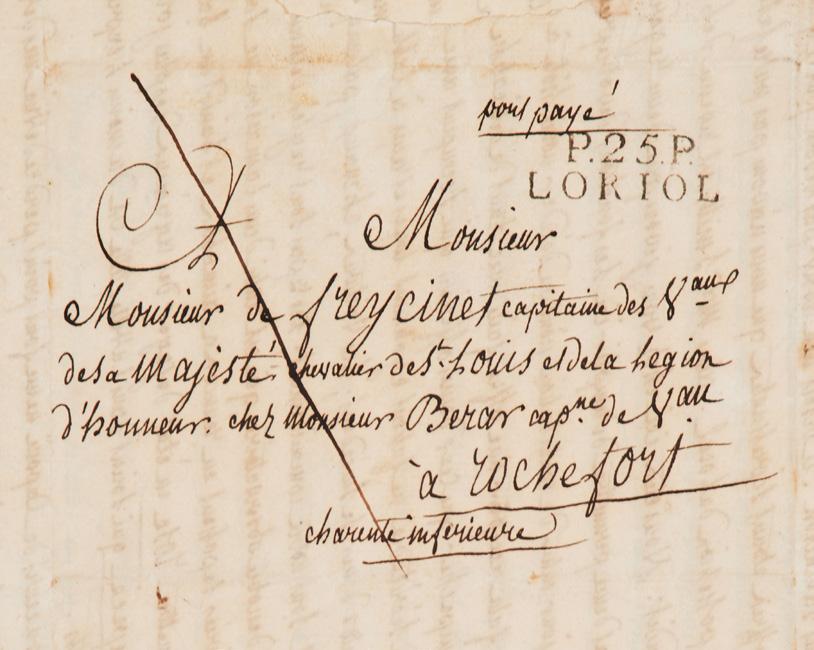
20. HARRIS, John; edited and revised by John CAMPBELL.
Navigantium atque Itinerantium Bibliotheca… Or, a Complete Collection of Voyages and Travels: Consisting of above Four Hundred of the most Authentick Writers…
Two volumes, large thick folio, with altogether 61 engraved maps and plates (several folding) by or after Emmanuel Bowen; a fine copy in contemporary calf. London, for T. Woodward [and others], 1764.
A splendid copy of this substantial and significant work in the history of exploration literature, a comprehensive compilation of accounts from numerous explorers and travellers. This is an example of the third edition, clearly published in light of the reawakening of British voyaging to the Pacific, and one of the preferred issues of the book since it contains the full complement of maps.
Harris’s great collection was first published in 1705 in slighter form. It was extensively revised by John Campbell for the second (1744) and third editions: he added narratives of new voyages – many of Australasian interest – that had been undertaken or become known since 1705. He also had new maps prepared by Emmanuel Bowen, including the famous Tasman map of Australia used to illustrate the voyages of both Pelsaert and Tasman [illustrated at catalogue no. 37] which did not appear in the first edition.
Campbell “recommended an expedition to Van Diemen’s Land, and a voyage to New Guinea by which means… ‘all the back coast of New Holland, and New Guiney, might be thoroughly examined; and we might know as well, and as certainly, as the Dutch, how far a Colony settled there might answer our Expectations’…” (Glyndwr Williams and Alan Frost, Terra Australis to Australia , 1988). In this particular aspect his work should be seen in context with the collection published by Callander (no. 10), but more importantly the extraordinary unpublished anonymous “Proposal” (no. 37) which, though it coincided in timing with Campbell’s version of Harris and acknowledged data acquired from the collection, remained otherwise entirely distinct in terms of the planning it offered for colonisation..
“In addition to the two charts of the world with interesting maps of New Holland and the chart ‘the Discoveries made by Capt. William Dampier in the Roebuck in 1699’ this edition contains a copy of Tasman’s original map, with engraved surface 19 x 15 inches, to which is added two short articles printed on the map, one discussing the Quiros voyage and the other the possibilities of the continent being colonised: ‘Whoever perfectly discovers and settles it will become infallibly possessed of territories as rich and fruitful and as capable of improvement as any that have hitherto been found…’. The voyages of Australian and Pacific interest are numerous including those of de Quiros, Pelsaert, Tasman, Narborough, Magellan, Drake, Funnell, Woodes, Rogers, Cavendish, Cowley, Dampier, Anson and Roggewein”. (Davidson).
$16,000
5001072 at hordern.com
Davidson, ‘A Book Collector’s Notes’, pp. 37-8; Hill, 775; Lada-Mocarski, 3; Perry, p. 60; Schilder, ‘Australia Unveiled’, map 87; Tooley, 241; Wantrup, ARB (2025), 2.11 (1744 issue).

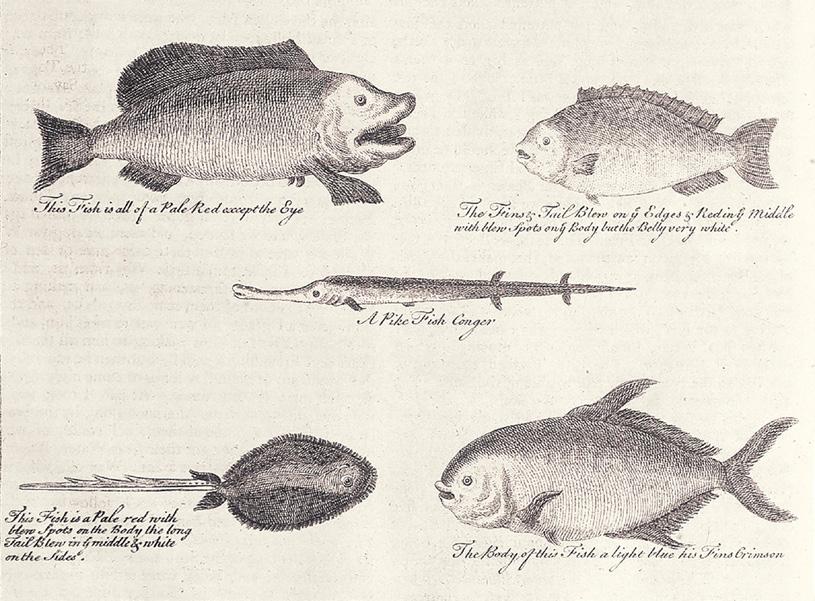
An Historical Journal of the Transactions at Port Jackson and Norfolk Island, with the Discoveries which have been made in New South Wales and in the Southern Ocean…
Quarto, with 17 engraved plates, folding maps and charts (including the fine title-page vignette); a very good copy in a fine old binding of dark green straightgrain morocco with gilt greek key borders to covers, inner gilt dentelle borders, spine decorated and lettered in gilt between raised bands, all edges gilt.
London, John Stockdale, 1793.
A very attractive copy of the first edition of Hunter’s important Journal of the first years of settlement at Sydney.
The first published engraved view of Sydney contained in the book is well known, but Hunter’s Journal also includes a fascinating plate of a “Family of New South Wales” engraved by the artist and poet William Blake, and a marvellous large-format map of the entire Sydney basin after the original by William Bradley. Of note, the two engravings illustrated opposite, A Man of the Duke of Norfolk’s Island and Man of Lord Howe’s Group are both signed “J. Hunter del.” at lower left.
Second captain of HMS Sirius under Phillip for the voyage to Botany Bay, Hunter became actively engaged in surveying and exploration in New South Wales, making an important southern hemisphere circumnavigation in 1789, when he took the Sirius to Cape Town and back in the low latitudes. Hunter was personally devastated when he later lost the ship, driven on shore in a difficult squall off the treacherous coast of Norfolk Island in March 1790. He finally sailed for England a year later, together with some of his longest-serving officers. Forced to travel on a hired Dutch transport ship, the voyage home took a long 13 months, presumably allowing him ample time to prepare a best copy of his journals.
Hunter gives an excellent account of many activities, particularly the first account of the exploration and the settlement at Norfolk Island (based on King’s papers), which are treated more cursorily by the other First Fleet chroniclers. Hunter was an experienced sea captain and the most dedicated navigator of the First Fleeters, and his book is in effect the first pilot for Australian waters and a significant companion to Cook, in particular, whose works he frequently consulted. Less well-known is the fact that Hunter’s book also includes an important continuation of Governor Phillip’s journals, as it prints his dispatches to the end of 1791. The work includes the earliest reference to the possibility of there being a strait between the mainland and Tasmania: Hunter records, “There is reason thence to believe, that there is in that space either a very deep gulf, or a straight, which may separate Van Diemen’s Land from New Holland…” (p.26).
Provenance: William Morehead (with bookplate); pencil collation note dated 1889. $9850
5001075 at hordern.com
Crittenden, ‘A Bibliography of the First Fleet’, 110; Ferguson, 152; Mabberley, ‘Peter Crossing Collection‘, 27; Wantrup, 13.

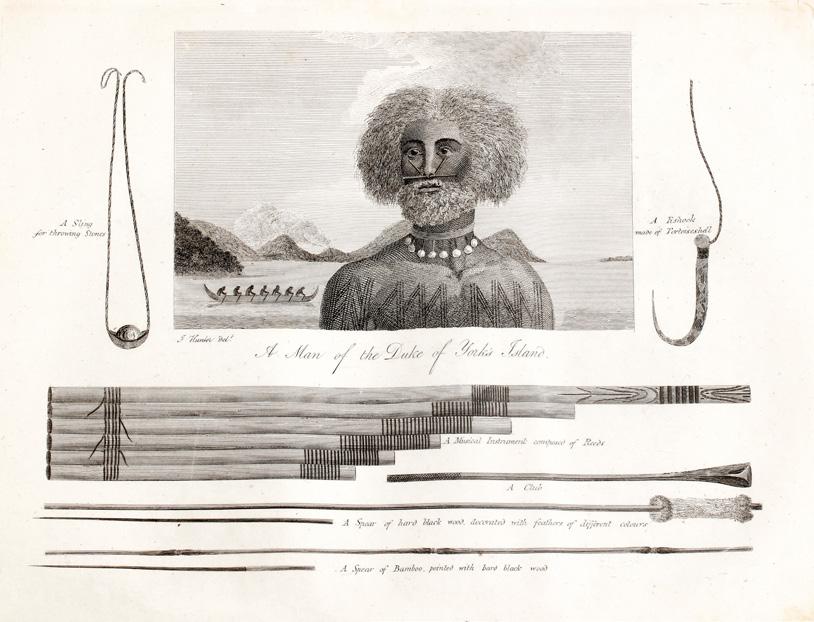
“IMPRISONING …
Manuscript warrant for the Court-Martial of Lieutenant Colonel George Johnston.
Manuscript on bifolium (367 x 240mm), three pages, docketed on last page, laid paper watermarked “1808”, damaged with loss at top corner (from the removal of original paper seal and authority signature).
Carlton House, London, 3 April 1811.
An exceptional and historic manuscript, initiating the arrest of George Johnston of the NSW Corps and the most famous trial in Australian colonial history, investigating the Rum Rebellion against Governor William Bligh.
This was the actual indictment against Johnston, as conveyed to the Judge Advocate by order of the Prince Regent on behalf of George III, and signed by the Home Secretary. The key document on which the whole trial would hinge, it began the process that would lay bare – to a fascinated Metropolitan audience – the incredible unrest that had riven New South Wales.
Largely through the support of Joseph Banks, Bligh had been appointed Governor of NSW in 1805 with orders to straighten out intractable problems in the colony, especially the fractious relationship between two successive Governors, Hunter and King, and the increasingly powerful New South Wales Corps. Bligh proved no match for the conspirators. Although John Macarthur was Bligh’s greatest antagonist, it fell to Johnston to stage the coup, marching on Government House to arrest Bligh twenty years to the day after the original proclamation of the colony.
Many of the main parties of the mutiny, notably Johnston and Macarthur, had rushed to England to have their cases heard, only to be met by a great round of jockeying and whispering in the corridors of power, but little action. Johnston was the only one of the rebels to be court-martialled – Macarthur was an adept at sidestepping formal punishment and escaped censure entirely – but after the relatively mild punishment of being cashiered, he was allowed a passage back to New South Wales in 1813, with orders that he be treated as ‘any other ordinary Settler’.
The Warrant, in part missing and restored with old paper, is redolent of the age, and includes for the first time the famous lines that must have struck fear into Johnston, who is accused of having “at Sydney, in the Colony of New South Wales, begin, excite, cause, and join in a Mutiny, by putting himself at the head of the New South Wales Corps, then under his Command… imprisoning… the person of William Bligh, Esquire, then Captain General and Governor in Chief, in and over the Territory of New South Wales.” This was the text read out to initiate the trial, which is why it has been sent to Charles Manners Sutton, the Judge Advocate General, who proved himself an able and forensic cross-examiner throughout the trial.
$155,000
5001023 at hordern.com

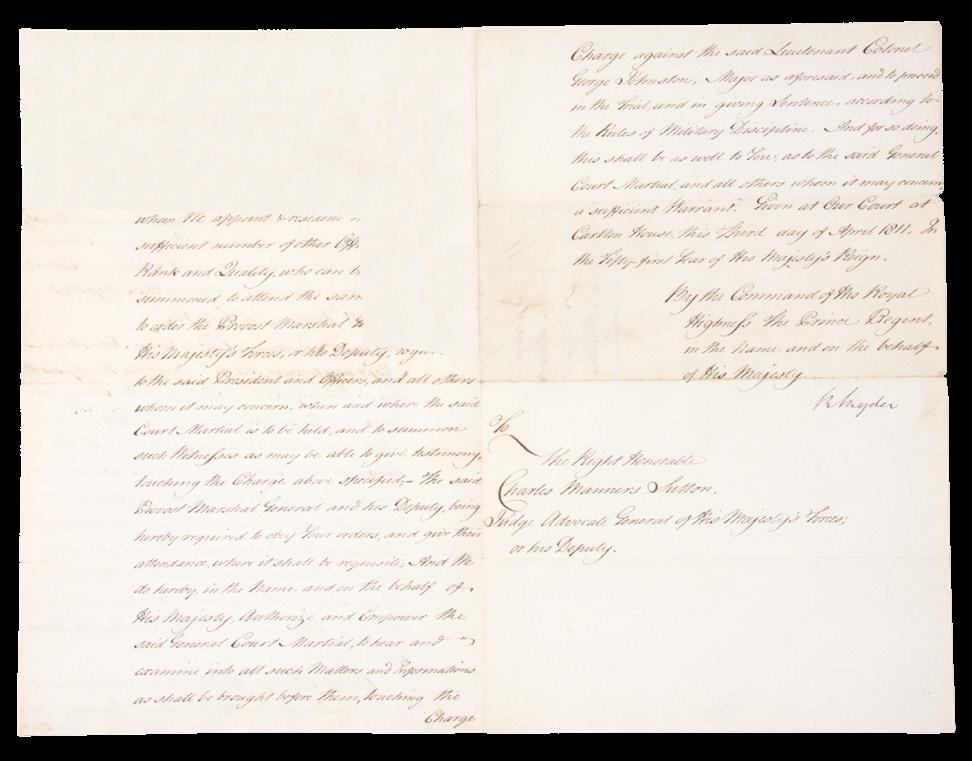
The Naturalist’s Pocket Book, Ornamented with most Elegant Engravings…
16mo (in 4s), 117 x 67mm; [2], iv, [28], 44 pp., hand-coloured frontispiece and 12 engraved plates by the English engraver Inigo Barlow of various animals and flowers; much of the text engraved; contemporary black morocco wallet binding, engraved silver catch and edges, yellow silk end-papers forming small document wallets. London, for G. Kearsley, Fleet Street, [1796].
A beautiful work of early natural history and a fascinating riddle: this rare eighteenthcentury pocket book and almanac, in a pretty presentation binding, features engravings of exotic birds and animals, most notably an echidna, two Australian birds and a third stated to be from the Pacific (probably in error, as it is more likely Australian as well).
This is the earliest of two recorded almanacs (a second appeared in 1797), both rare, issued by the enterprising publisher Kearsley, best known for a number of popular early books on Captain Cook. Delightfully presented in a black leather wallet, decorated in silverwork and lined with yellow silk, the initials “P.P. to A.W.” are finely engraved on the silver catch.
Impressively early for any work of Australian natural history, its engravings date from the period in the mid-1790s when such works had largely dried up in the market. More significantly, the plates are not merely slavish copies of other known illustrations, perhaps hinting that they were prepared from otherwise unknown specimens or drawings.
They are engraved by “Barlow”, now thought to be Inigo Barlow, an artisan who worked on a number of popular natural history works around this time and who had, like so many of his peers, some sort of connection with the famous Leverian Museum. Not only is the Museum mentioned in the text, but some of the descriptions seem to have been borrowed from George Shaw, who used the museum’s exotic collections extensively for the latest additions to his Naturalist’s Miscellany. Kearsley later published a series of lectures by Shaw, perhaps giving more heft to the connection.
The highlight among the diverse inclusions are the various natural history notes, chief among them the description of the “New Holland Animals … sent home by the English settlers in the region of Botany Bay.” The echidna is the obvious stand-out, being closely related to the early works by both the Port Jackson Painter and Thomas Watling, but quite different in detail. The same can be said of what is evidently the Turquoise Parrot (Neophema pulchella), a particularly beautiful bird that is relatively uncommon among works by the early artists and, most curious still, what is here called the “Scarlet Creeper,” which seems to be a most peculiar attempt at figuring the east coast bird the Scarlet myzomela , which at the time in England was categorised based on a very similar bird brought back from ‘Tanna’ (part of Vanuatu) by Cook.
$14,500
5001084 at hordern.com
ESTC; Hoe, A Catalogue of Books in English Later than 1700, Vol. II, p. 240; Schodde, ‘Towards stabilizing the nomenclature of Australian birds’ (1992).
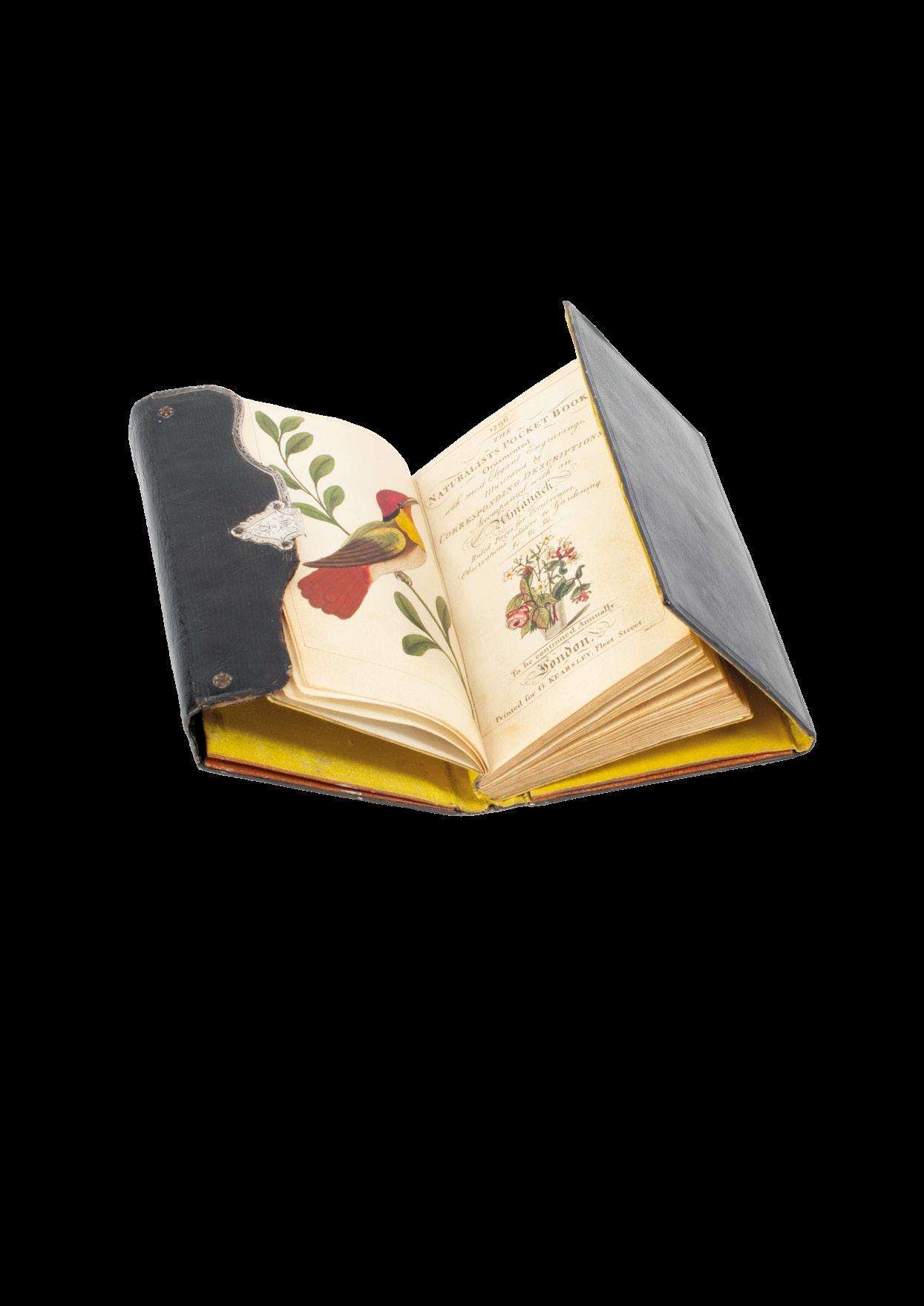
Narrative of a Survey of the Intertropical and Western Coasts of Australia. Performed between the years 1818 and 1822…
Two volumes, octavo, with a folding chart, 13 aquatint plates and a folding engraving; a very good copy, edges rough-trimmed only, in original plain boards binding with later spines.
London, John Murray, 1827.
First edition of this great book. Admiral Phillip Parker King, Australian-born son of the third governor Philip Gidley King, became the British navy’s leading hydrographer. His arduous Australian coastal voyages, made over the course of several years on the Mermaid and Bathurst, made an enormous contribution to the mapping of Australia, most importantly in the Great Barrier Reef and right across the north coast to the west. His detailed hydrographical work is still the basis of many of the modern charts for the areas he surveyed.
In the years after Waterloo, British interest in the largely uncharted northern and north-western coast of Australia had increased, partly out of concern at the territorial ambitions of other nations, most conspicuously the French expedition commanded by Freycinet. King therefore sailed from England in 1817, most unusually as the passenger on a transport ship, accompanied only by his wife and two junior officers. Without doubt the most remarkable part of King’s achievement was to complete a series of such remarkable and successful voyages with crews he fitted out from sailors living and working in Sydney.
The naturalist Allan Cunningham sailed with King, and the narrative includes comments on botanical and geological phenomena with nautical and hydrographic observations. The engraved views were taken from King’s own sketches.
This excellent uncut copy is an example of the regular issue (a few copies survive with an 1826 date on the title-pages, without any other points of difference: they may represent survivors of a presentation issue of some kind).
$7850
5001085 at hordern.com
Abbey, 573; Davidson, ‘A Book Collector’s Notes’, pp. 127-8; Ferguson, 1130; Mabberley, ‘Peter Crossing Collection‘, 129; Wantrup, 84b.
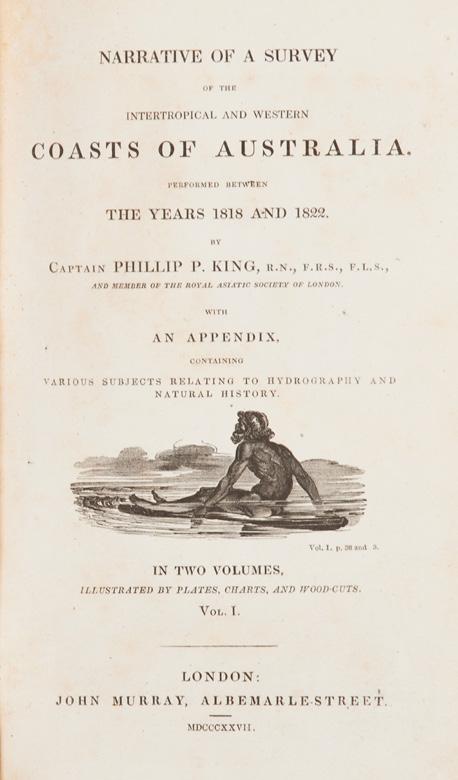

Voyage de la Pérouse autour du Monde, publié conformément au décret du 22 Avril 1791, et rédigé par M.L.A. Milet-Mureau.
Four volumes, quarto, and an atlas folio, frontispiece portrait of La Pérouse, atlas with engraved title and 69 engraved maps and plates (21 folding); a fine large copy of the text, completely uncut, the atlas also large and fine with the engraved plates all in strong and fresh impressions; quarter calf over old marbled boards with vellum tips, double labels, an excellent set.
Paris, Imprimerie de la République, An V (1797).
First edition of one of the finest narratives of maritime exploration ever published. This is an unusually bright and attractive set of this great book, in an excellent binding.
Just one year after Cook’s third voyage account was finally published and just before the First Fleet was first being outfitted, La Pérouse left France in 1785 as the great hope of Louis XVI, only to be lost after his visit to Botany Bay in 1788, vanishing “trackless into blue immensity” (Carlyle). Rumours about their fate tormented the French, none more than the King himself, who is supposed to have badgered his gaolers for the latest even as his own execution loomed (“Is there any news of M. de La Pérouse?”). The wrecks in Vanikoro were not discovered until the 1820s and questions about what exactly happened are still very much alive.
Fortunately La Pérouse was in the habit of forwarding reports home from friendly ports of call, meaning that it was possible to produce this magnificent official account, of paramount importance for the entire Pacific, from Japan, to Hawaii, to Spanish California, most famously including their tragic interaction with the Tlingit of Lituya Bay (as dramatised two centuries later by Carl Sagan in Cosmos).
The folio Atlas therefore includes magnificent maps of Russian Asia, Japan, California and the Pacific Northwest Coast, quite apart from the wonderful series of views and natural history illustrations, chiefly after the original drawings by the chief official artist, Gaspard Duché de Vancy, recently exhibited at the Musée de la Marine in Paris. The present example includes particularly rich and deep impressions throughout.
It is a particular irony of history that the last picture we have of La Pérouse is based on the warm and collegiate relations he had with the officers at Botany Bay. Watkin Tench was a close associate – at one point poring over a copy of Cook’s first voyage account with some of his French opposite numbers – but the last word probably belongs to Philip Gidley King, who noted in his journal that the French explorer has said to him ‘Enfin, Monsieur Cook a tant fait qu’il ne m’a rien laissé à faire que d’admirer ses oeuvres ’ [“Captain Cook has done so much that he has left me with nothing to do but admire his achievements’].
The first portion of the expedition’s records had been forwarded by sea from Macao; the second (Macao to Kamchatka) went overland with de Lesseps, and the final reports went back with British despatches from Botany Bay, the British extending what was then a normal courtesy between the exploring nations. It was from these records that Milet-Mureau, the editor, established the official narrative of the expedition for its publication in this form.
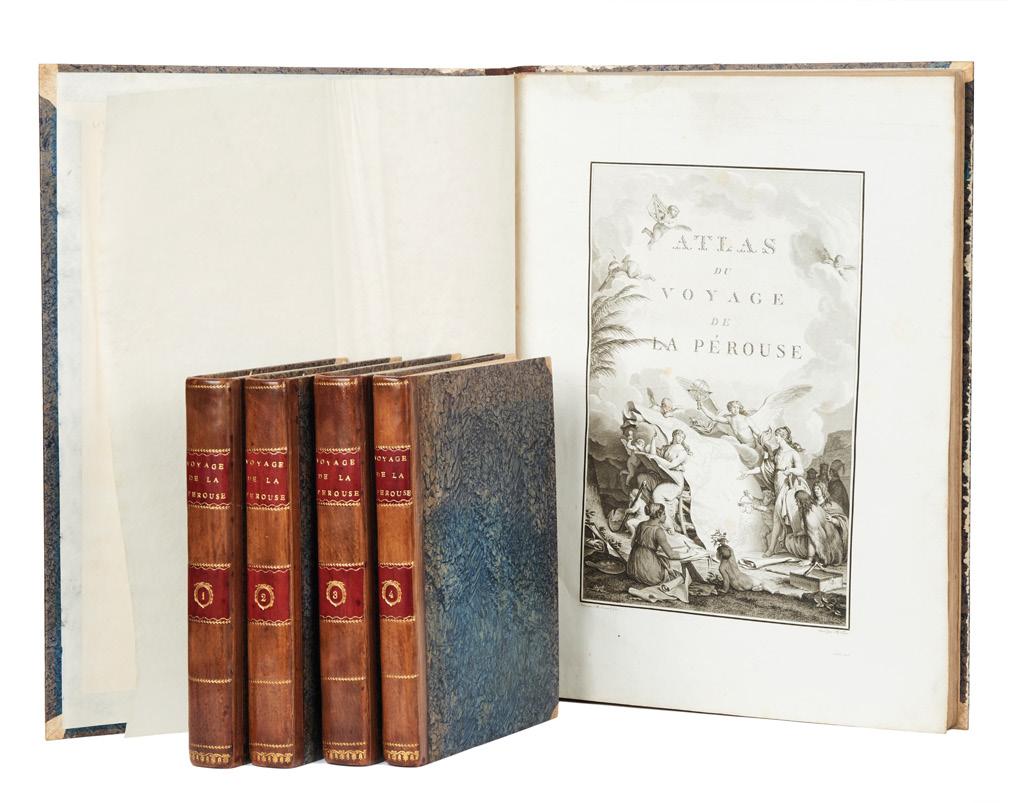
La Pérouse’s two ships sailed from Brest in 1785. On their way to the northwest coast of America they stopped in Chile, Easter Island and Hawaii, where they were the first Europeans to land on Maui. They followed the American coast from Alaska to southern California, then visiting Macau, Manila, Korea, the Pacific coast of Russia, Japan, and Samoa and exploring the central Pacific. Their main instructions, however, were to make for Australian waters to check on English activity in the region.
On 24 January 1788, two and a half years after their departure from France, La Pérouse’s ships sailed into Botany Bay just hours after the settlers under Governor Phillip began the move to Port Jackson. La Pérouse’s habit of forwarding records whenever he had an opportunity to do so ensured the survival of at least the narrative to that point.
Strikingly interpreted as engravings and printed here in rich dark impressions the maps and views were, as Christina Ionescu (Book Illustration in the Long Eighteenth Century) has noted, like the engravings in the huge Napoleonic Déscription de l’Egypte, continuing a tradition of “large and extravagant productions” at a time when more commercial publishers were generally downsizing the illustrative content of publications.
As Glyn Williams has characterised it, the French voyage was “A deliberate réplique française or counter-stroke to Cook’s voyages… a follow-up to Cook’s third voyage, [with] its instructions a running commentary on what Cook had discovered and left undiscovered….”
With regard to the meeting in Botany Bay it has been remarked that the friendship between the two nations grew in proportion to their distance from home. Certainly the English attitude to La Pérouse seemed natural to Watkin Tench: “during their stay in the port the officers of the two nations had frequent opportunities of testifying their mutual regard by visits and other interchanges of friendship and esteem;” and La Pérouse endeared himself particularly “by the feeling manner in which he always mentioned the name and talents of Captain Cook.
$45,000
5001090 at hordern.com
Allen “Check List”, p.4; Borba de Moraes, p. 449; Cowan, p. 383; Davidson, ‘A Book Collector’s Notes’, p. 100; Ferguson, 251; Forbes, ‘Hawaiian National Bibliography’, 272; ‘Hawaii One Hundred’, 12; Hill, 972; Judd, 102; Lada-Mocarski, 52; McLaren, ‘Lapérouse in the Pacific’, 1.
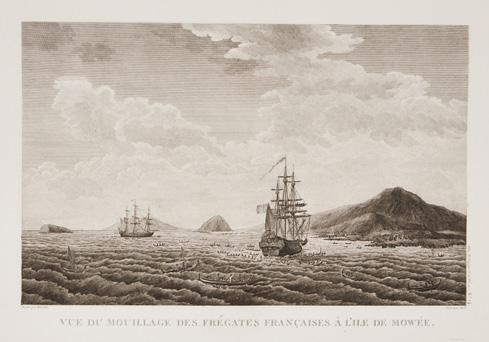
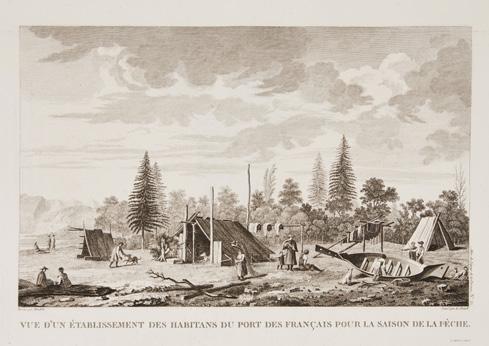

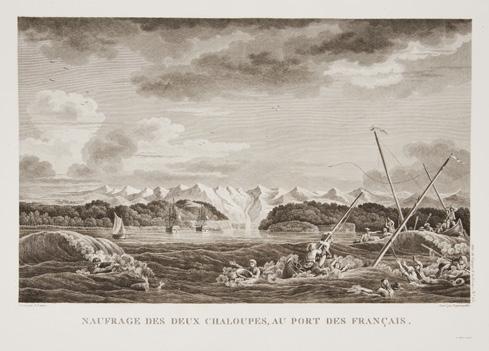
26. MACQUARIE, Governor Lachlan.
Handwritten note to Dr Arnold aboard HMS Hindostan.
Single sheet of folded notepaper, 225 x 183 mm, wove paper with no watermark; some wear at the edges and along the old fold, paper stub along left margin neatly trimmed (no doubt having been removed from an order or account book).
On board HMS Dromedary, 29 August 1809.
A handwritten note by Lachlan Macquarie, written en route to his appointment as Governor of New South Wales. One of the greatest figures of the early colony, examples of Macquarie’s handwriting are now very scarce, and almost all surviving examples have been held long-term by the major Australian institutions.
Macquarie’s early career saw him based in India, where he garnered a reputation as an astute officer. He returned to Scotland in 1807, and the following year he was ordered to sail for New South Wales as a serving lieutenant-colonel in the 73rd Regiment. Major-General Miles Nightingall had been awarded the governorship, but Macquarie boldly wrote to his Commander-in-Chief asking to be sent both as a full colonel and as Lieutenant-Governor, on the grounds that New South Wales provided no real possibility for promotion otherwise. Not only did he succeed in his ambition, when Nightingall changed his mind, Macquarie took the next step of asking to be sent as the Governor himself. Macquarie and his wife Elizabeth sailed on Dromedary on 22 May 1809, accompanied by HMS Hindostan
The note is written after their landfall at Rio, but before they arrived in Cape Town, and is addressed to Joseph Arnold, a naval surgeon detailed to convey the 73rd to Sydney. It relates to the medical stores on board the two vessels, and shows Macquarie continuing his careful management of all aspects of his command. After apologising for not being in a position to reply earlier, Macquarie writes that he ‘has now the pleasure of sending herewith the greater part of the Medicines required by Doctor Arnold.’
Although Arnold duly returned on the Hindostan, he would have more than a passing acquaintance with Sydney, returning in 1815 with the female convict transport Northampton, the first surgeon-superintendent of a convict ship appointed on the British government’s adoption of that system. It is not possible to say too much about the relationship between Macquarie and Arnold, although a note in the ADB is apropos: Arnold ‘contemplated settling in Sydney to practise but, partly because Macquarie ignored him and partly because he was unable to reduce his living expenses below 13s. a day, he relinquished the idea and took passage for England in the Indefatigable.’
$8250
5001102 at hordern.com
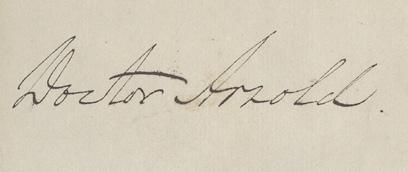

“THE GIFT OF VISCT. STRATHALLAN TO L. MACQUARIE ESQR. 1825”
A gold pendant compass given to Lachlan Macquarie junior by Viscount Strathallan, inscribed “The gift of Visct. Strathallan to L. Macquarie Esqr. 1825”.
Compass, 25 mm diameter, set under crystal in a high-carat (probably 18 ct) gold pendant, 45 mm length, swivelling on release of a small catch, with incised inscription around the outer edge; later fitted case.
Scotland (?), c. 1825.
This precious object was given in 1825 by James Drummond, Viscount Strathallan, to his godson and protégé, the eleven-year-old Lachlan Macquarie the younger, Sydney-born son of the greatest early governor of New South Wales. The gift, with its affectionate engraved inscription, made in the year following Governor Macquarie’s death, may well have been to mark the beginning of Strathallan’s guardianship of the young boy.
“Undoubtedly the high moment of Macquarie’s stay in the colony and perhaps of his life, was the birth on 28 March 1814… of his son whom he gently allowed Elizabeth to name Lachlan after him. Their happiness on earth, he noted in his memorandum book, was now complete. For the last decade of his life Macquarie found a happy refuge from his worries in the role of doting father” (N. D. McLachlan in ADB). Two delightful portraits of the child (State Library of New South Wales), one of them by Richard Read senior, have often been exhibited or reproduced.
James Drummond (1767-1851), restored in 1824 to the viscountcy of Strathallan (it had been attainted after the battle of Culloden in 1746), was a close friend of Macquarie, and one of those who had defended the governor after the damaging release of the Bigge report. The two men had met in Macquarie’s Indian days, and kept close contact over the ensuing decades. When Macquarie died in 1824 his estate passed into the hands of his son, under the administration of Strathallan, executor of Macquarie’s estate as well as guardian of his son, then ten years old. Lachlan junior became a close friend of his guardian’s own son William Drummond, “Master of Strathallan”.
“During his final years, all the old Governor’s hopes and dreams had centred on his son and heir” (Pauline Conolly), but Lachlan junior eventually had to borrow extensively from his friend the Master of Strathallan to fund a wayward lifestyle, ultimately needing to alter his will to meet his debts. At his death the will was challenged, in a bitterly contested court battle, but in the end most of his estate went to repay Strathallan and thus passed into the Drummond family. Various possessions remained in Strathallan Castle, with gradual dispersals over the last century. Perhaps the most famous object to have that provenance is the consequently named Strathallan Chest or Cabinet (also known as the Macquarie Collector’s Chest), today one of the treasures of the State Library of New South Wales.
$35,000
5001101 at hordern.com
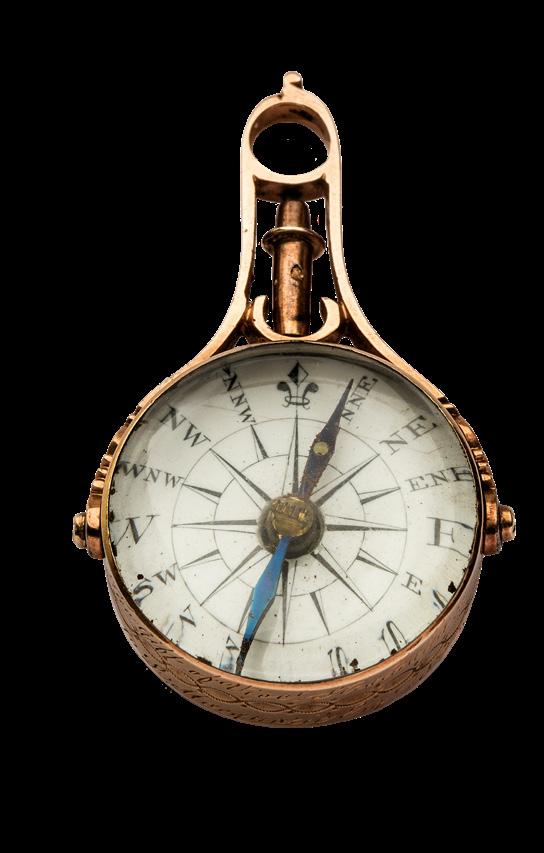
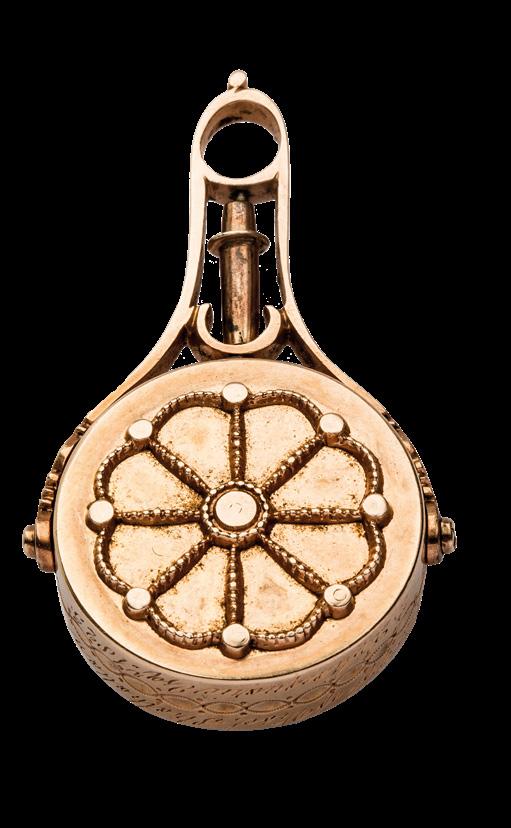
Earnshaw-type Naval Chronometer no. 640, carried successively on board HMS Fly and then on HMS Rattlesnake for the survey of the Australian coast.
Fine marine box chronometer, 3-inch silvered dial signed “James Murray Royal Exchange” on the face, brass casing and gimbal, in the original brass-inlaid mahogany box (135 x 135 x 135 mm.), ivory lozenge to front reading “Murray 640”, original handles and pierced winding key; small seconds hand an old replacement, lacks locking key and one of the small brass inlays, but a most attractive example in fine original condition.
London, James Murray in the Royal Exchange, circa 1829.
A fine and most attractive Regency era marine chronometer by the London maker James Murray, carried on HMS Fly and then HMS Rattlesnake (see items 29-30), the two vessels sent by the Admiralty in the 1840s to complete the coastal surveys begun by the Beagle, which carried out explorations on the Queensland coast, the Great Barrier Reef and the Torres Strait, as well as the treacherous Inner Passage. A map from the Rattlesnake account (see item 30) is illustrated opposite.
Recorded as “K” in Shadwell’s important contemporary book On the Management of Chronometers (1855), this is the only example of such a crucial instrument known to be extant from either the Fly or Rattlesnake voyages. Despite their fundamental importance to survey voyages and their longevity, most of these early instruments are considered lost, marking out the present example as an extremely rare and important survivor.
The tremendous value of the chronometer for accurate mapping had been proved as early as Cook’s second voyage, and accurate timekeepers were the fundamental equipment required for any ship being sent on the arduous Australian surveys. Official timekeepers and scientific instruments relating to the golden age of Australian maritime survey voyages are, of course, exceptionally rare: to cite a meaningful example, of the more than 40 (and probably 50) official chronometers which accompanied the three voyages of HMS Beagle, only two are now known, both held by the British Museum, one of which was listed (as no. 91) in Neil Macgregor’s A History of the World in 100 Objects.
The maker James Murray flourished in London in the 1820s, received Admiralty awards for the accuracy of his chronometers in 1824 and 1830, and has been called the “distinguished Artist who has had the honour of producing the best instrument ever known” (Tony Mercer, Chronometer Makers of the World ). Murray’s chronometers are known to have been used on any number of major voyages, including that of Weddell to the Antarctic and Parry to the Northwest Passage.
As the Admiralty tables for this chronometer confirm, it was supplied to the Fly on 7 March 1842, and official Admiralty records show it as only returned for servicing by officers of the Rattlesnake in 1850.
$84,000
5001114 at hordern.com
Shadwell, On the Management of Chronometers, “K” (1855); Jukes, Narrative of the Surveying Voyage of HMS Fly (1847); Macgillivray, Narrative of the Voyage of HMS Rattlesnake (1852).
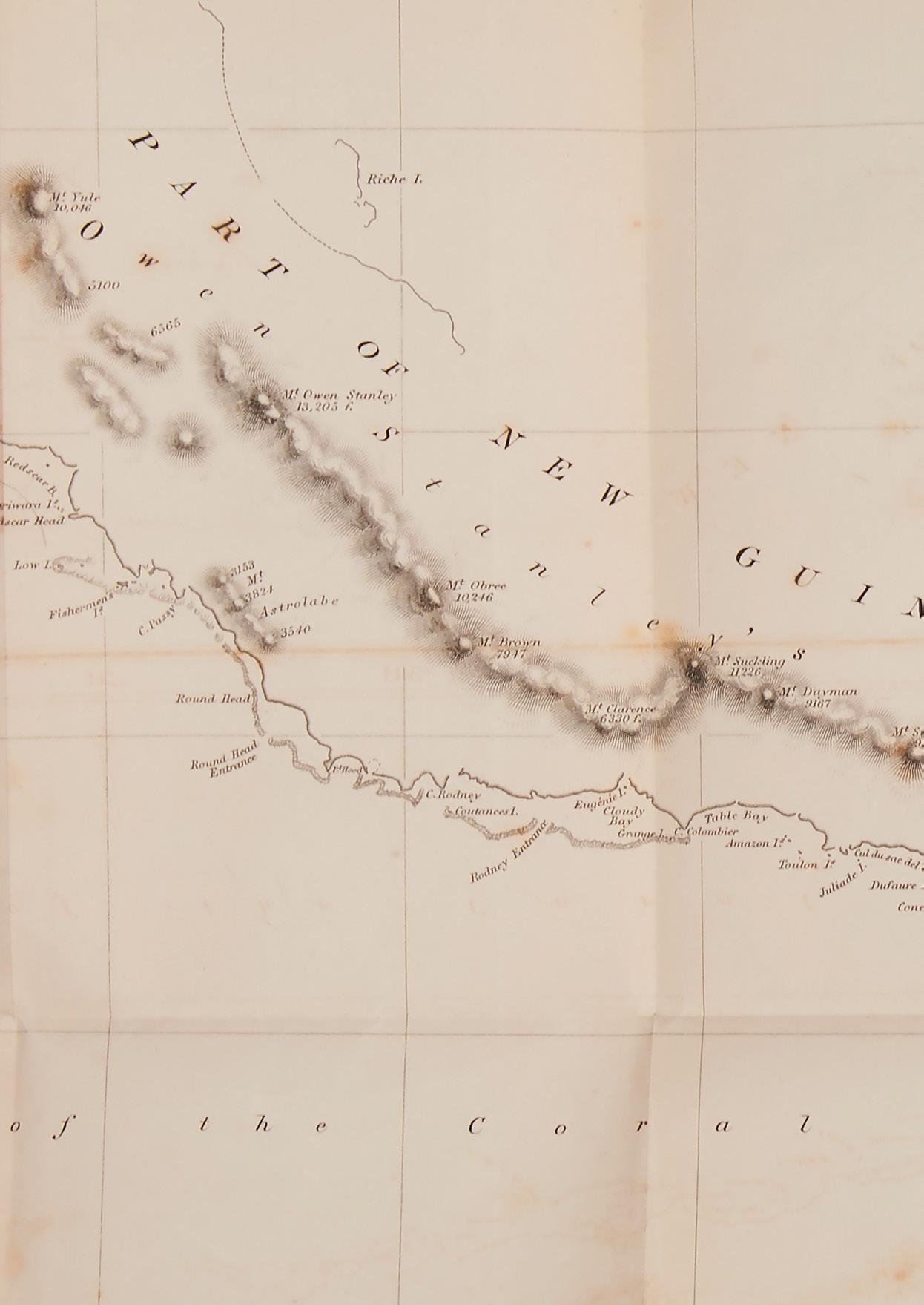

The next two catalogue entries give the full accounts of the two major coastal survey voyages that used the Murray chronometer (described in previous item, no. 28), while exploring the Great Barrier Reef, the Queensland coast, and further north in the Torres Strait and New Guinea.
Narrative of the Surveying Voyage of H.M.S. Fly, commanded by Captain F.P. Blackwood, R.N. in Torres Strait, New Guinea, and other islands of the Eastern Archipelago…
Two volumes, octavo, with many engravings (full-page and in-text), and two folding maps; a fine set in a handsome 19th century binding of half polished calf.
London, T. & W. Boone, 1847.
First edition: the Fly ’s surveying voyage of coastal Australia. Jukes’ account is particularly significant for his description of the Queensland coast, the Great Barrier Reef, and the Torres Strait, and includes an impressively detailed map of the north-east coast from Endeavour River north to New Guinea. Numerous encounters with native peoples, particularly in the Torres Strait are described in the text and illustrated in the splendid plates, mostly by Harden S. Melville, who published his own illustrated work on the voyage (Sketches in Australia and the Adjacent Islands, 1849).
$6800
5001083 at hordern.com
Ferguson, 4549; Hill, 901; Wantrup, 92a.
Narrative of the Voyage of H.M.S. Rattlesnake commanded by the late Captain Owen Stanley … including discoveries and surveys in New Guinea, the Louisiade Archipelago, etc …
Two volumes, octavo, 13 plates and a folding chart; a fine set in the original publisher’s binding of dark blue blind-embossed cloth boards with title lettered in gold on spines. London, T. & W. Boone, 1852.
A fine copy of the first edition: the last and most difficult to find of the great exploration journals published by Boone during the heroic age of Australian exploration. The Rattlesnake completed the important series of hydrographical voyages undertaken by the Admiralty in the late 1840s to chart the Great Barrier Reef and north coast, as well as the southern coast of New Guinea.
$7250
5001100 at hordern.com
Ferguson, 11972; Hill, 1060; Wantrup, 145 (noting 14 plates in error).
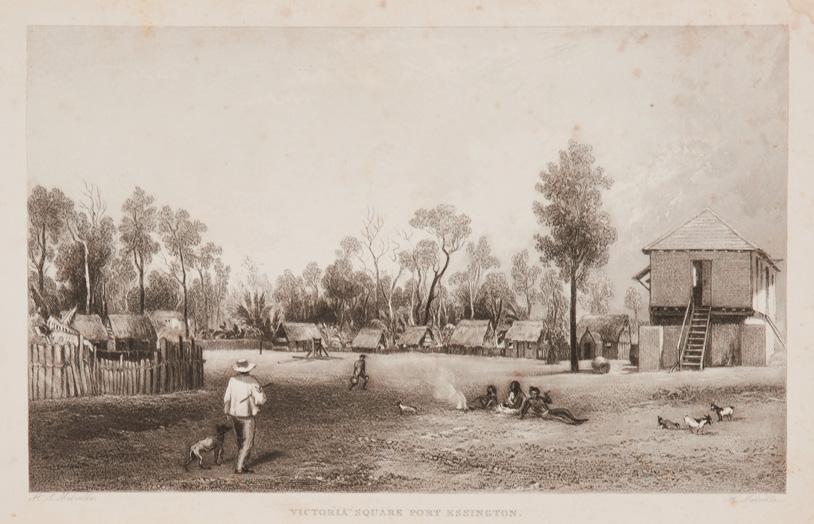

Original manuscript document of 1788 detailing sentences for prisoners on the Second and Third Fleets to Australia… Docket title: 20 June 1788. Warrant for Execution of Willm. James also Levi [and three others]… Respited Sarah Mills [and nine others]…
Double sided folio sheet, 325 x 205 mm, housed in a specially made solander case. Newgate Gaol, City of London, 20 June 1788.
A remarkable original document giving a vivid snapshot of early Australian history, listing the sentences recorded at Newgate, from the Old Bailey, in June 1788.
Here are the names of a fascinating cross-section of prison life, many of whom would be dispatched on some of the notorious ships to follow the First Fleet, including several who were on the appalling Second Fleet which arrived in mid-1790: each name captures a convicted man or woman at the moment their fate was decided. Recent research allows us to unravel many of their later lives, none more dramatic than John Cobcroft, who sailed for New South Wales with his common law wife, Sarah Smith, he becoming a prominent farmer and she a midwife. Few manuscripts more neatly capture the dramatic fortunes of those caught up in the great machinery of transportation.
Written at Newgate Gaol in the City of London, signed by John Adair, Recorder, the senior judge in the City during the 1780s, with his ominously black wax seal, the document sets out fourteen death sentences. Most would later be pardoned and would accept the option of being transported to New South Wales instead. The document reflects the pressing problems in 18th-century England of the severity of capital sentencing, the search for alternatives and the overcrowding of gaols – major issues that helped to ensure the successful adoption of transportation to Australia.
Of the nine subsequently transported the document identifies two women, Mary Hook and Catherine Heyland, who as women would have been selected from the group to sail on the first ship to reach New South Wales after the First Fleet, the notorious Lady Juliana , sometimes harshly characterised as a floating brothel. Five more came out on the infamous Second Fleet, rife with starvation and disease. Three of these five, John Cobcroft, John Wood and William Stubbs (or Fubbs, “otherwise Fielder otherwise Jack the Gardner”), were together charged with highway robbery and initially sentenced to death. George Dunstan of London and James Wilkinson of Middlesex were also transported for life in the same Fleet.
Lastly, Michael Hoy of London and Sarah Mills of Middlesex came out on the Third Fleet arriving in 1791. That fleet of 11 ships carried over 2000 convicts and although conditions had supposedly improved, the death rate was again extremely high.
Further details of the persons named on the document and their outcomes can be seen on our website.
$34,000
5001116 at hordern.com

Land Grant to Robert Webb of sixty acres for “Webbs Farm” beside the Parramatta River.
Manuscript in ink, 380 x 280 mm., on thick paper with the undated watermark of “J. Honig & Zoonen”; old folds, slightly aged/darkened, original ribbon present but the seal gone; tipped into a modern half morocco binding. Sydney, 22 February 1792.
A remarkable survival, only the second land grant ever issued in the new colony and one of the finest assemblages of First Fleet signatures on any single document. Although exhibiting some damage, it is remarkable that it has survived at all, doubly so as it is on thick laid paper rather than the more substantial vellum of later examples. The paper itself is of interest given the scarcity of materials in the new colony: with the watermark of Honig and Zoonen, papermakers active to 1787 in Zaandyk outside Amsterdam, it is likely to have made its way to New South Wales after being taken aboard either at the Cape or in Batavia.
Phillip arrived in Port Jackson with instructions to grant every emancipated convict thirty acres, or fifty should they be married. He proved quite selective with the whole process (unlike some of his successors), and by the end of his governorship had made only ninety-five grants. Very few of those original grants have survived intact, underlining their considerable rarity. Webb’s, the second such, marked no. 2 on the official list, was preceded only by that given to James Ruse, who was allowed 30 acres while Webb received 60 acres “on the north side of the creek leading to Parramatta.”
The signatories are a who’s-who of the early colony’s inner circle, as it is witnessed not only by the surgeon John White, but also by the senior officer George Johnston and the purser on board the Sirius, John Palmer, while it is also prominently signed by David Collins, Judge Advocate for the colony, here described as “secretary” to the governor. Only the earliest land grants feature such senior figures. None of the signatures are at all common (White’s is notoriously rare), but that of Phillip is a black pearl of early Australia, only offered for sale a few times in decades.
Robert Webb had been a sailor on the Sirius but sold out after a stint at Norfolk Island, going into partnership with his brother Thomas. His small hut on the property was built for him at Phillip’s order, and his farm is actually described in Tench’s second book. They did not make a go of it: Thomas died on the Hawkesbury in 1795, and Robert sold up in 1798, dying on board the Reliance en route for England the following year. The property subsequently became the dowry which Jennett Melville brought to her marriage with George Evans, later the colony’s surveyor-general.
$45,000
5001120 at hordern.com

Copper proof strike of the Royal Society Medal, in commemoration of Captain Cook.
Bronzed copper disc with proof strike of the obverse of the Cook Royal Society medal (with Cook’s portrait in profile), the medal 43 mm within disc measuring approx. 93 mm diameter.
London, Royal Society, 1784.
A bronzed-copper proof strike of the Royal Society Medal: no comparable example is recorded, and this represents an important and interesting insight into the minting of the famous Royal Society Medal in memory of Captain Cook. This is an exceptionally interesting survival, giving evidence of the actual process by which Pingo produced the famous medal.
Although the medal was not ultimately issued until 1784, the initial plans were made during the very first weeks after news of Cook’s death reached London. As President of the Royal Society, and as Cook’s old shipmate on the Endeavour, Joseph Banks was driven to make a medal to commemorate the loss, and formally mooted the project as early as 27 January 1780. Much taken with the idea – Cook was not only the greatest navigator of his generation, but a recipient of the Society’s prestigious Copley Medal – the Society resolved that a medal was “to be struck expressive of his deserts” and would be paid for by voluntary subscription. The project was taken up with great enthusiasm by the Fellows of the Society (the Pacific explorer Bougainville was just one of many who wrote to Banks hoping to be considered to receive a medal: The Banks Letters, ed. W.R. Dawson, 1958, p. 122).
Design entries were accepted from many different people, but it was the sketches of the Chief Engraver of the London Mint, Lewis Pingo, submitted by June of 1780, which took their fancy. Pingo’s design would have been prepared in a wax or plaster intaglio, then engraved directly into the steel block for the minting process. Once the block was hardened, trial stampings would have been conducted, initially in lead (because of its softness) but then in copper, presumably as a more rigorous test for the die. L. Richard Smith hypothesises, no doubt accurately, that Banks’s own experience with the infamous cracking of the die on the earlier “Resolution and Adventure” medal would have led him to be unusually cautious in this regard.
Thanks to the research of L. Richard Smith, the process of creating the medals is known in some detail. The die was ordered to be prepared on 15 June 1780 although, for reasons unknown, it was not until 20 November 1783 that Banks announced that the dye was finished, and that Pingo had “produced an impression taken in lead taken from the same.” The first five gold medals were struck in January 1784.
$16,500
6000011 at hordern.com
Beddie, 2790; Betts, American Colonial History Illustrated by Contemporary Medals, 553; Brown, British Historical Medals, 258; Klenman, K5; Marquess of Milford Haven, ‘British and Foreign Naval Medals’, 734; Mira, Captain Cook: his coins & medals, pp. 35-7; Nan Kivell & Spence, Portraits of the Famous and Infamous, p.72; L. Richard Smith, The Royal Society Cook Medal (1982).

Autograph letter signed on the production of the Royal Society Medal in honour of Captain Cook.
Single leaf, 230 x 185 mm., on laid paper, autograph letter in Joseph Banks’s hand, later attribution ‘Sr. Joseph Banks, Bart. 4th March 1784’ in a different hand. London, Soho Square, 4 March 1784.
This wonderful letter by Banks is a rare example of any of his correspondence directly relating to Cook still in private hands.
Banks here effectively signs off on the production of the Royal Society medal (and confirms his central involvement in its design), writing that “Mr. Pingo has executed the Commission which at your desire he undertook very much to my satisfaction. I should be obliged to you if you could take the trouble of informing me what sort of a Present you think should be made to him by the Society”.
Although not explicitly named in the letter, we now believe the recipient was most likely Joseph Planta, a well-known antiquary who worked for many years at the British Museum. Stating that the medal had been commissioned “at your desire,” the letter must have been addressed to one of the two secretaries of the Royal Society who, as the historian of the medal’s production L. Richard Smith has commented, had given Pingo the job. Banks had a very thick skin, but it is hard to believe even he could have written so politely and helpfully to the other secretary, Paul Henry Maty, who was then openly canvassing for Banks for be forced out of the Presidency of the Society and who, unsuccessful in his bid, would himself resign in March 1784.
On balance, Planta is also a more natural fit, not only because he was pro-Banks in the squabble, but because the more antiquarian content of the rest of the letter, which records Banks’s research into family history and armorial queries from St. Martin’s Church in Lincoln (not far from Banks’s house, Revesby Abbey), is very much in keeping with Planta’s interests. More, Planta must have been heavily involved in the production as he was presented with one of the gold examples as thanks from the Society in June, a rare and very telling honour given that most went to grandees across Europe.
Banks was the driving force behind the entire project to coincide with the ‘publication of the narrative of the tragic third voyage’ (H.B. Carter, Sir Joseph Banks, 1988, p. 168).
The letter has a storied provenance: it was first recorded in a bookseller’s catalogue as long ago as 1935, by mid-century was one of the treasures of the library of the Australian collector George Mackaness, later belonged to Rodney Davidson, and was only relatively recently catalogued by us as part of the collection of Robert Parks (2009).
$44,000
5001126 at hordern.com
Dawson, The Banks Letters; Mackaness, The Art of Book-Collecting in Australia, p. 12; L. Richard Smith, The Royal Society Cook Medal (1982); Thornton, ‘The Royal Society’s Captain Cook Medal,’ Cook’s Log (2008); Weld, A History of the Royal Society (1848).


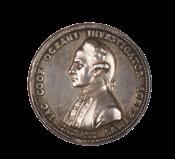
35. SMITH, Isaac.
Autograph letter signed to John D. Blake, dealing with financial matters.
Quarto, manuscript in ink on paper, four pages on one folded leaf; one margin torn from opening under seal, red wax seal intact, soiling around old folds but in excellent condition, paper watermarked 1821; in a purpose-made quarter morocco case.
Clapham, London, 5 December 1821.
A rare letter from an important figure: the first man to step ashore from the Endeavour following Captain Cook’s discovery of the east coast of Australia.
Isaac Smith (1752-1831) was one of only five crew members on the Endeavour who had previously worked with Cook, having sailed with him on the Grenville on the earlier Newfoundland expedition. Smith was actually the cousin of Cook’s wife; according to Beaglehole he “became very proficient in helping Cook with surveys and charts. Both he and Manley earned praise; they were ‘both too young for preferment, yet their behaviour merits the best recommendation’….”
Smith’s place in history was secured with the words “Isaac, you shall land first”, which Cook is said to have uttered on Sunday 29 April 1770, as he prepared to make his momentous landing at Kurnell, Botany Bay. Smith was thus the first man to step ashore on Australia’s east coast.
Isaac Smith’s naval career flourished throughout the next decades. He was master’s mate on the second voyage ship Resolution, lieutenant in the sloop Weazle, and eventually commander of a ship in the East Indies under Commodore Cornwallis. In 1807, although by this time very ill, he was appointed rear-admiral.
Isaac was particularly close to Elizabeth Cook, and after his retirement spent the winters with her at her house in Clapham. His own residence was Merton Abbey, Surrey. The Clapham house “was crowded and crammed in every room with relics, curiosities, drawings, maps and collections brought home from the voyages” (Besant).
The Smith family were bequeathed a large portion of Elizabeth’s estate on her death, and it is thought that the family inherited the logs, journals and charts. In 1830, a Captain John Smith writes that “his relative, Mrs. Cook… has lately placed in his possession all the remaining books, charts and instruments formerly belonging to her renowned husband” (Marshall, p.419).
The letter, to a probate lawyer, is a long and detailed account to do with the execution of a will, and was written from Ms Cook’s Clapham house. Examples of Smith’s manuscript are very scarce, despite his long life.
$22,000
5001128 at hordern.com
Besaant, Captain Cook (1890); Marshall, Royal Naval Biography.
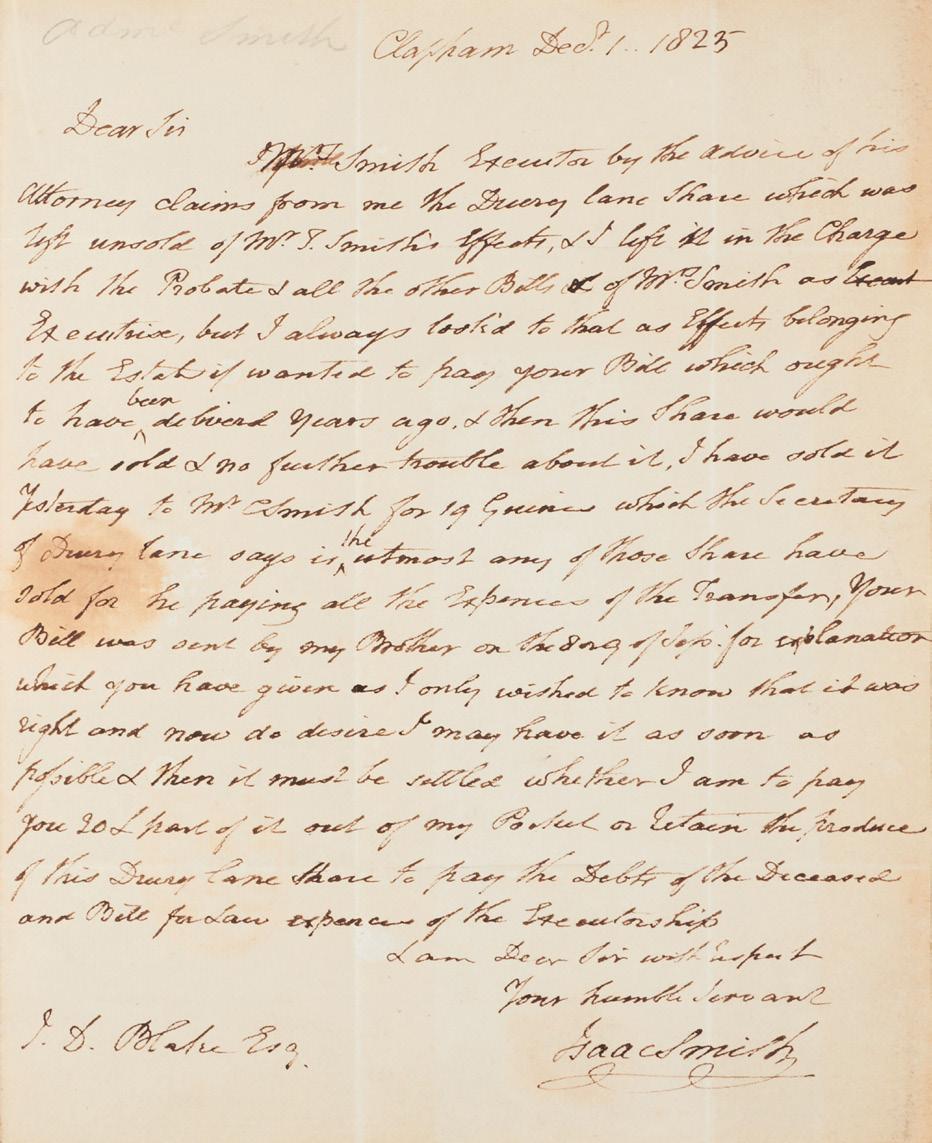
36. SMITH, Isaac.
Mourning ring.
Diamond, pearl and enamel set into a gold ring with the following inscription engraved on the inside of the band: “Rear-Adml Isaac Smith Ob 2 July 1831 Ob 78”. Housed in a crimson morocco box with brass clasp. London, maker unknown, c. 1831.

A poignant survival: a mourning ring for the memory of Rear-Admiral Isaac Smith (1752-1831).
Smith, who had served on Cook’s first and second Pacific voyages, is especially remembered as the first Englishman to have set foot on the east coast of the Australian continent. The landing was made after the intruders had been challenged by two Gweagal warriors, and musket shots had been fired. Cook, who had told him “Isaac, you shall land first”, ordered the young man to “Jump out, Isaac!” Although Smith’s stepping onto Gweagal land carries with it immense symbolic significance, it should also be noted that he was one of three men, including Lieutenant Zachary Hicks and Surgeon William Monkhouse, who collected short lists of words from the language of the Gweagal with whom they interacted during the Endeavour’s brief sojourn at Kamay. These words survived in a manuscript that was later compiled by William Lanyon, a shipmate of Smith on Cook’s second voyage. Fortunately, this manuscript was published in 1979 by Lanyon’s descendant, linguist Dr Peter Lanyon-Orgill, prior to its being lost. The existence of these wordlists suggests that at least some friendly encounters between the Europeans and the Gweagal must have taken place.
Smith served on both Cook’s first and second voyages to the Pacific. He was related to Cook by marriage, as he was the cousin of Elizabeth Cook, the commander’s wife. On both voyages – on the second, as master’s mate – Smith assisted with surveying and cartography. He was given his own command after his return from the second voyage in 1775. He continued to serve in the Royal Navy until 1794, when ill-health forced his retirement. Smith spent much of his remaining years domiciled in Clapham with his cousin, Elizabeth Cook, where he died in 1831. In his will, dated 18 December 1827, Smith bequeathed “unto my dearest Cousin Mrs Eliz Cook of Clapham in Surrey two hundred guineas for a ring and mourning and all or any part of my effects in plate books or furniture at her house at Clapham she may choose to accept as a mark of my great regard and respect for her knowing she does not wish a larger legacy.” He also left nineteen pounds for the son and daughters of his late cousin Charles Smith “for a ring of remembrance” and eighteen for the same to both Elizabeth Ann Stuart and Mary Marston. The Captain Cook Museum in Whitby holds one of the aforementioned rings, which is identical in all respects – including the engraved legend – to the ring offered here. It is likely that all of these rings were made by the same jeweller.
$45,000
5001127 at hordern.com
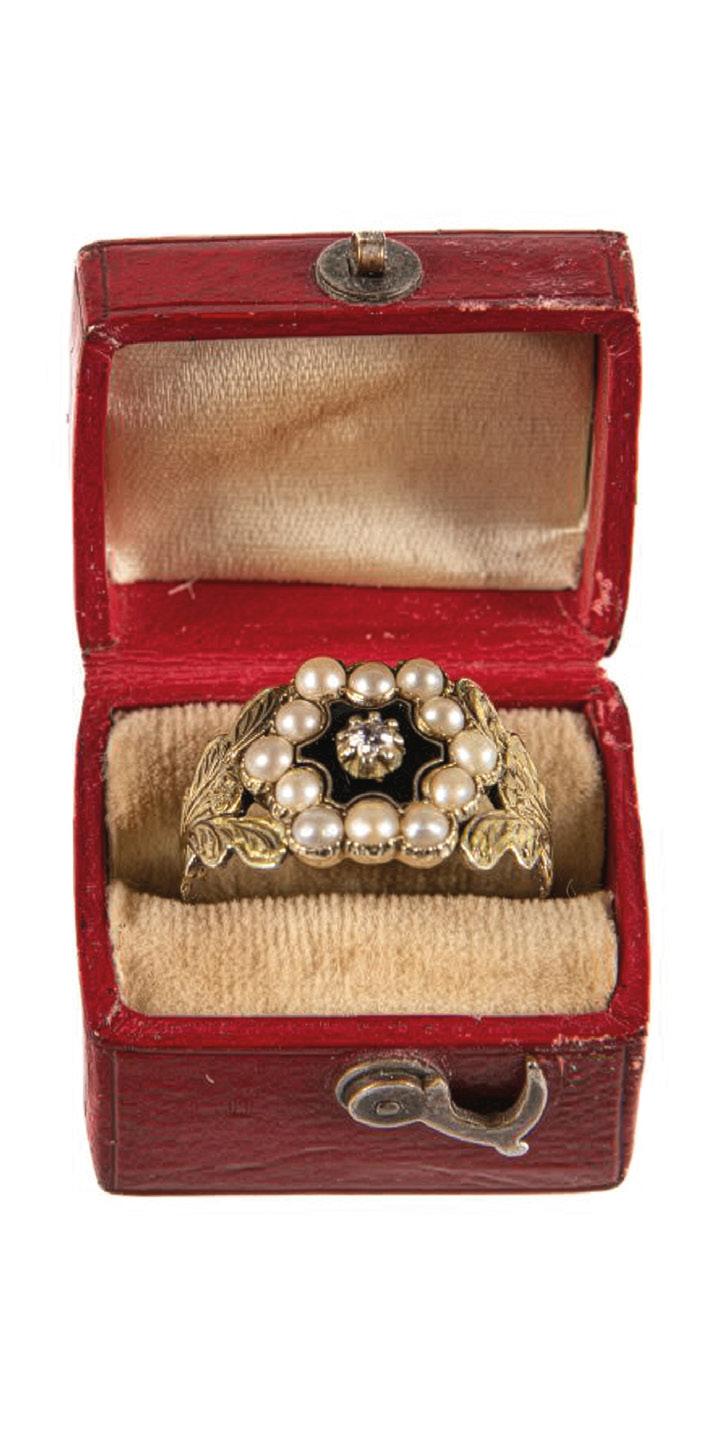
“TO
A Proposal for an Attempt to discover more fully the great Southern Continent, as well as the NE & NW passages from thence to Europe, by one and the same Squadron (1764) [accompanied by extracts from logs and sailing directions]. Folio, manuscript on paper, 43 leaves, stitched in plain grey wrappers (detached), in excellent unsophisticated condition in original notebook binding; quarter morocco case.
Place of creation uncertain, perhaps involving India or the East Indies, circa 1764.
A most important original manuscript, the long and well-argued core part of which makes the case for Australian settlement, at a notably early date, as the key to the entire region of the East Indies and the Pacific. This early analytical document is an ambitious Proposal to explore the Pacific and settle the Australian mainland with a Naval Squadron in the 1760s. It occupies 18 leaves of the manuscript and is surrounded by another 20 leaves with relevant accounts by both naval and East India Company captains regarding the Indian Ocean and sailing to the East Indies and China.
One of the related pieces that accompany the Proposal, remarkably significant in this regard, quotes from the works of the East Indies skipper, Capt. William Nichelson, on the importance of coasting western Australia very closely when crossing the Indian Ocean.
The manuscript remains unpublished to date. It was first offered for sale in modern times in the 1926 catalogue of the London bookseller Francis Edwards, The Sea and its Story, but its subsequent whereabouts remain obscure until its 2001 rediscovery, since when it has been in two private collections. It has been considered and discussed by a number of voyage experts, including Andrew Cook, Glyn Williams, Raymond Howgego, William Fern and Alan Frost.
As the accompanying context suggests, rather than looking back to the broadly mythical Great Southern Land so beloved of cartographers, the author expounds what might better be called a vision of New Holland, defining an area which broadly covers the actual Australian mainland (albeit exaggerating its extent to the eastward). Such a land, the author surmises, must be rich, fertile and happy, as well as being – an important admission in terms of the long view of Australian history – “not unlikely populous”.
Dating from a period of scrupulous secrecy at the Admiralty, the discussion is considered to have influenced the actual planning of the expedition to the Pacific of Capt. John Byron, the first of the post-war voyages of exploration and the vanguard of Wallis, Carteret and Cook. Many key aspects foreshadow British policy from Cook to the First Fleet: in tone and impact the Proposal echoes the persuasive reports and memorials on New South Wales submitted to government in the early 1780s (most famously by the Endeavour voyage veteran Matra).
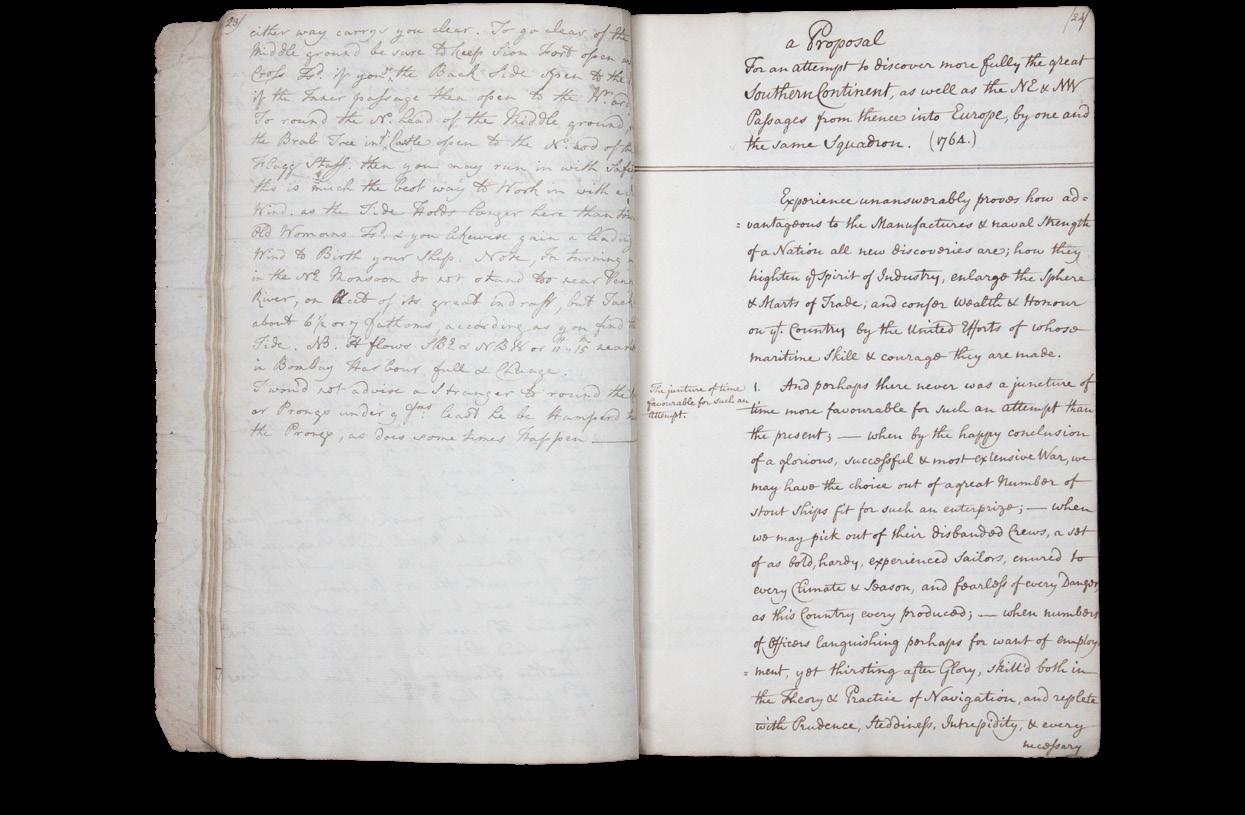
The work is dated 1764, the very time when the Admiralty explicitly turned to the Pacific, the recent peace with France providing the opportunity to fulfil Dampier’s long-held ambition of establishing a settlement on the eastern coast of New Holland. Take your pick, the memorialist announces, of the “stout” ships back from abroad, their officers languishing on half-pay but still “thirsting after glory” and the “bold, hardy experienced sailors” from their crews. Not least, strike while there was a “young & noble minded Monarch on the throne” – George III had been crowned in late 1760.
The late Alan Frost, maritime historian, who wrote a lengthy report on the manuscript many years ago, considered the proposal to have been an important precursor to the actual Pacific expedition mounted by Byron. Not least, as Frost discovered, the author definitely used John Campbell’s edition of Harris’s Navigantium atque itinerantium bibliotheca, the great compendium of voyages which included major accounts of Pelsaert, Tasman and Dampier.
A copy of the Harris/Cambell book is described at catalogue no. 20; both it and Callander’s Terra Australis Cognita (1766-68, catalogue no. 10) were also making a case in the 1760s for the exploration and development of the southern continent, just a few years before Cook would sort out the actual geography on the Endeavour voyage. Callander’s case, essentially based on the French writers Maupertuis and De Brosses, was simpler in conception, while the Proposal outlines an entirely different, ambitious and idiosyncratic plan to set up a base in the Falklands, to explore the Straits of Magellan and then Juan Fernandez, to traverse the Pacific, and to establish settlements on the Australian coast. These bases could then be used for trade with the entire region, but also further investigation of both remoter Australian shores and what we would now call the Bering Strait and beyond. The plan therefore looks back to the fondest dream of the recently deceased hero Lord Anson, but updates it with the real data of East India captains, always keeping uppermost the need for the continued promotion of genuinely practical needs: longitude, fresh water, the health and well-being of the sailors.
There is also an awareness of all manner of quite secret information regarding trade and science – the rumour, for example, that the Spanish had returned to the Juan Fernandez Islands after Anson’s visit; or the comment, seemingly backed up by the other pieces in the volume, that the author had compared some of the many journals of officers on discovery which had been suppressed by “invidious, interested & falselypolitical Motives.”
To date, no subsequent version of the Proposal has appeared. The Royal Archives do not have anything to suggest that it ever made it to King George III himself, although it is intriguing that the papers from 1764 do retain a number of detailed reports on subjects like the French, Spanish and Danish navies. Known gaps in the records of George III include, for example, his letters to one of his greatest advisers, along with many of his papers prior to March 1765.
The logical recipient, given that, while it uses information from the East India Company, the plan is for the outfitting of government ships, would have been the Admiralty, and more directly the First Lord, John Perceval, Lord Egmont (1711-1770). Egmont is known to have become “intent on prosecuting discoveries in the South Seas” at this time (Fry, p. 104), had indeed staked his Admiralty career on it. It was he that sent out Capt. Byron, the precursor of Cook, and who considered (as he wrote
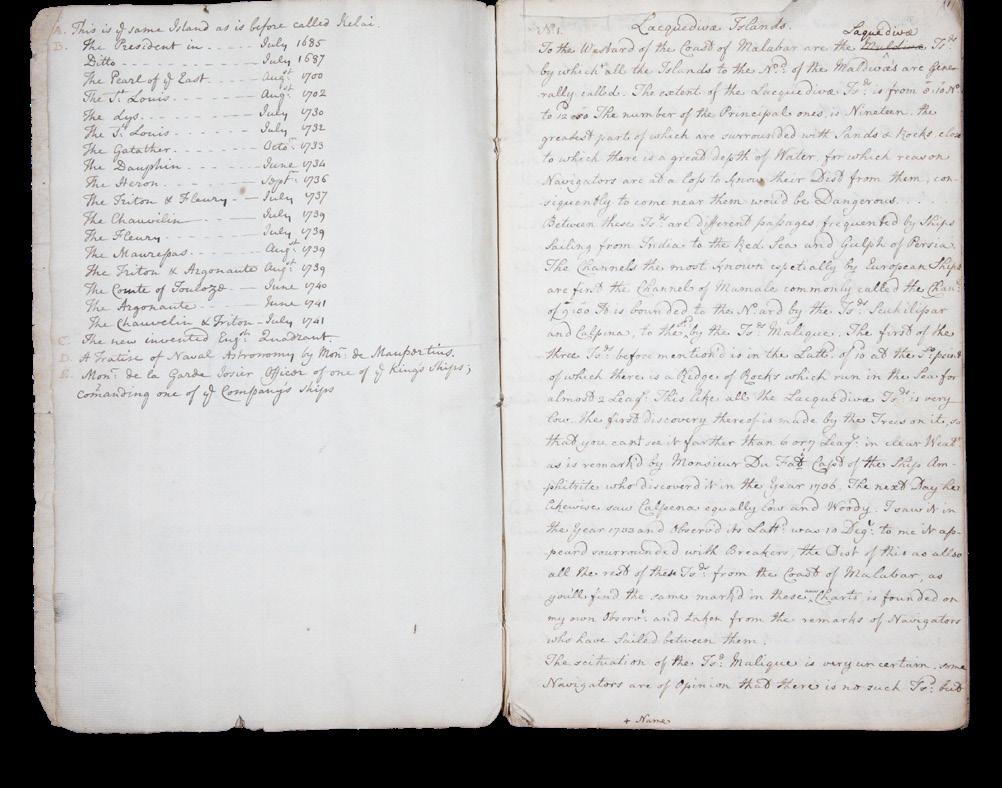
in 1765) the Falklands as “the Key to the whole Pacifick Ocean”. Byron named Port Egmont, in the Falklands, for him in 1765.
In some measure the Admiralty effectively cut the plan in half, sending Byron on the Dolphin , accompanied by the smaller Tamar, to reconnoitre the Pacific in mid-1764, following up the next year by sending out a three-ship expedition, under Capt. John MacBride, to actually settle the Falklands: the ships, Jason and Carcass, in convoy with the storeship Experiment, anchored in Port Egmont in January 1766. The Proposal is thus very like not only what Byron and MacBride were soon ordered to do, but also what their successors Wallis, Carteret and Cook would continue, while also seeming to have been explicitly tailored to the aspirations of Egmont and the Admiralty.
Over the last two decades a number of researchers have made extensive investigations into the likely authorship. Despite quite intensive study, the identity of its creator remains anonymous. As the more detailed notes we have assembled make clear, it is easier to discount likely authors than make a firm attribution. We know that the writer had direct access to the latest information on the Pacific and Indian Oceans from the private reports of the East India Company. Despite his connection with the Company, he cannot have been in the ranks of the government or the navy, nor was he even anxious to preserve the power of the East India Company, as the report is full of hostility towards monopolies.
Despite the references to John Campbell’s revision of Harris’s Navigantium, Campbell cannot have written the Proposal. Nor is it likely to have been written by some of more obvious names of the era, such as the hydrographer and East India Company official, Alexander Dalrymple; nor the South Seas Company factor Henry Hutchinson or his son (also Henry); certainly not Lord Anson himself, given he died in 1762. The solution seems more likely to lie in the two-way traffic then abounding among old East India hands: someone like the experienced East Indies officer Admiral Richard Kempenfelt (1718-1782); the enthusiast for a British outpost in Chili, Alexander Wright; or even the East India Company skipper William Nichelson, mentioned several times in the manuscript accompaniments. The reliance on his journals is obvious, and this is precisely the sort of scheme that many a Pacific and Indian Ocean expert was not only well-placed to write, but to be vouchsafed a rare opportunity to get it in front of the great and the good. One thinks of Quiros with the King of Spain, Dampier petitioning on the need to settle Darien, Anson trying to work out a plan that would further British interests without bringing on a war with Spain, or the Endeavourveteran Magra proposing to settle New South Wales.
Further discussion appears on our website, and a longer essay may be had on request.
$365,000
5001130 at hordern.com
ADB; Harris, ed. Campbell, Navigantium atque Itinerantium Bibliotheca (1744-1748); Dalrymple, ‘Memoirs’ (1802); Dunn, A New Directory for the East Indies… Fifth Edition… (1780); Frost, ‘Report on the Manuscript of the East India Company Sailing Master’ (unpublished; 2006); Frost & Williams, ‘The beginnings of Britain’s exploration of the Pacific Ocean in the eighteenth century,’ pp. 410-418; Fry, Alexander Dalrymple (1970); Gallagher (ed.), Byron’s Journal of his Circumnavigation (1964); Nichelson, A Treatise on Practical Navigation and Seamanship (1796); ODNB; Royal Archives Online; Sainty, Admiralty Officials, 1660-1870 (1975); Thomas, George III: King and Politicians (2002).
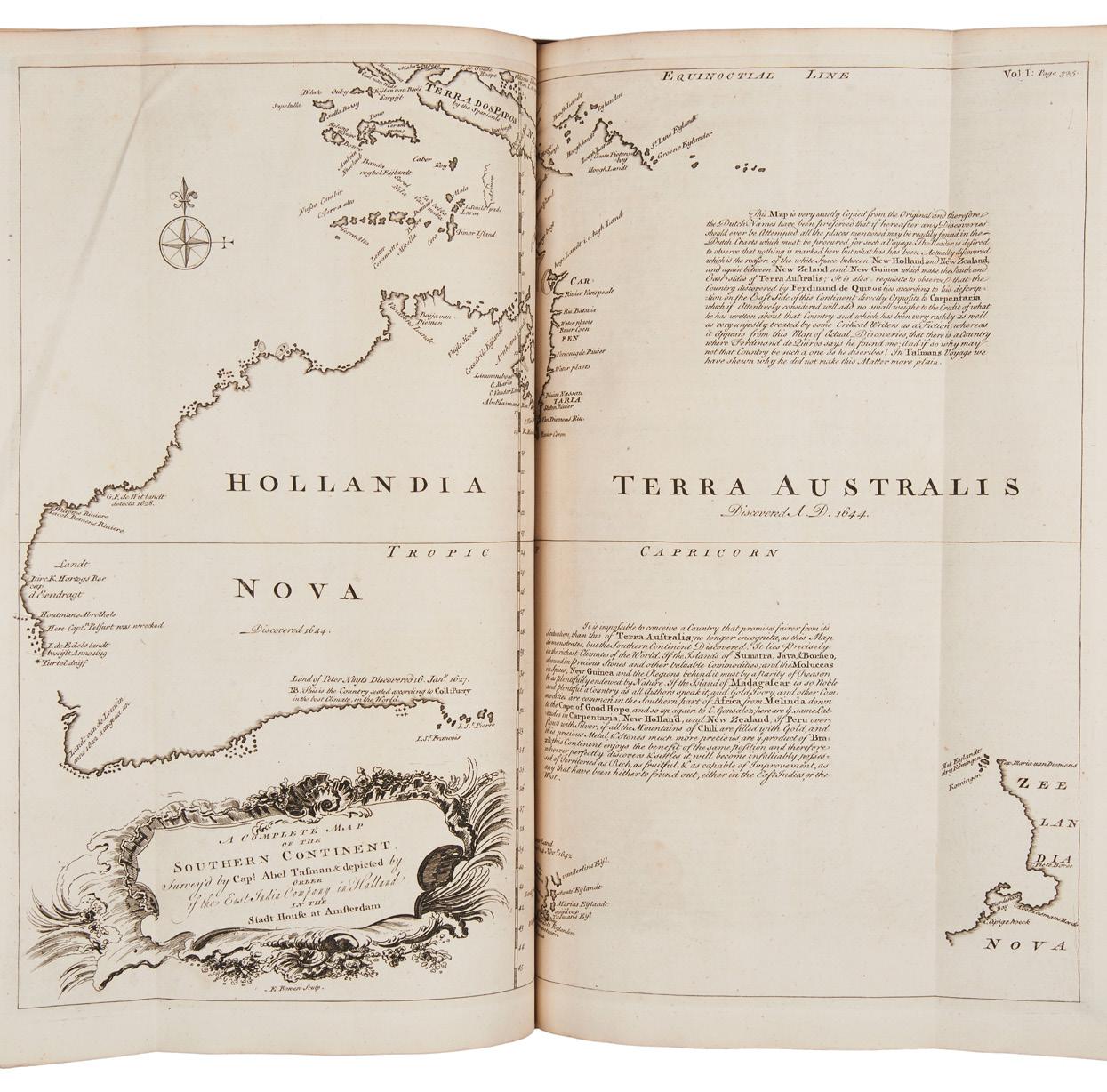
The great Bowen/Tasman map of the Southern Continent, published in Campbell’s revised edition of John Harris’s collection of voyages, 1764 (see catalogue no. 20). We know that the author of the Proposal made use of material in the Harris collection.
A Narrative of the Expedition to Botany Bay.
With an Account of New South Wales, its Productions, Inhabitants, &c. To which is subjoined, A List of the Civil and Military Establishments at Port Jackson.
Octavo in fours, complete with the half-title leaf and the final advertisement leaf; a superb copy in completely original condition, uncut in the original plain blue wrappers with an unlettered buff paper spine; quarter morocco case.
London, J. Debrett, 1789.
First edition of the first authentic and surely the most widely read and the most quoted of the First Fleet books: this is an exceptional copy in remarkable condition, as issued, absolutely complete and in the original plain blue wrappers, just as it would have come from the presses in the first days of April 1789.
Not only a standard work but now a recognised classic of Australian literature of any stripe, Tench’s book has been called “at once the most perceptive and the most literary of the contemporary accounts” (ADB). Few writers have matched the directness of his description of life in the first days of the colony and none his talent for eyewitness reportage.
Tench (1758-1833) had joined the Royal Marines in 1776 and served in the American Revolutionary War. Like many of his peers, he had been at home on half-pay for a few months when he volunteered for New South Wales. Well-read and well-connected (especially in theatrical circles), the evidence suggests that he had a publishing deal with Debrett’s even before he sailed, writing this free-ranging and insightful account explicitly for publication.
Apart from its importance as the first genuine description of the new colony, Tench’s narrative provides us with the clearest of the surviving images of the first crucial months of settlement. He signed the preface “Sydney Cove, Port Jackson, New South Wales, July 10, 1788,” just before the first ships sailed for home.
When they arrived in England there was a minor rush among publishers to print detailed and “authentic” notices of life in Botany Bay, as the new colony was still usually called. It has now been conclusively shown that Tench’s book was being advertised in the press within days and was actually being sold by 4 April, a scant fortnight after the ships returned, for the relatively modest price of 3s. 6d.
Tench’s Narrative has proved to be one of the more difficult of the First Fleet books to find, particularly with both the first and final leaves (half-title and advertisement) present, both often discarded by binders. This copy remains in the publisher’s simple wrappered binding, representing a rare opportunity to acquire this important work in the way Tench’s contemporaries would have read it.
$24,000
5001134 at hordern.com
Crittenden, ‘A Bibliography of the First Fleet’, 222; Ferguson, 48; Hill, 1685; Mabberley, Peter Crossing Collection, 18; Wantrup, 2.
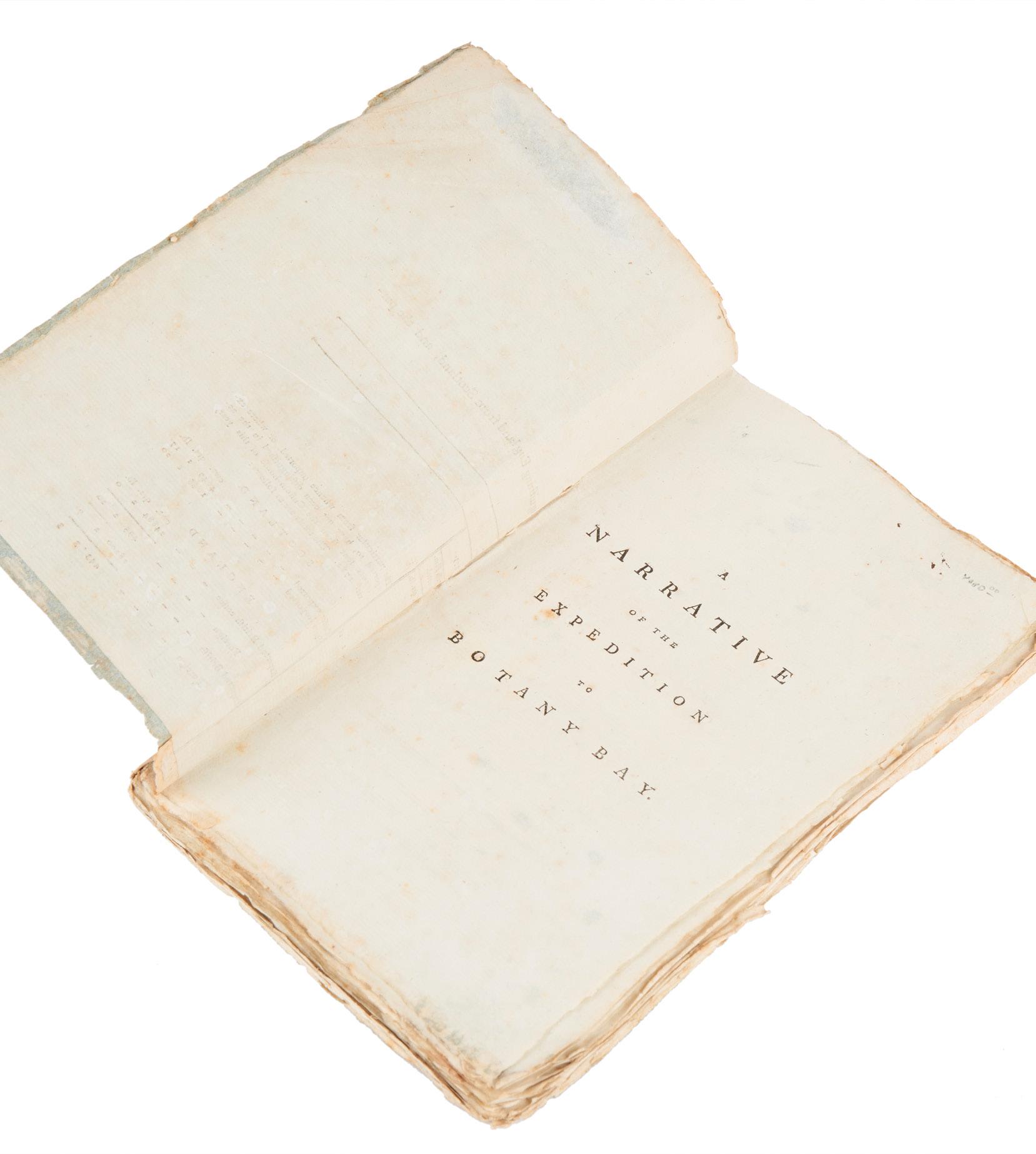
A Complete Account of the Settlement at Port Jackson, in New South Wales, including an Accurate Description of the Situation of the Colony; of the Natives; and of its Natural Productions: taken on the spot, by Captain Watkin Tench, of the Marines.
Quarto, with a folding map; a good copy in contemporary marbled calf, spine renewed to style. London, G. Nicol and J. Sewell, 1793.
Scarce first edition of one of the canonical First Fleet accounts, the second of Tench’s two books, in an “accurate, well-written and acutely observed account of the earliest years of Australia’s colonization” (Wantrup). After nearly four years in New South Wales, Tench ultimately left with the other marines on 18 December 1791 aboard HMS Gorgon which had accompanied the Third Fleet, and this book was published in late June 1793, roughly a year after his return.
The fine folding engraved “Map of the hitherto explored Country, Contiguous to Port Jackson: Laid down from Actual Survey”, printing the results of recent explorations, provides an excellent survey of known lands, detailing Botany Bay and Broken Bay along the coast and inland to the Nepean river, with numerous engraved notes on the landscape with a view to future farming and grazing ventures. “Where the other First Fleet journalists described the excursions and expeditions of others, Tench published selections from the actual journals kept on his own expeditions. He was the first Australian explorer to do so. Tench and his travelling companion, William Dawes, have been described as the first systematic explorers, which gives an added point to his being the first to print extracts from his ‘Travelling Diaries in New South Wales’” (Wantrup).
Tench’s well-crafted book paints a comprehensive view of daily life in the settlement through years of hardship and severe shortages. An understanding and intelligent observer of human nature, his account has been praised as the most insightful and detailed description of the social fabric of the penal colony, in contrast to other more formal and official narratives.
There is a detailed account of the First Nations people, with attempts to note their society and language, abundant “with vowels… mellifluous and sometimes sonorous”, noting that Mrs Johnson, wife of the Chaplain, had named her daughter Milba, taken as she was with the indigenous name [pp 178-204]. Tench also describes his significant explorations of the landscape of the Sydney basin and forays into the Blue Mountains, while providing sympathetic descriptions of their contact with the Eora people.
$11,500
5001133 at hordern.com
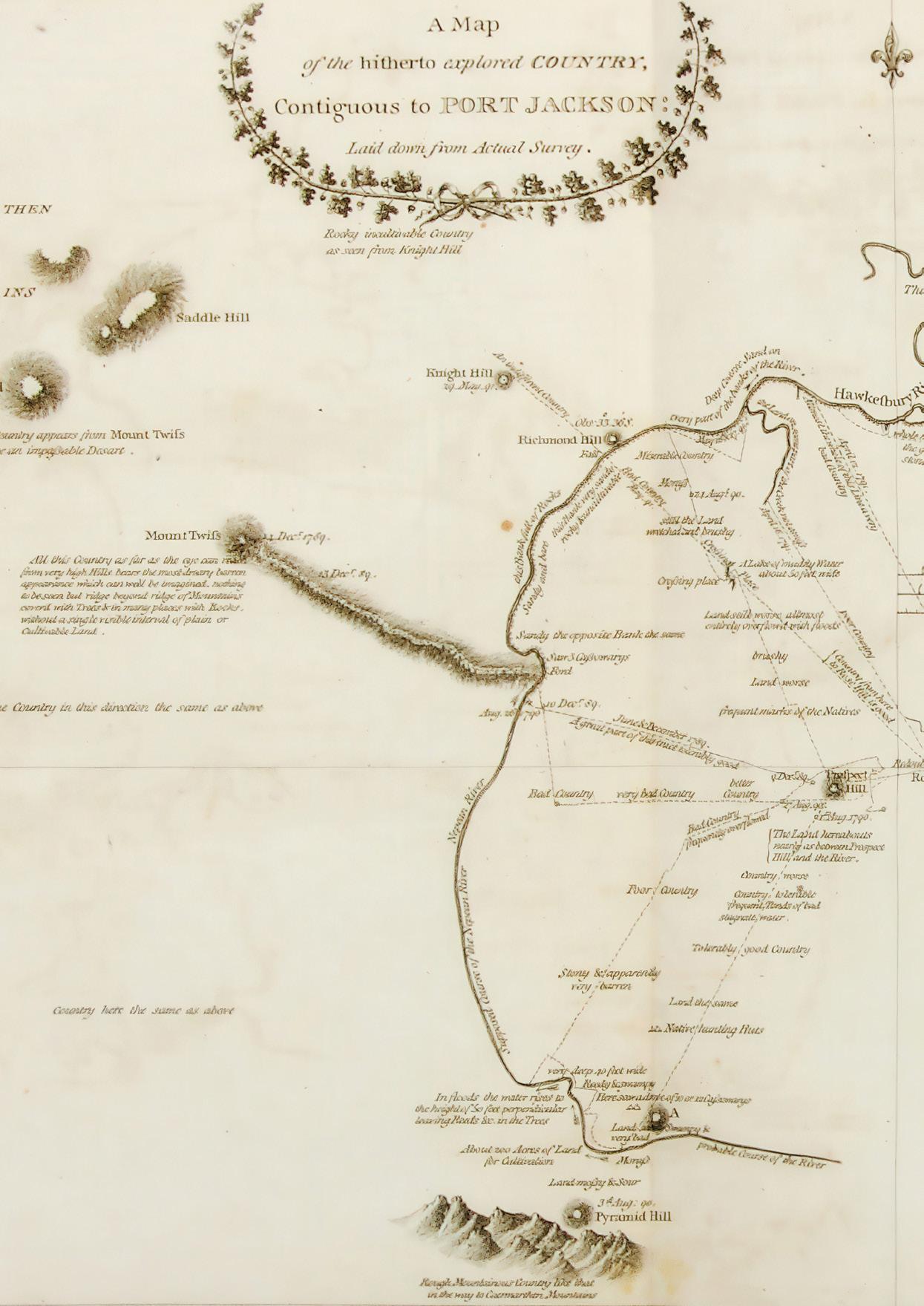
A Voyage of Discovery to the North Pacific Ocean, and round the world… in the Discovery sloop of war, and armed tender Chatham, under the command of Captain George Vancouver. Three volumes, quarto, with 18 engraved plates of views; separate folio atlas with the 16 large plates of charts and views, with the scarce half-titles; a handsome set. London, Printed for G.G. and J. Robinson… and J. Edwards, 1798.
First edition of this great voyage account, complete with its large and important atlas, of ‘one of the most important voyages ever made’ (Hill), significant for re-asserting British trading rights on the Northwest Coast and for discovery and cartography of the south-west coast of Australia. The most important British voyage to the American west coast after Captain Cook, and a foundation work for California, the Northwest Coast, and Hawaii, it was ‘one of the most important voyages for the history and the cartography of the Northwest Coast in general and of Alaska in particular’ (LadaMocarski). In 1790 Vancouver was given command of an expedition whose express purpose was to reclaim British rights to the Northwest Coast following the Nootka convention. He was also to re-examine the existence of a navigable passage from the Atlantic to the Pacific, and this voyage permanently laid to rest that theory. The artist on the voyage was John Sykes; the engravings here, after his drawings, include the first published views of California.
George Vancouver (1757-1798) got his early training as a midshipman and later lieutenant on Cook’s second and third voyages. After his return he spent most of the 1780s in West Indian waters, before being appointed, in 1790, to the command of a major scientific expedition to focus on the northwest Pacific: the successes of Cook’s voyages were much in mind in the planning of this expedition, and it was no coincidence that Vancouver’s new command was named Discovery, explicitly in honour of the vessel of that name that had sailed on Cook’s third voyage. Vancouver sailed to the Pacific by way of Australia where, in 1791, he made landfall on the then largely unknown south-west coast and discovered and named King George III Sound (modern Albany). This was the first English visit to any part of the west coast since Dampier, whose poor reports had led to the neglect of that part of the continent. Indeed, the west was explicitly excluded from Governor Phillip’s otherwise extensive realm, with the western boundary of his authority stopping at the famous “Pope’s line”, the line that still constitutes the inland border of Western Australia.
After leaving the south-west coast, Vancouver unsuccessfully attempted to enter the Great Australian Bight, discovering and charting Point Hood on its western extremity. He then sailed past Van Diemen’s Land into the Pacific, visiting New Zealand, Hawaii, and the Northwest coast of America. During the course of three seasons, he surveyed Alaska, the Northwest Coast, investigated the Straits of Juan de Fuca, discovered the Strait of Georgia, and circumnavigated Vancouver Island. He visited San Francisco, Monterey and other Spanish Settlements in Alta California, and made three visits to the Hawaiian Islands where he introduced cattle from Monterey. The expedition’s storeship Daedalus sailed twice to Port Jackson, to deliver cattle and stores for the colony and despatches for Phillip – including Vancouver’s charts of the southwest coast of Australia – and others for transmission back to London. Daedalus also

collected such stores as were available at Port Jackson for the expedition. Vancouver also mentions that his ship was carrying breadfruit for planting at Norfolk Island.
Cook would have approved of the accuracy of Vancouver’s charting, which survived almost unchanged into modern times, and certainly Vancouver had learned the lessons of long voyages from his old captain, with only five men of a complement of 180 being lost in over four years at sea. But it is also true that by 1794 Vancouver was subject to wild mood swings and erratic behaviour which led to him being feared and sometimes mocked by his men (in modern times it has been argued that he was suffering from some form of hyperthyroidism, possibly Graves’ Disease). His health was ruined by the time they returned to England in 1795. He retired to Petersham to prepare this publication for the press, but in an eerie foreshadowing of the fate of his successor Flinders, died at age 40 while the account was nearing publication.
$48,000
6000002 at hordern.com
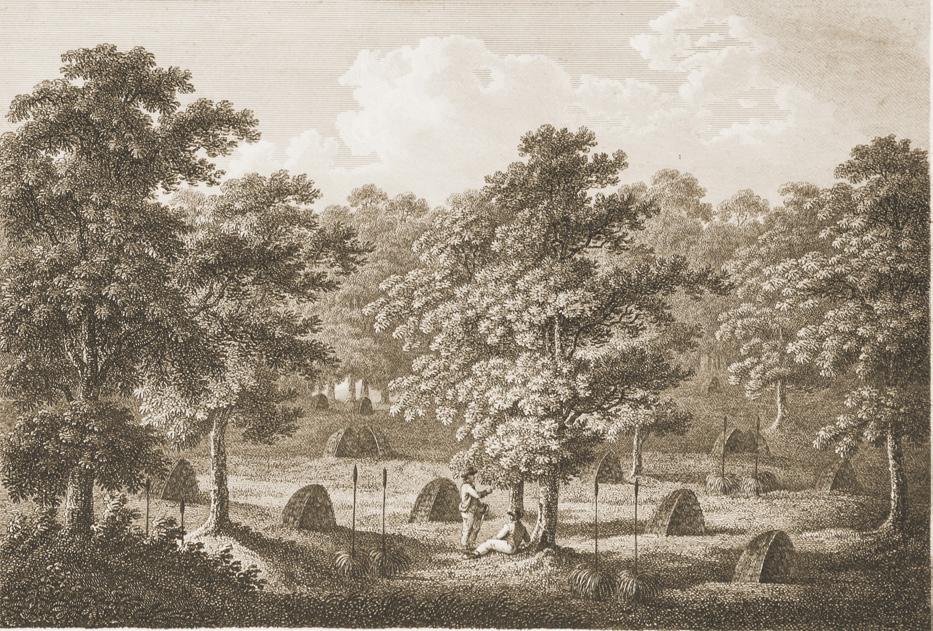

An Historical Account of the Colony of New South Wales.
Folio, with a map and 12 engraved plates, six of them large and folding, the other six full-page; complete with the half-title and the preliminary leaf (not always present) containing extracts from the Sydney Gazette ; a very good copy with large margins in a fine russia leather binding by Aquarius. London, Rudolph Ackermann, 1821.
One of the most important of all Australia’s early illustrated books. This is a very good copy of the first view book engraved in Australia, an extraordinary collaboration between Major James Wallis, then commander of the convict settlement at Newcastle, and the convicts under his command, notably the artists and engravers Joseph Lycett and Walter Preston. The illustrations for Wallis’s celebrated and beautiful view book show in great detail scenes in Sydney, Newcastle, and the Hawkesbury River, as well as kangaroos and black swans and a justly famous scene depicting an Aboriginal corroboree. In many ways the series represents a celebration of the progress of the colony under Governor Macquarie, and Macquarie himself was very taken with the work.
They follow on the work of Absalom West who had issued his famous views of Sydney as separate engravings a few years previously. Wallis and West are further connected by the fact that the convict-engraver Walter Preston worked for both of them. The tradition is that he engraved Wallis’s views on the common sheet-copper used for the hulls of ships, no other material for plates being available in the colony at the time: softer than standard engraving copper, it was difficult to work.
Major James Wallis had arrived in New South Wales in 1814, the first of a number of military officers with a talent for drawing to come to the colony. He arrived with his Regiment, the 46th, on the same ship which brought Joseph Lycett as a convict. The two men were also later together in Newcastle, where Wallis ran the penal settlement between 1816 and 1818. Lycett had only recently been sent to Newcastle after his involvement in the forging of bank drafts in Sydney. At the time, Newcastle enjoyed a fearsome reputation for brutal secondary punishment, called “the Hell of New South Wales” by an earlier commanding officer.
There has always been speculation that Lycett may have been involved in the preparation of the drawings for this beautiful book. Bernard Smith in particular made the suggestion that it was Lycett and not Wallis who produced the original drawings, but this has been effectively disproved by the recent discovery of drawings by Wallis, who sometimes made use of a camera obscura.
Wallis was a successful commandant at Newcastle, transforming the shabby convict outpost into an ordered town, mirroring on a smaller scale what Macquarie had achieved in Sydney. Wallis was not a stern disciplinarian, yet seemed to motivate the convicts under his command by virtue of his own energy and enthusiasm. He focused the considerable artistic skills of the forgers to produce this series of skilled and remarkable views of the colony.

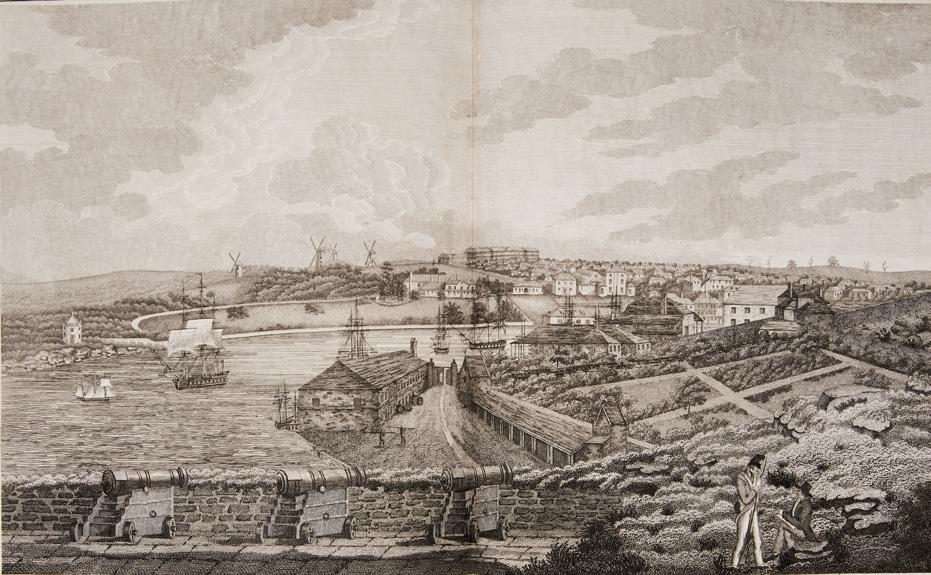
Both Preston and Lycett were pardoned by Macquarie on Wallis’ recommendation, in no small part because of their work on this book. When Wallis departed Australia in 1819 he took the plates with him to London where this book was published by Ackermann, complete with an introductory history of the colony and a map of Port Macquarie by the surveyor John Oxley. Roger Butler discusses the work and its context at length in “The Wallis Publication” in his Printed images in colonial Australia 1801-1901.
The views are as follows:
1. View of Hawkesbury and the Blue Mountains.
2. View of the Cove and Part of Sydney.
3. Sydney from the North Shore.
4. Sydney from Bennelong’s Point.
5. Newcastle, Hunter’s River.
6. Corroboree or dance of the Natives of N.S.W.
7. Black Swans… View of Reed’s Mistake River N.S.W.
8. Kangaroos.
9. View of Hunter’s River.
10. North and South Heads in Port Jackson.
11. Vaucluse Bay, Port Jackson.
12. View of Dawes Battery at the Entrance of Sydney Cove.
13. Map of Port Macquarie and the Newly Discovered River Hastings by J. Oxley.
$38,500
5001143 at hordern.com
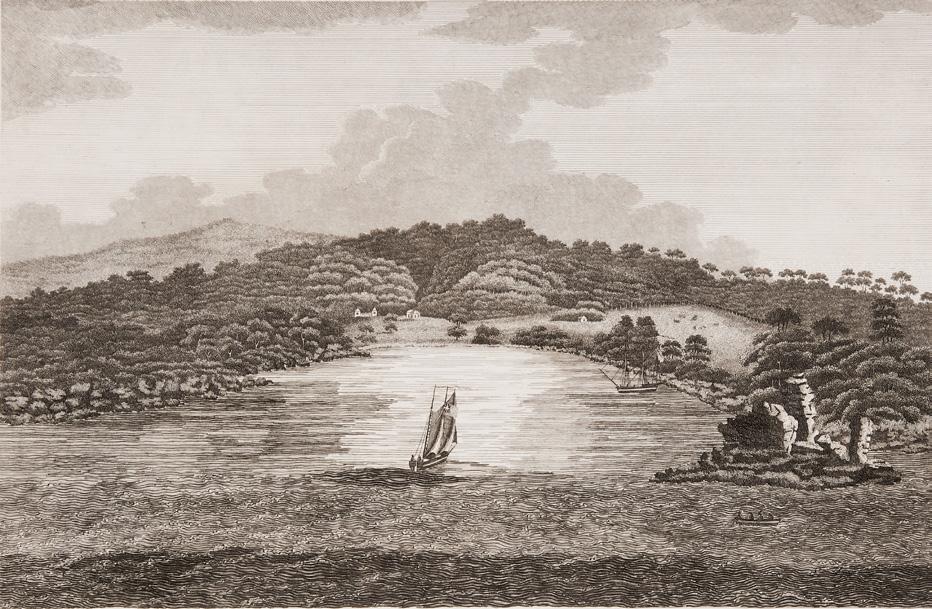

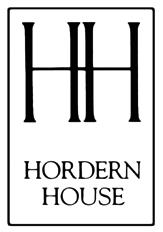
© First published in 2025 Hordern House Rare Books
Anne McCormick anne@hordern.com
+61 416 299 021
Rachel Robarts rachel@hordern.com
Derek McDonnell derek@hordern.com
+61 416 299 022
Rogerio Blanc-Ramos rogerio@hordern.com
Matthew Fishburn (consultant)
Anthony Payne (UK representative)
Mike Garabedian (US representative)
Design: Sevenpoint Design shay@sevenpoint.com.au
Hordern House Rare Books 46a Macleay Street, Potts Point, Sydney, NSW 2011 Australia www.hordern.com · rare@hordern.com · +61 2 9356 4411
